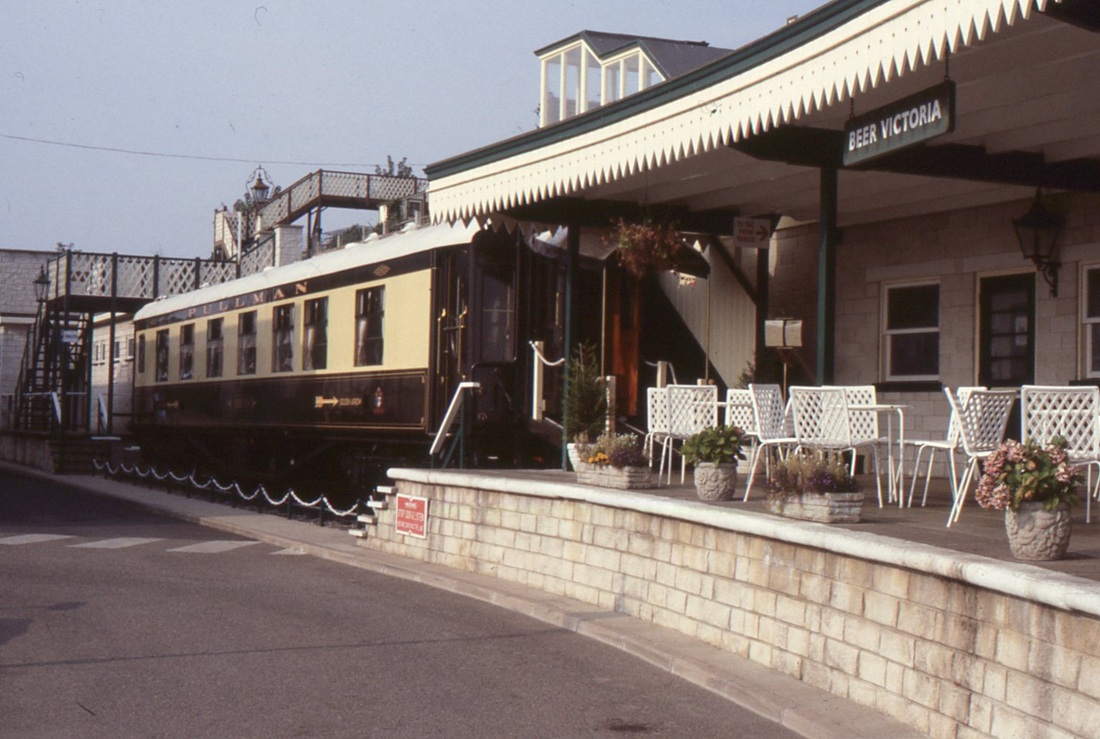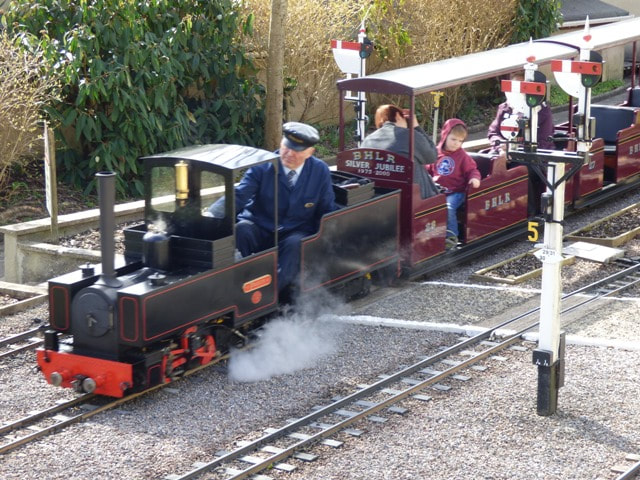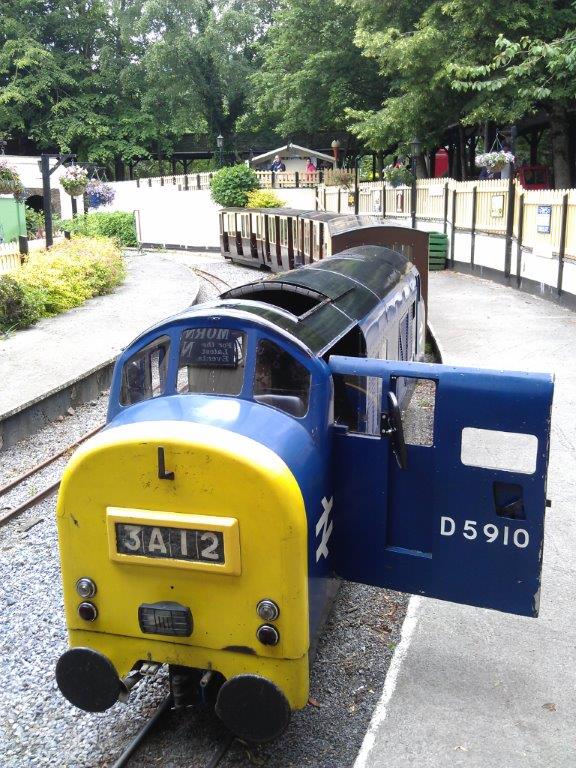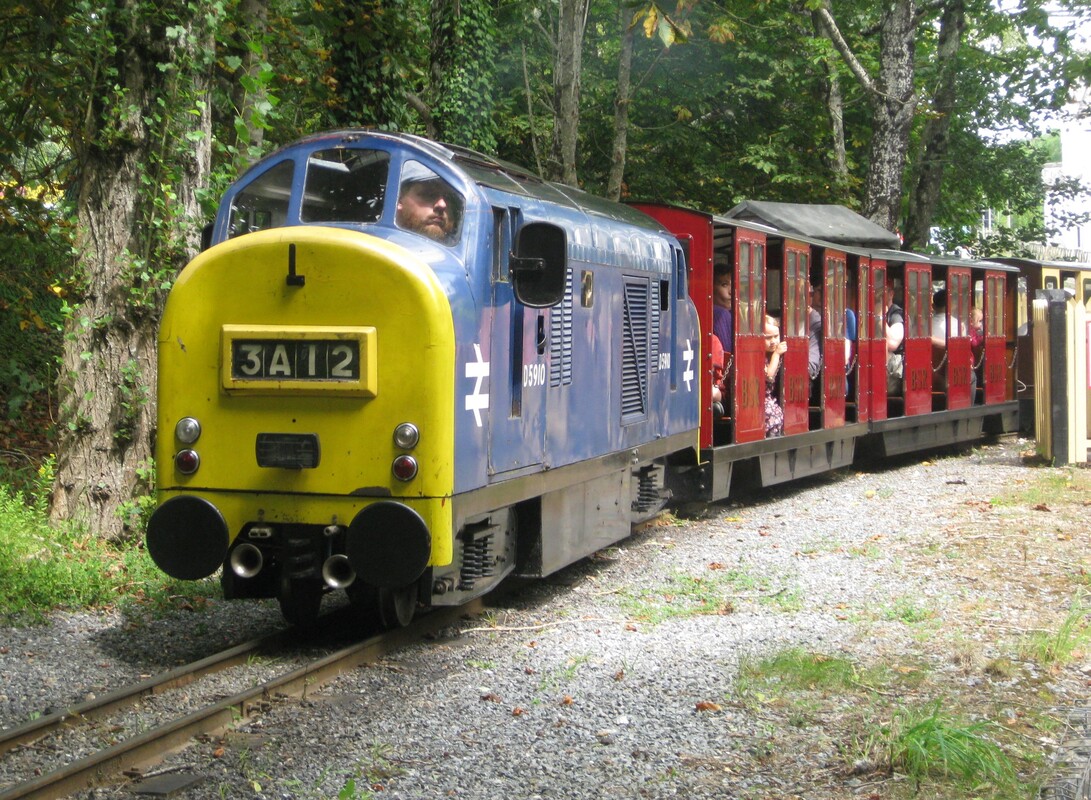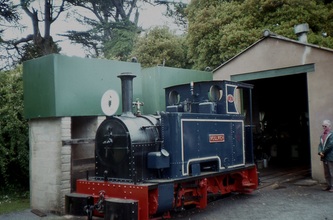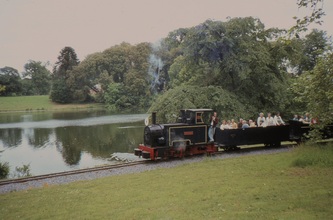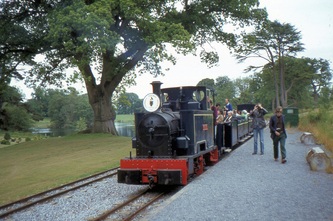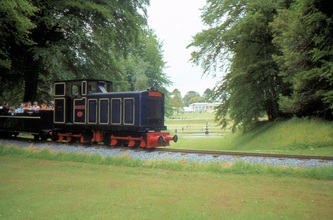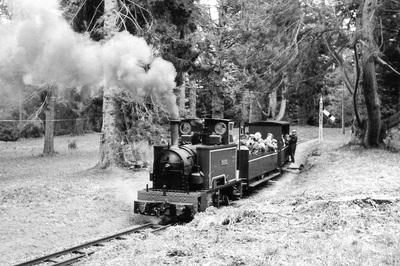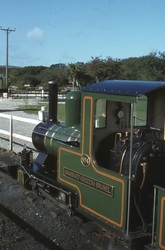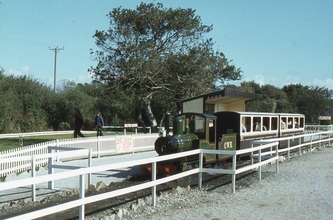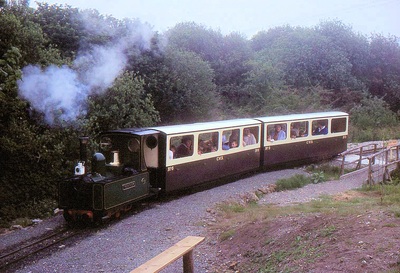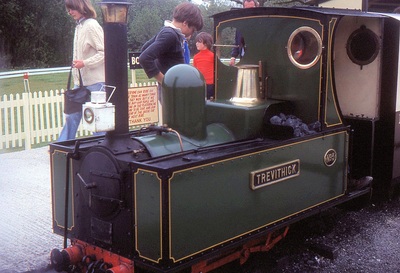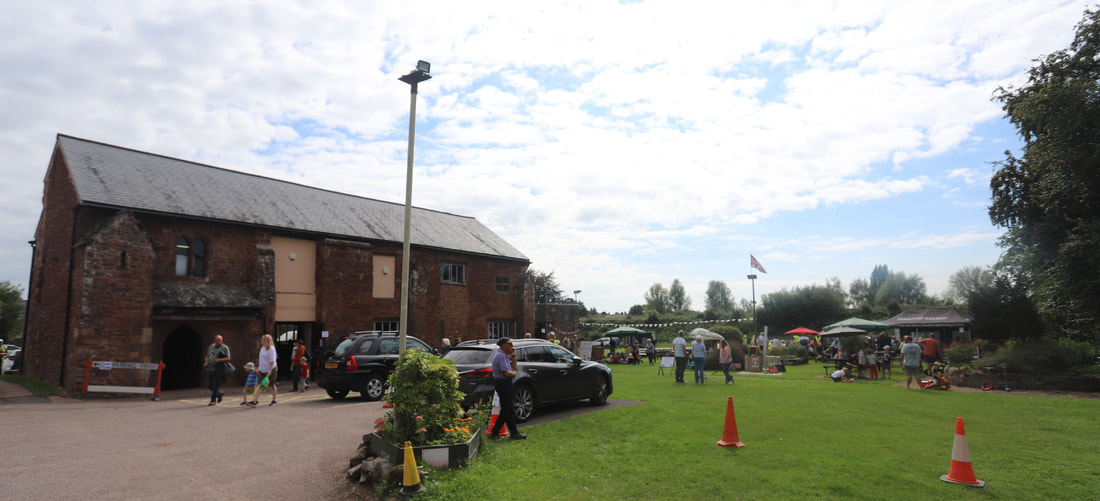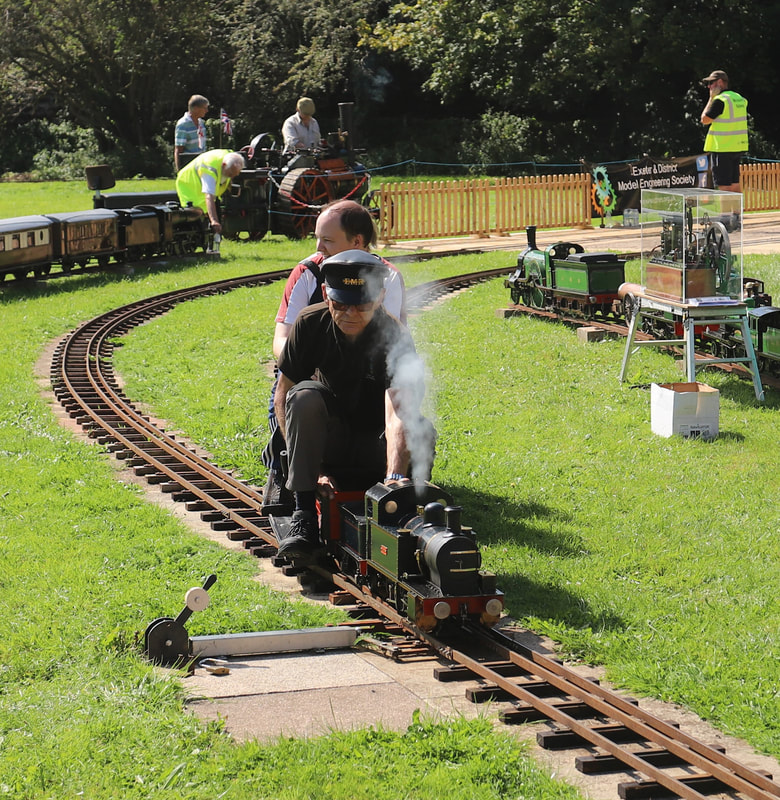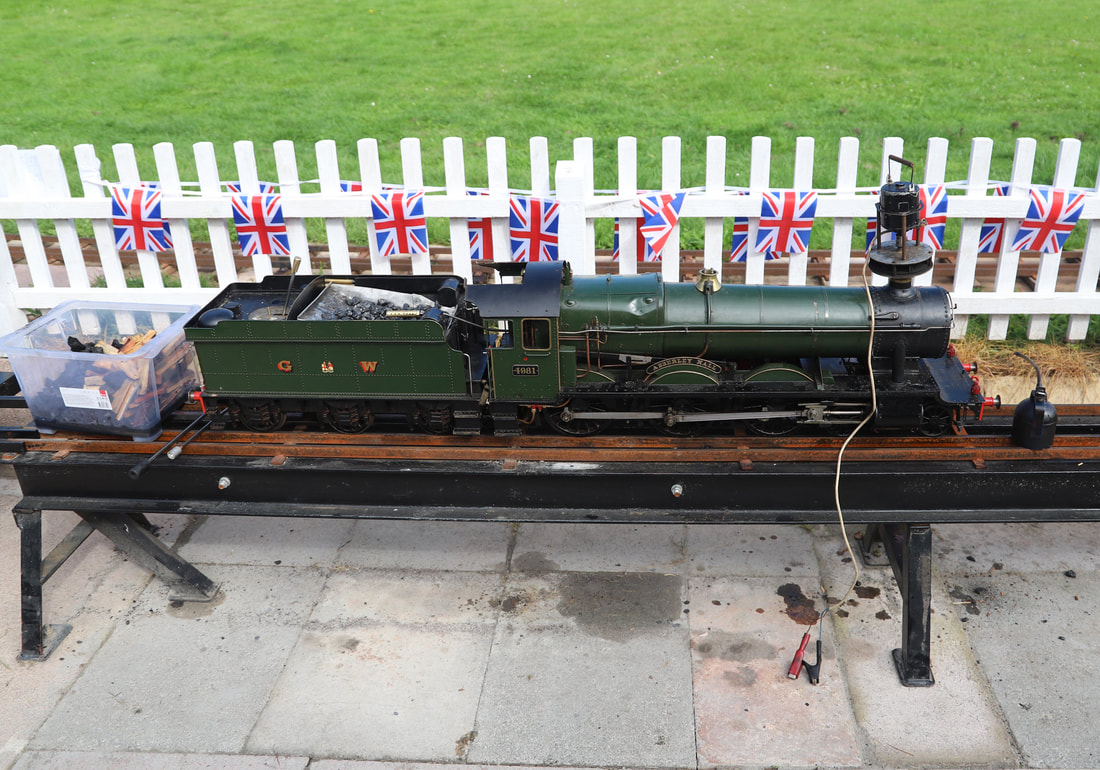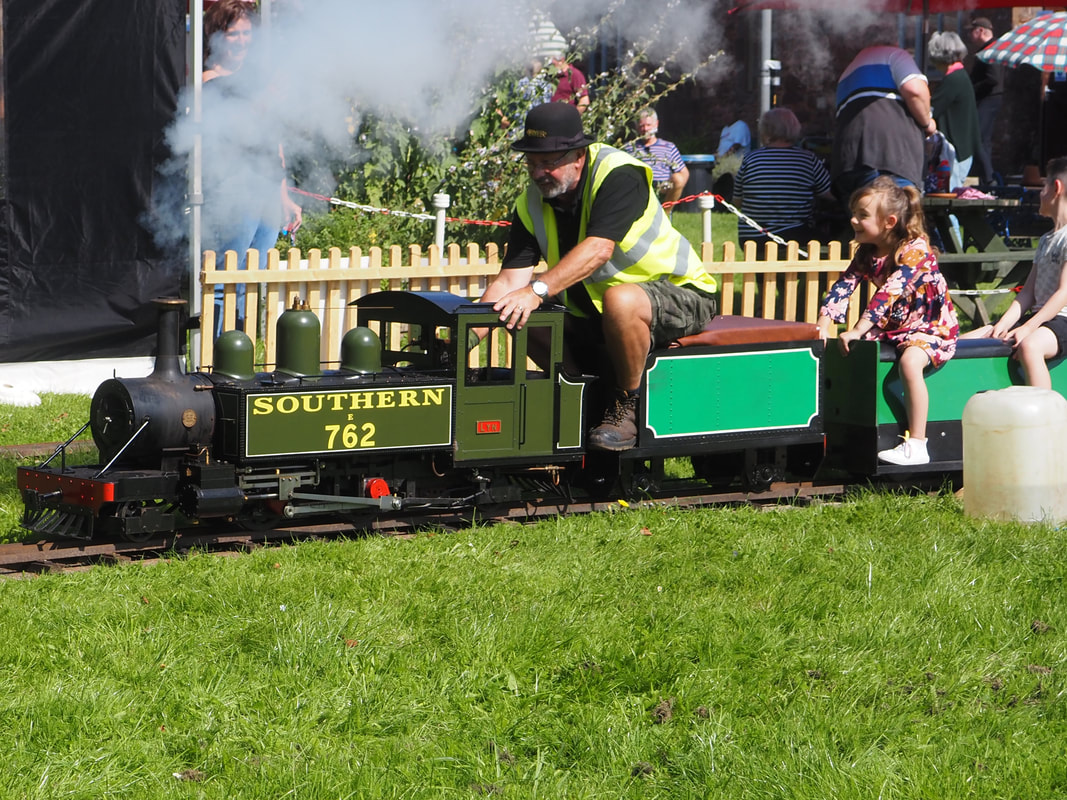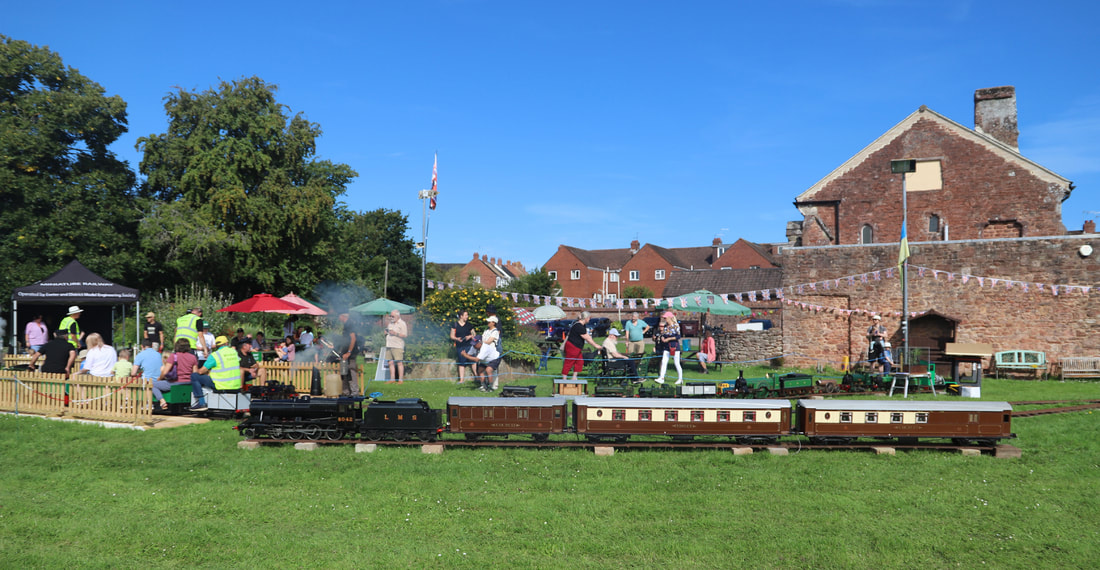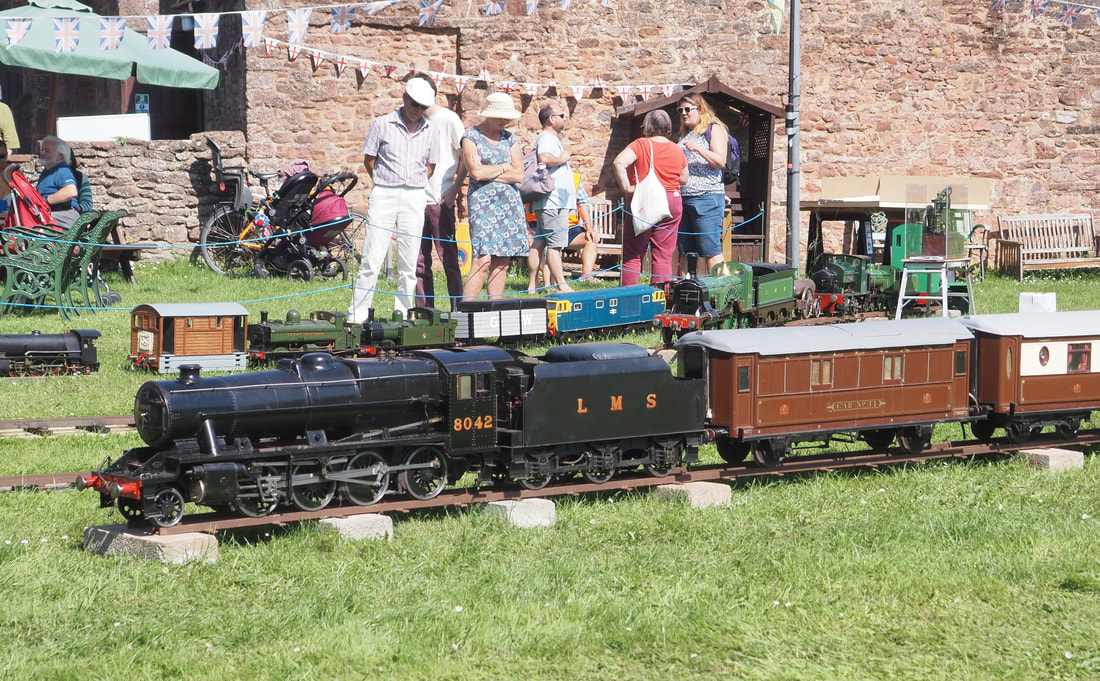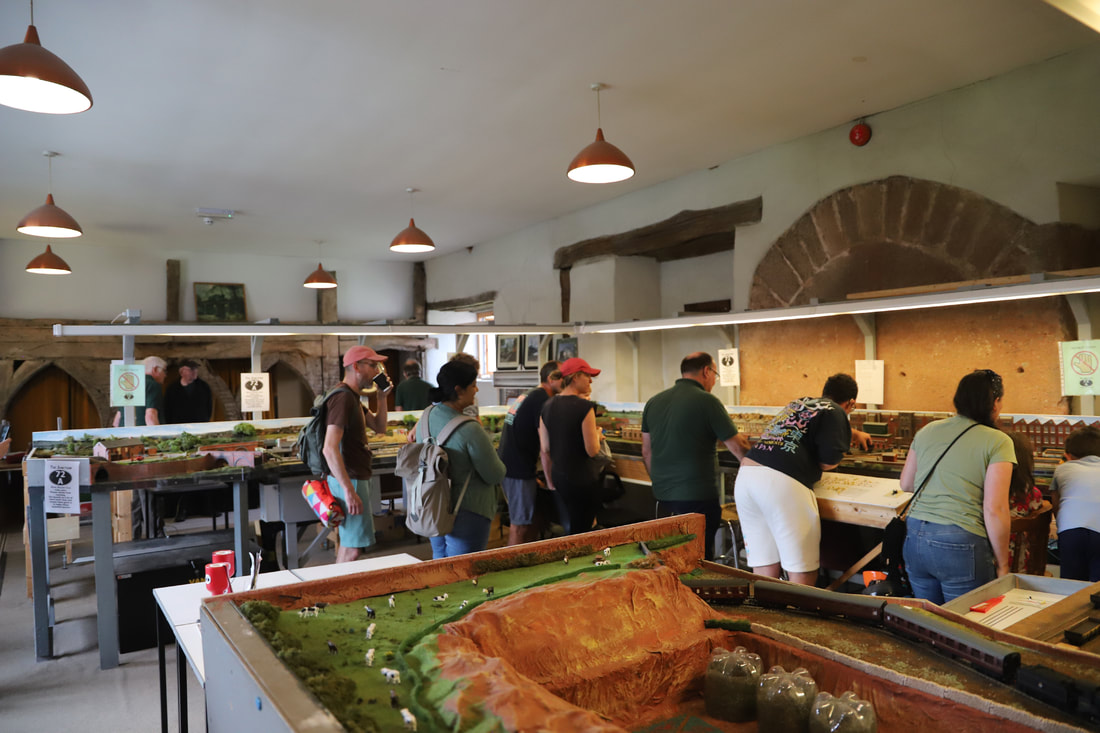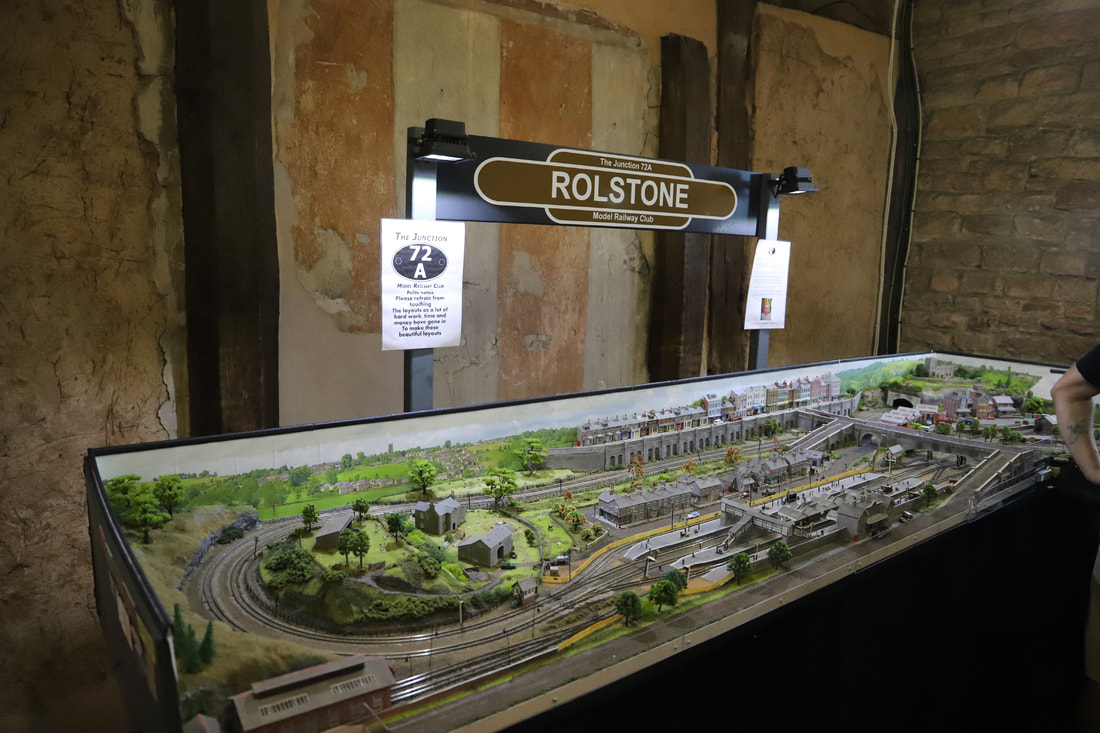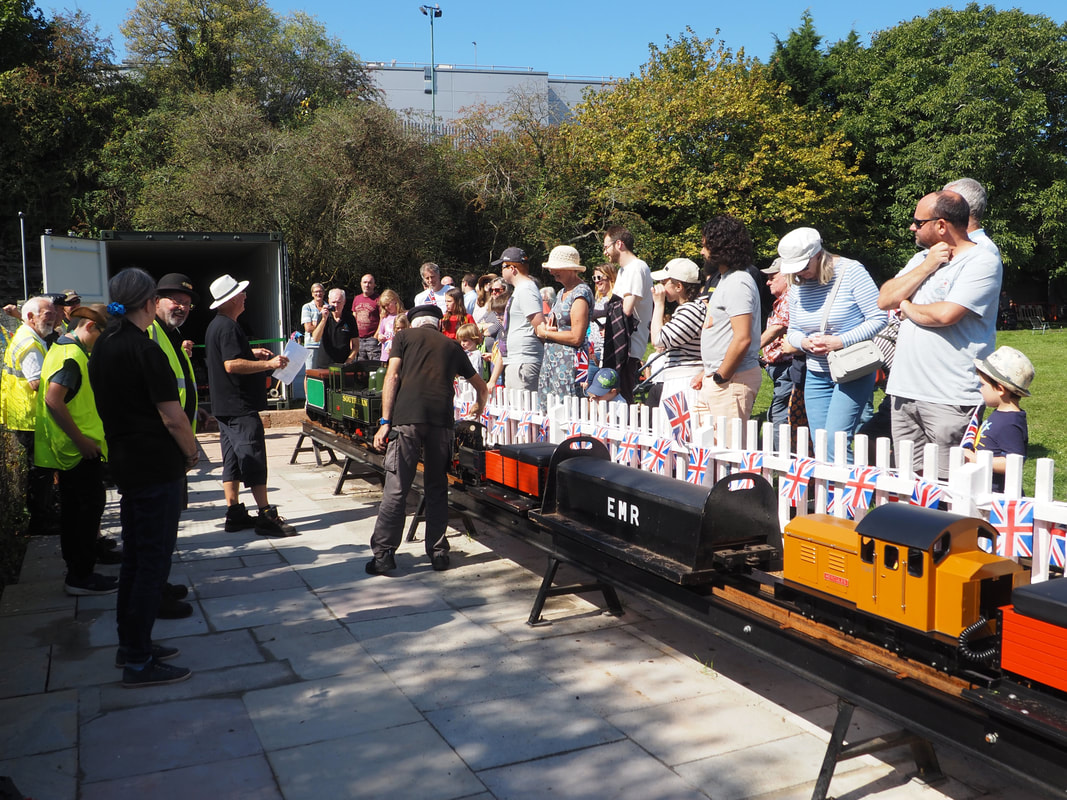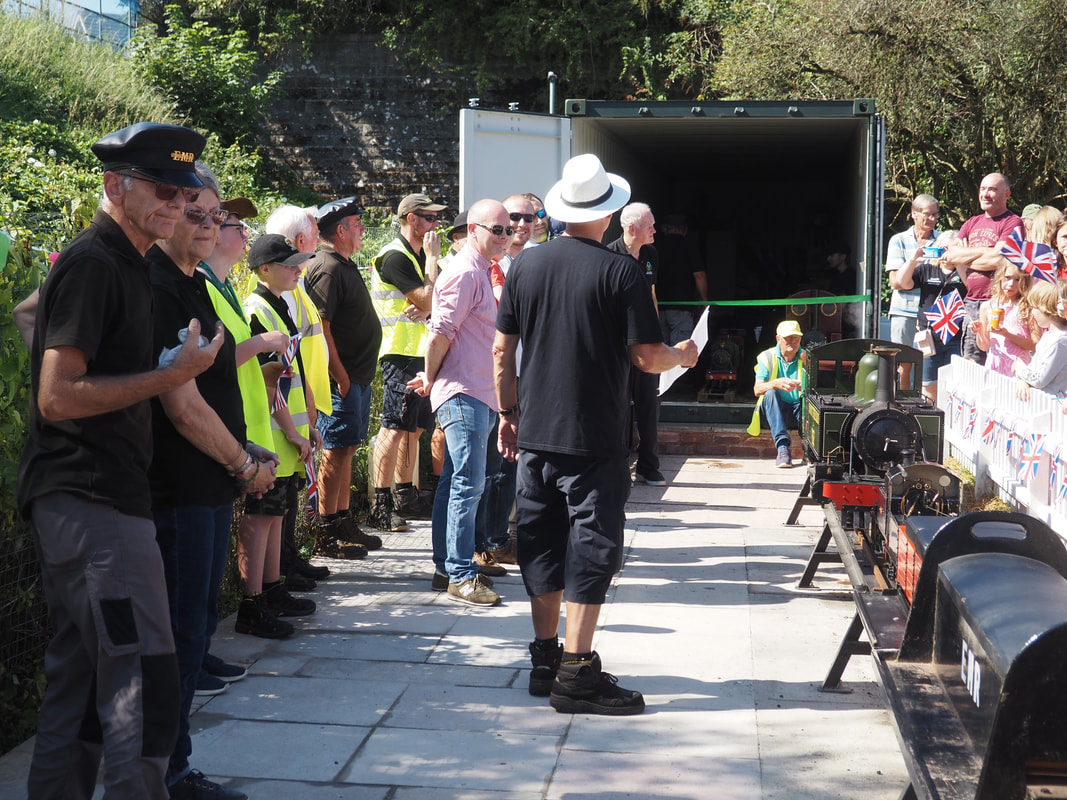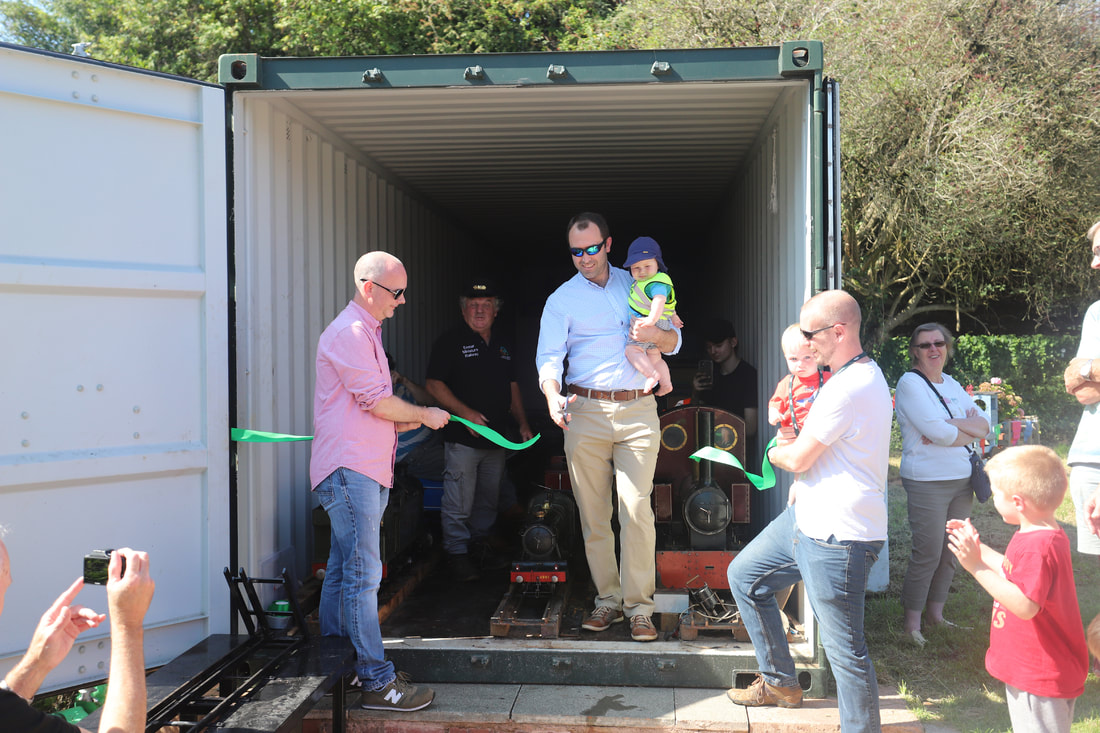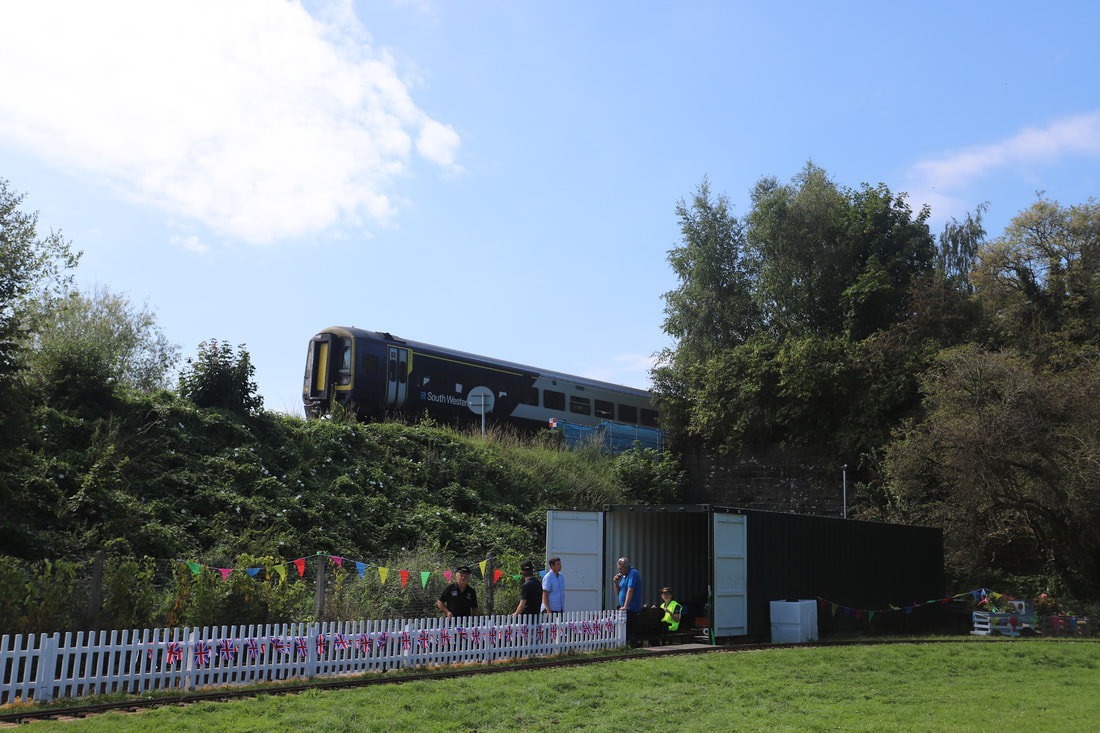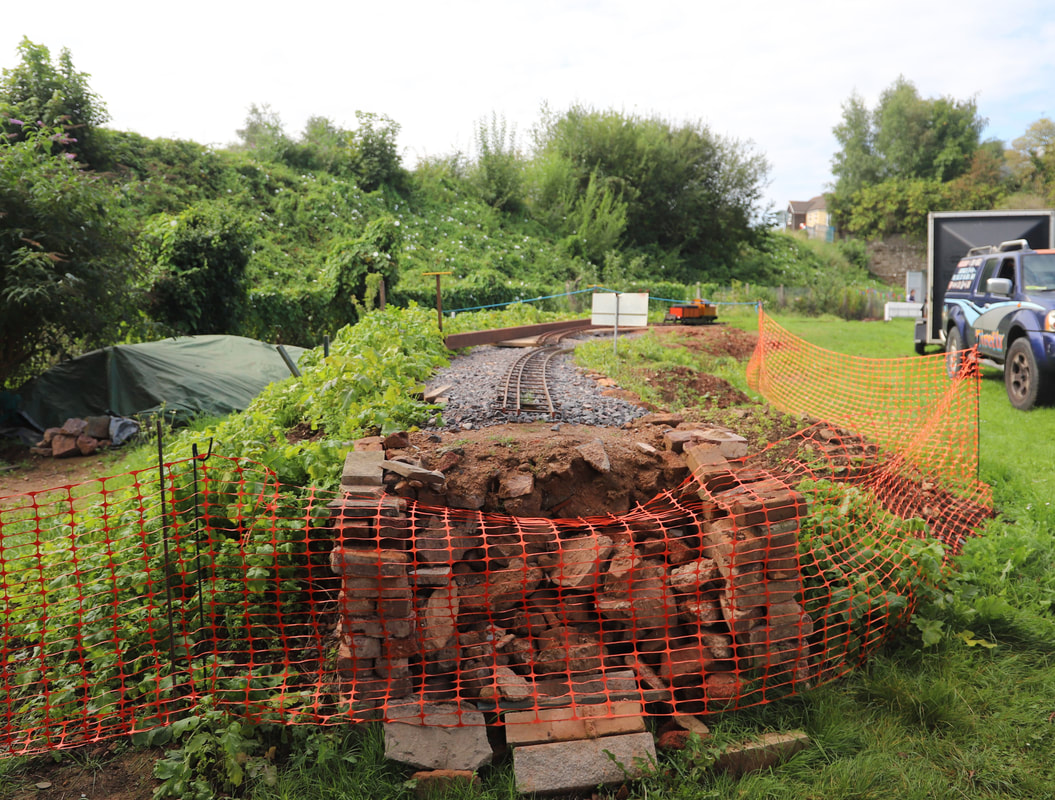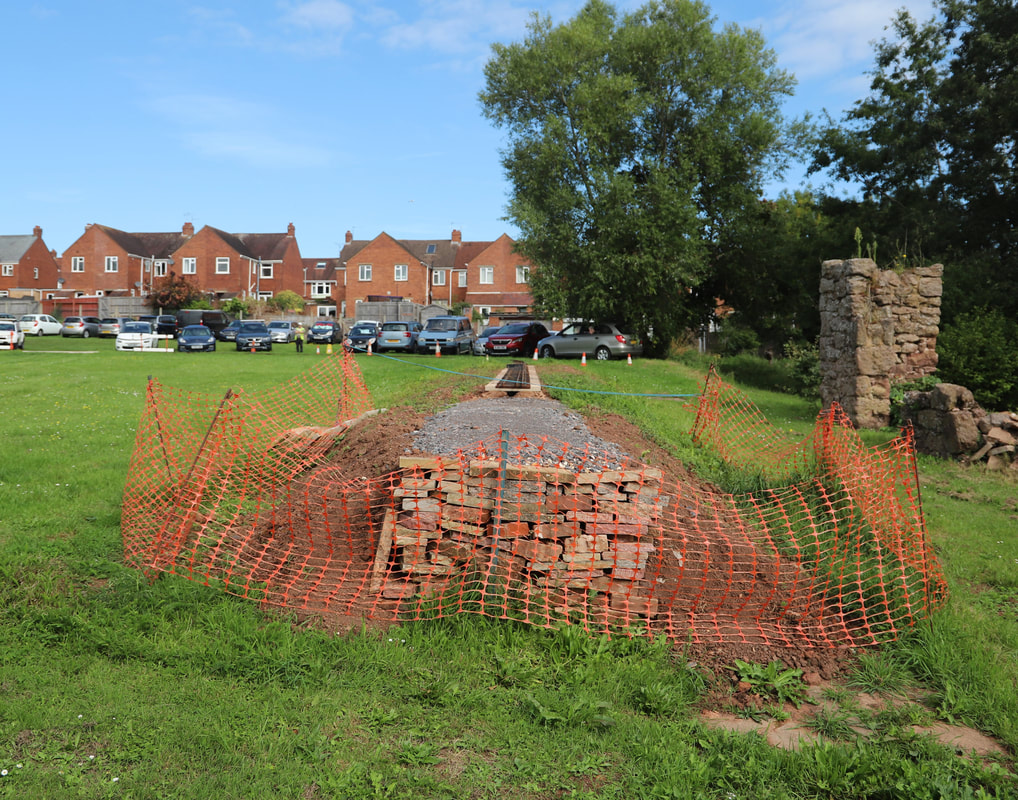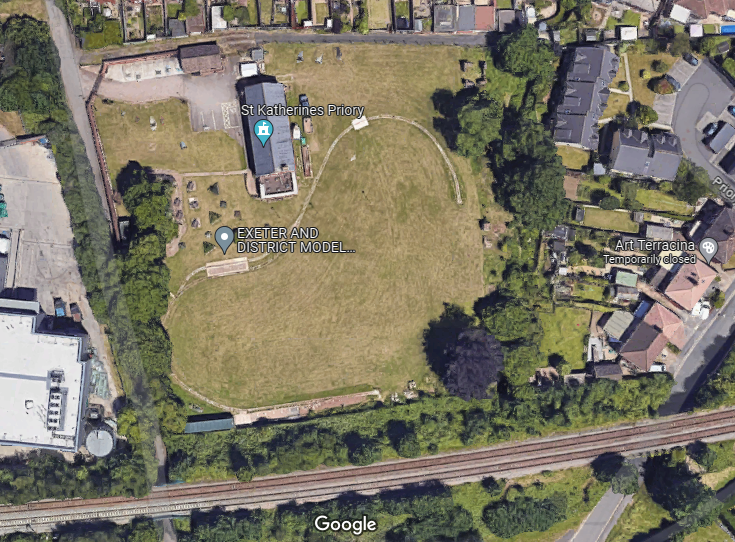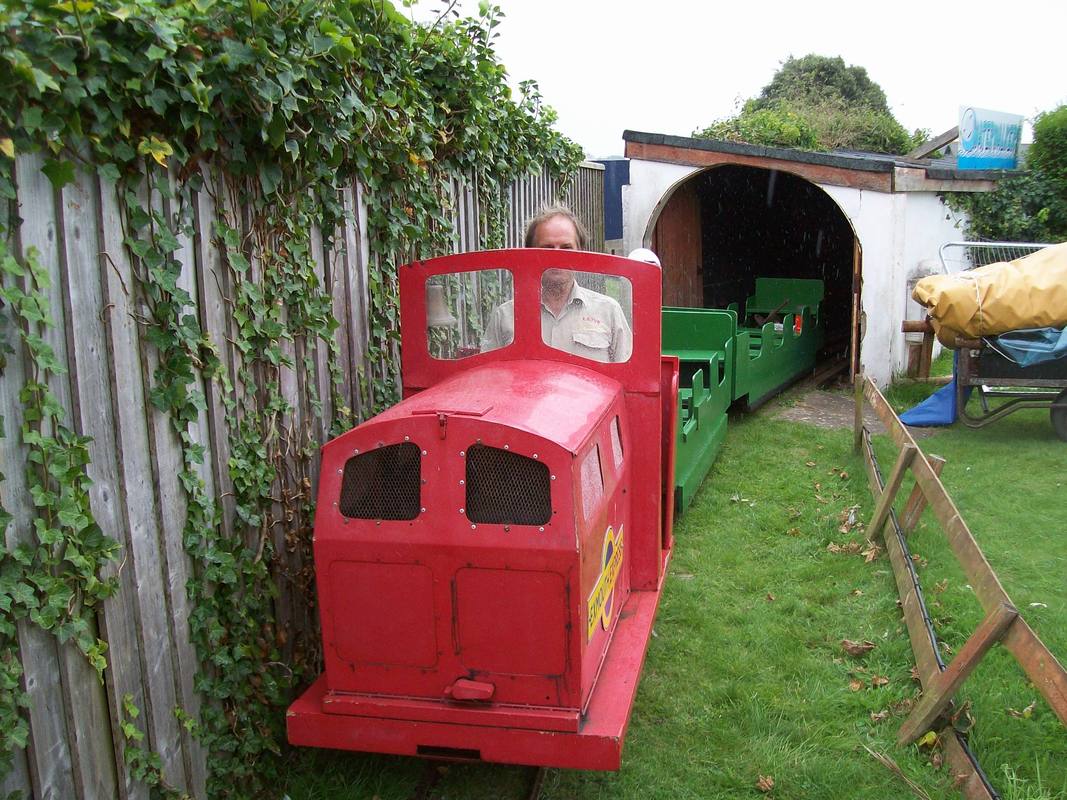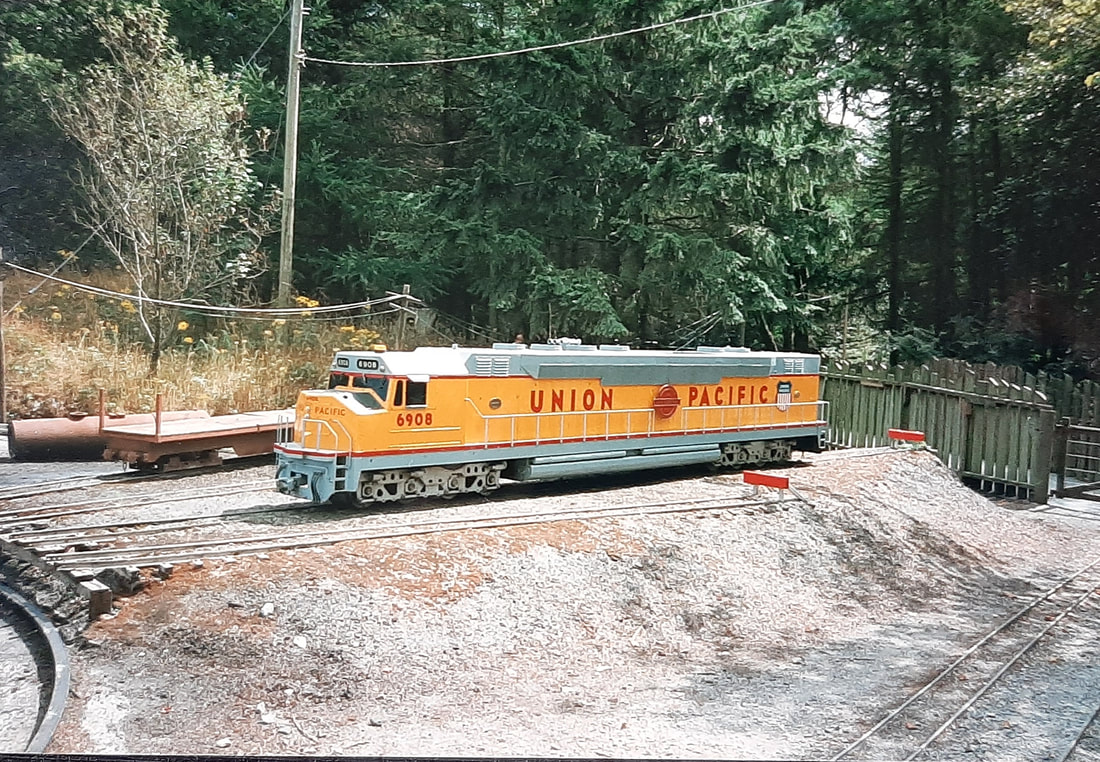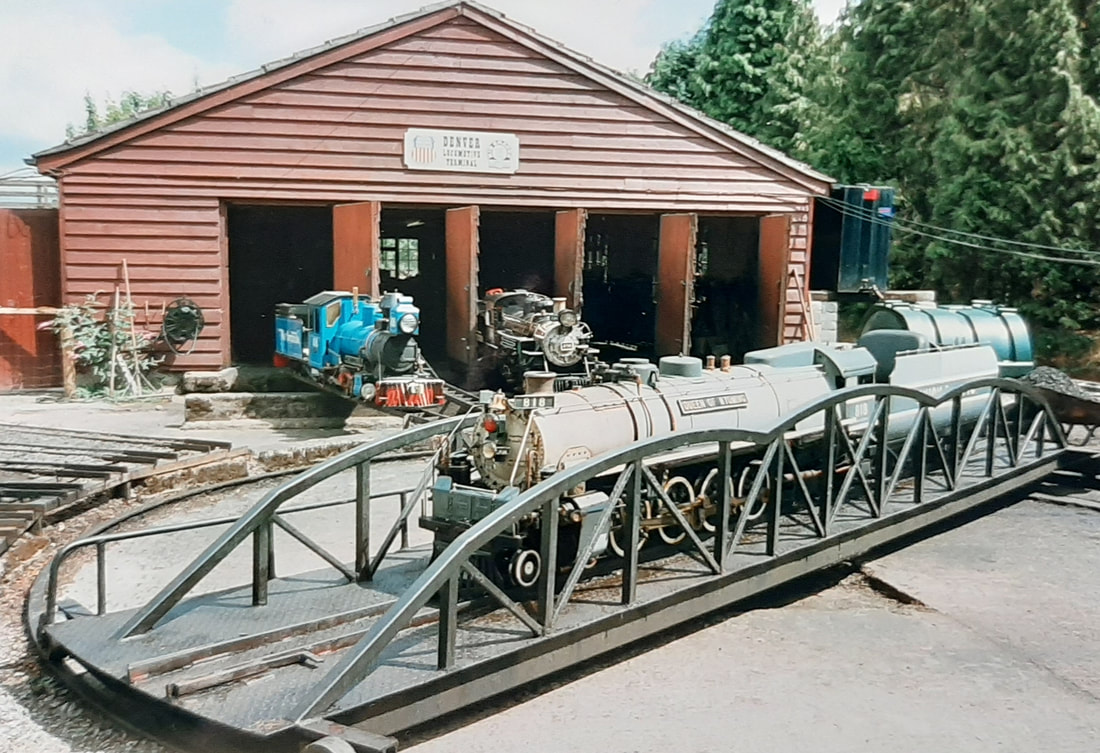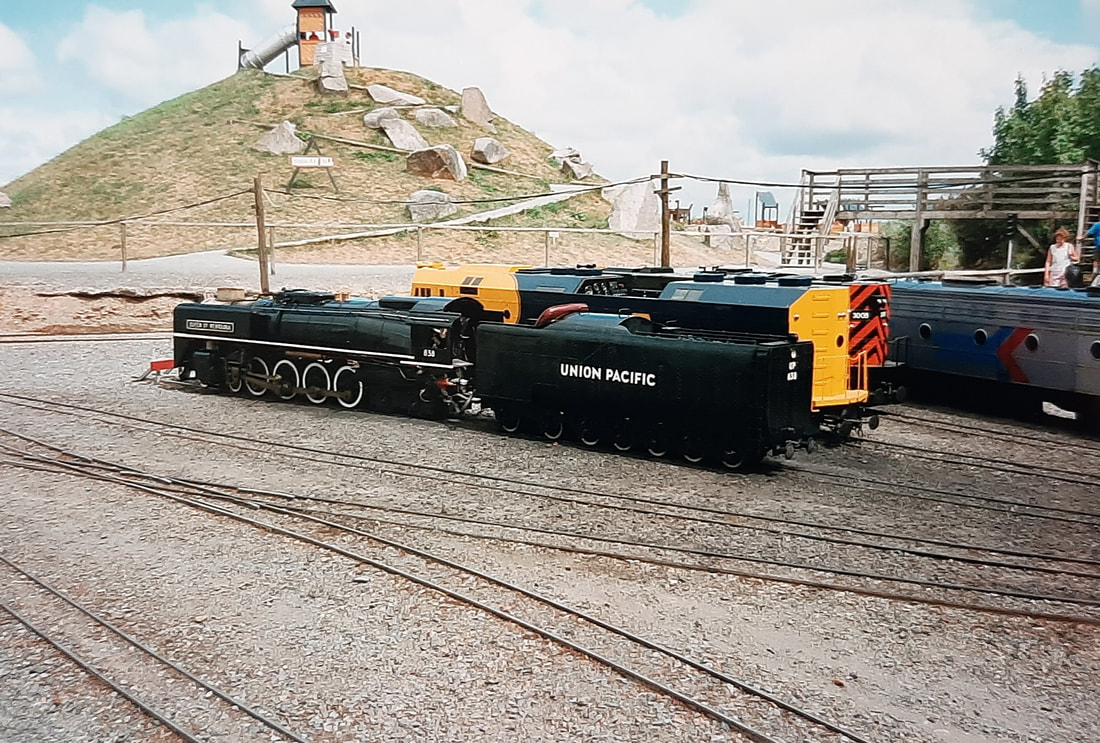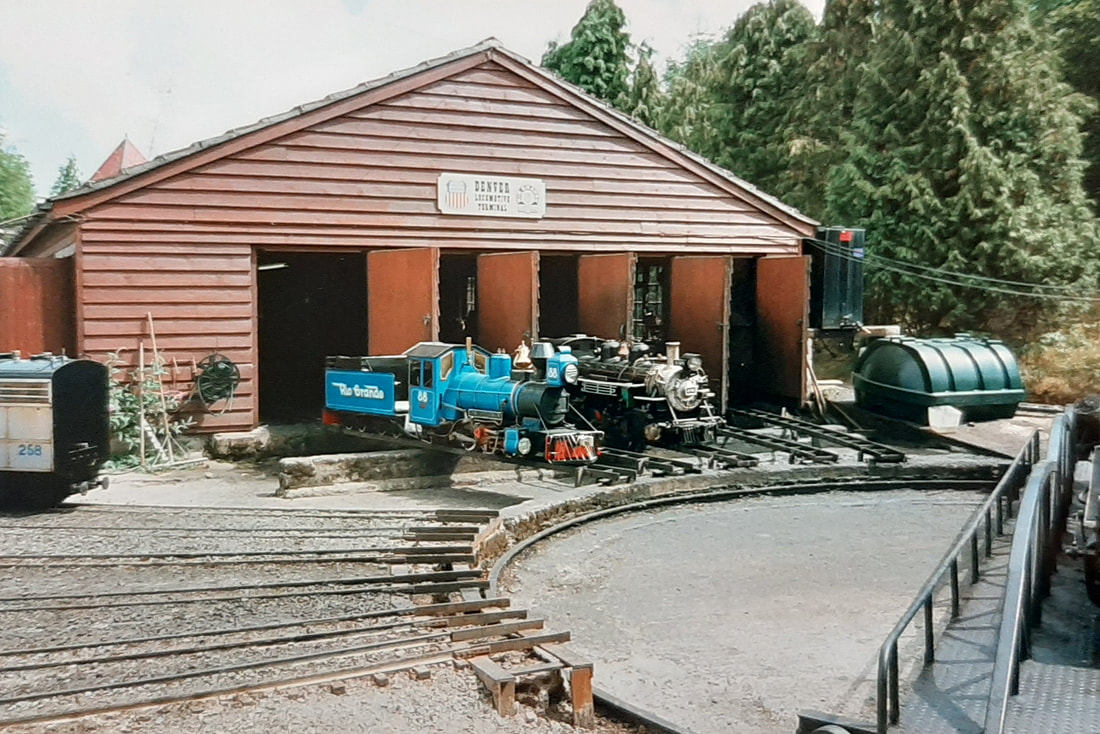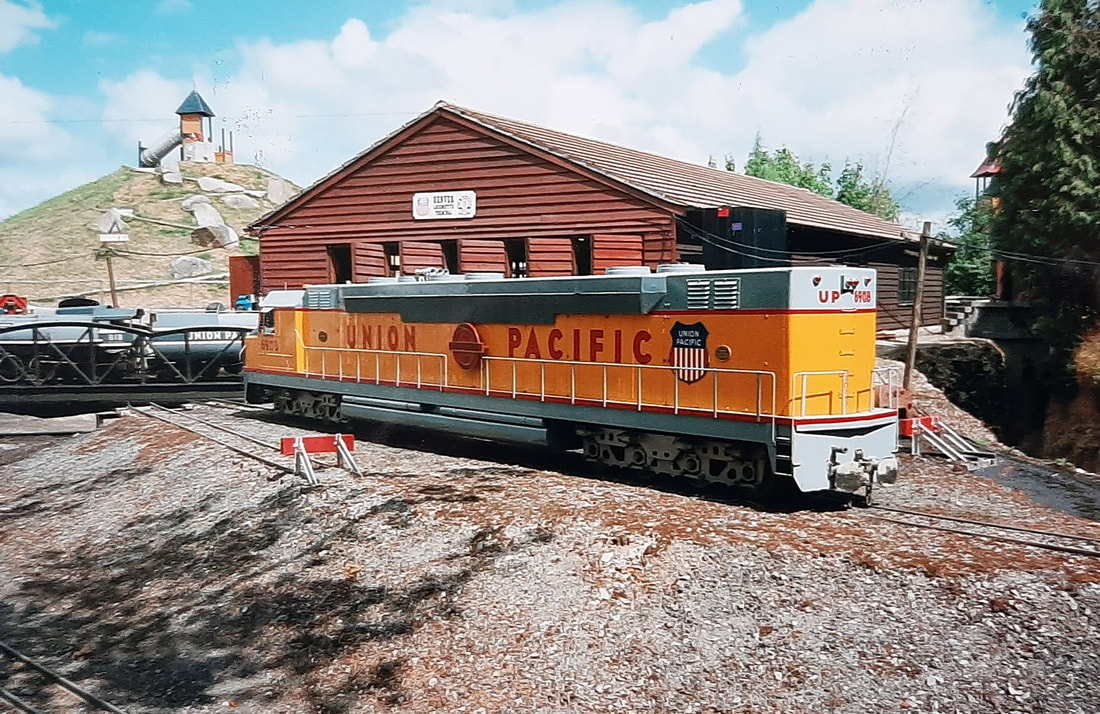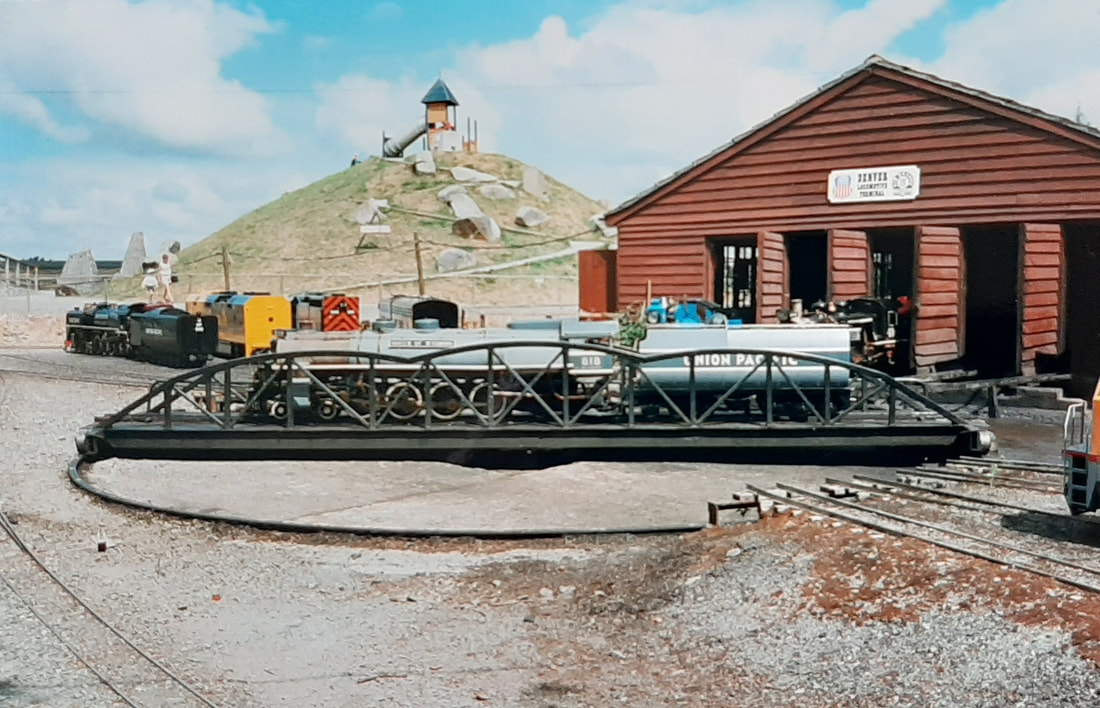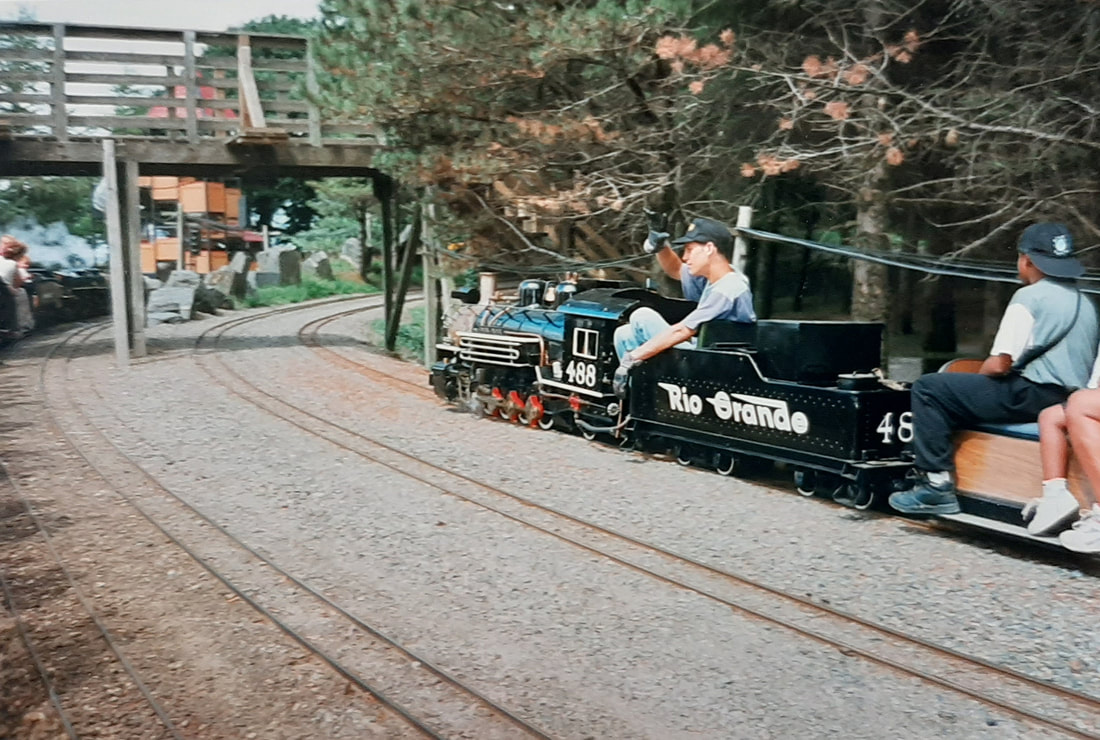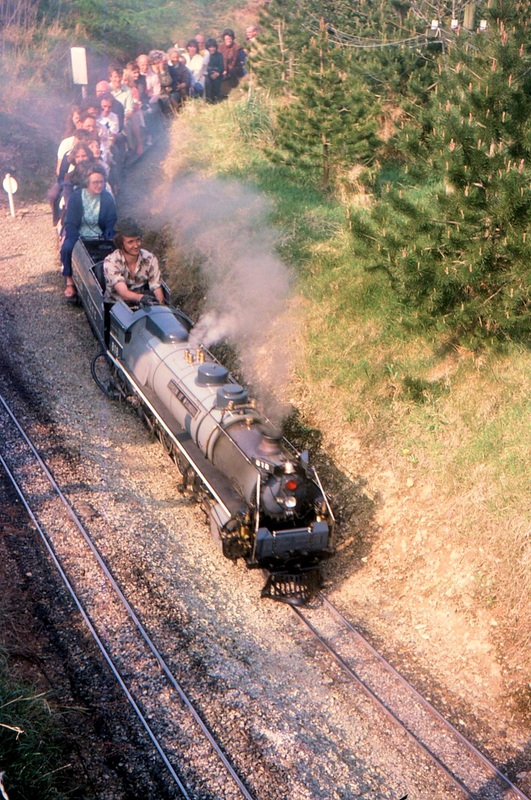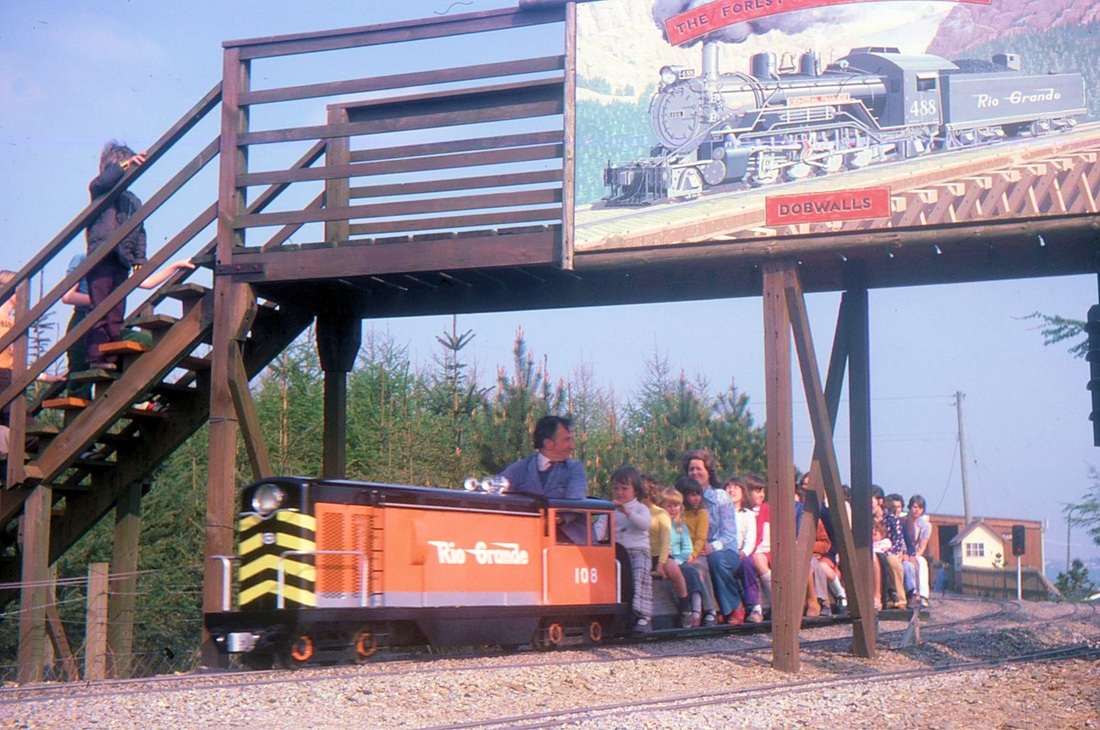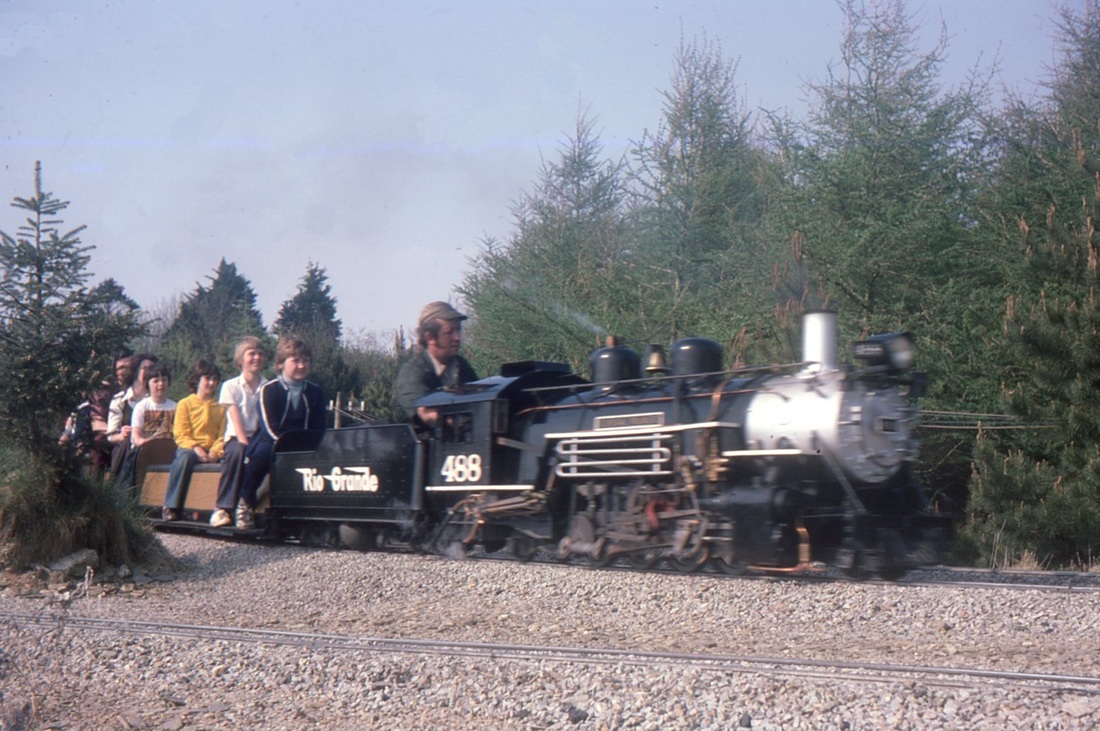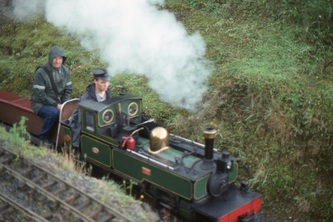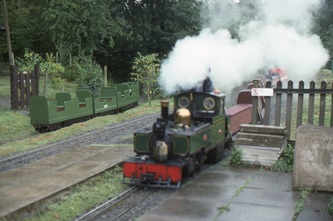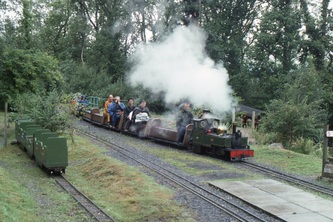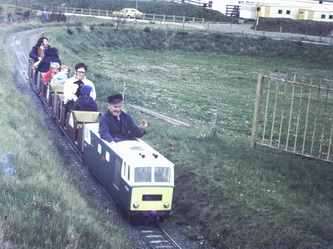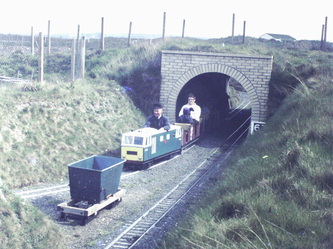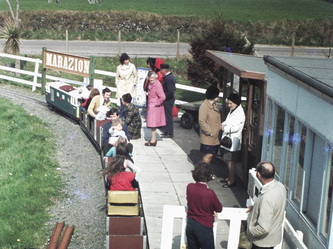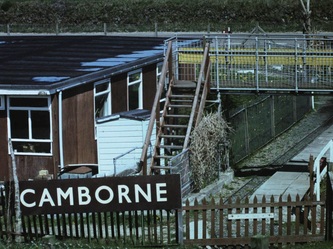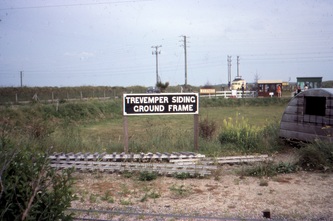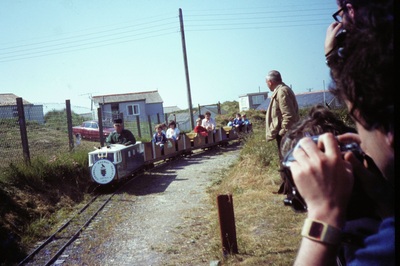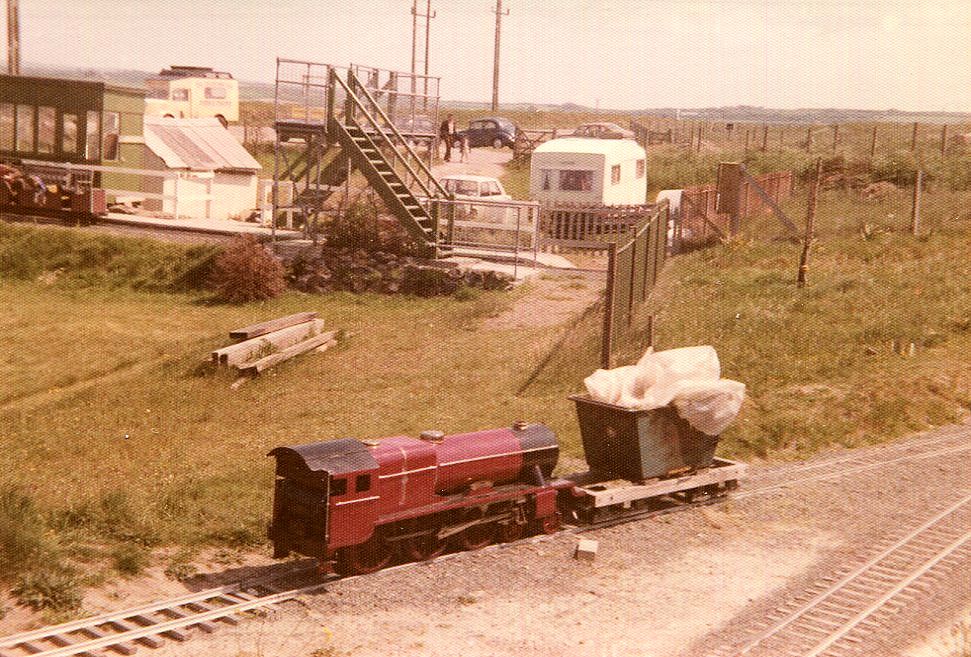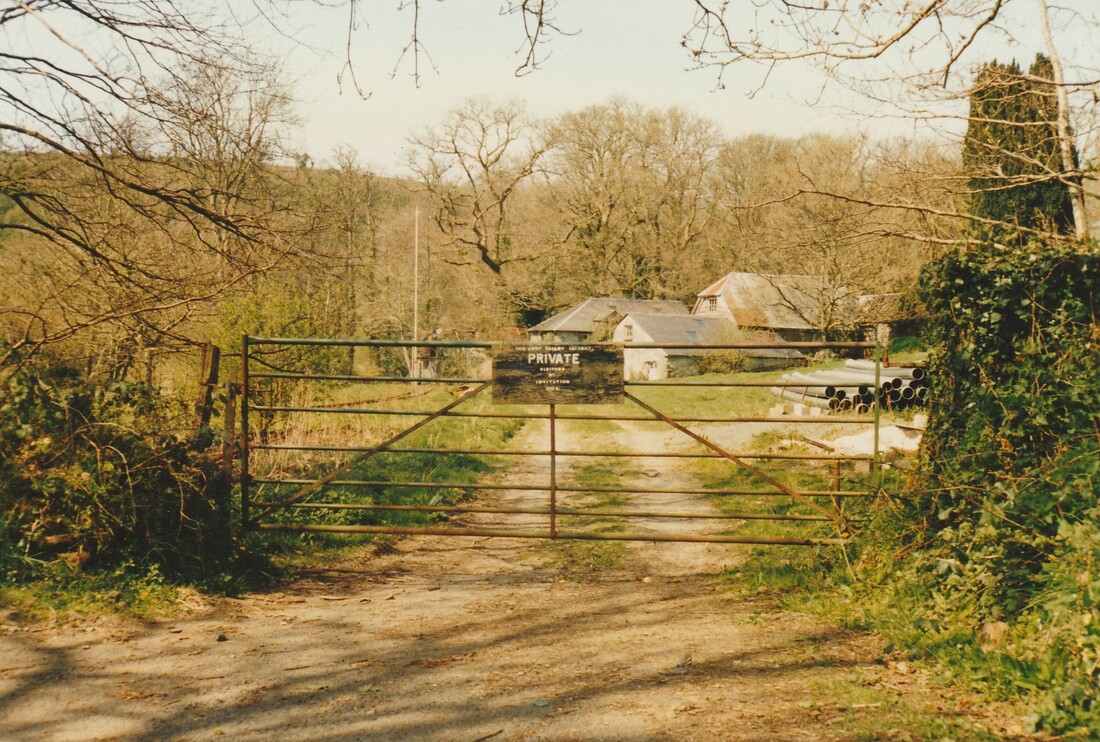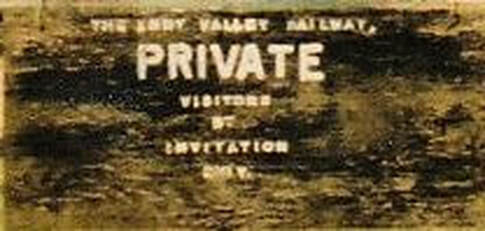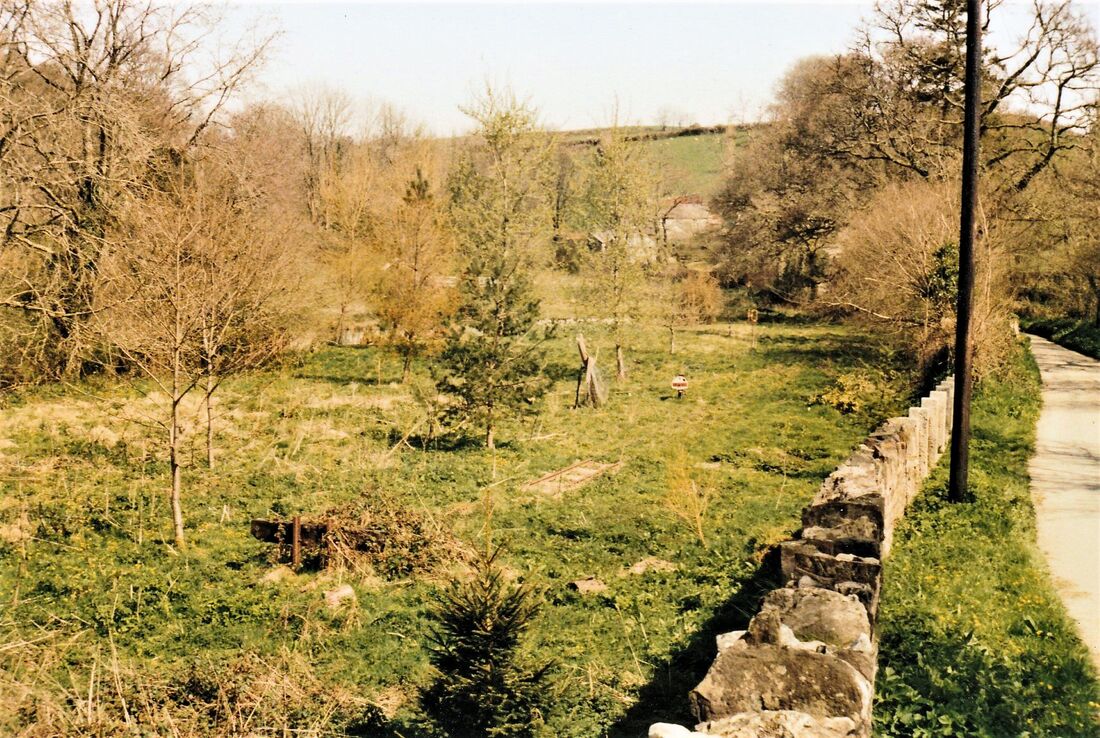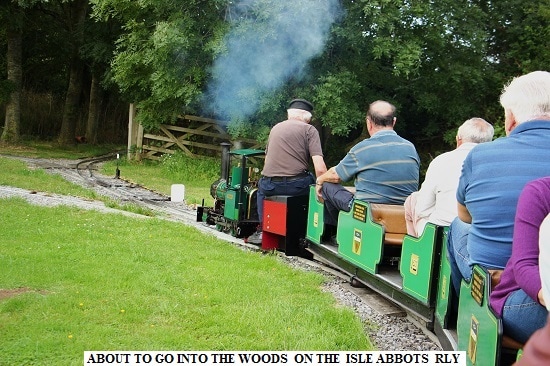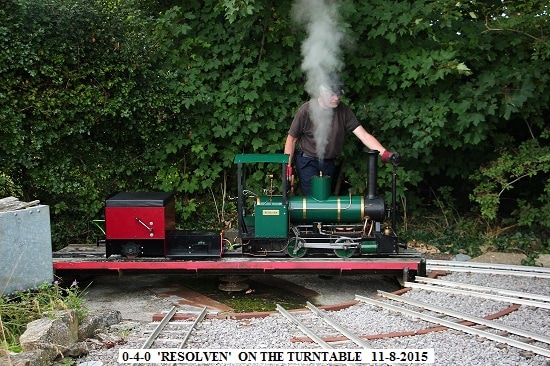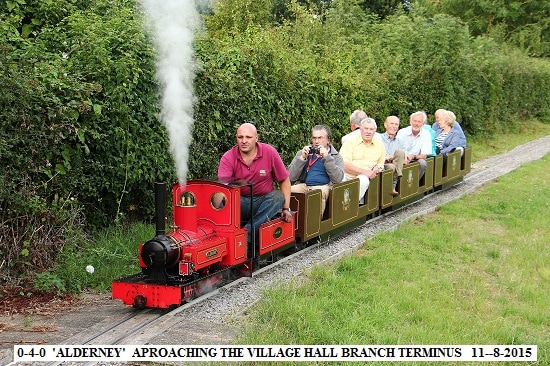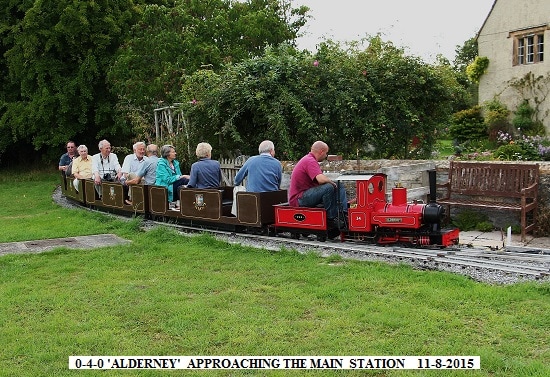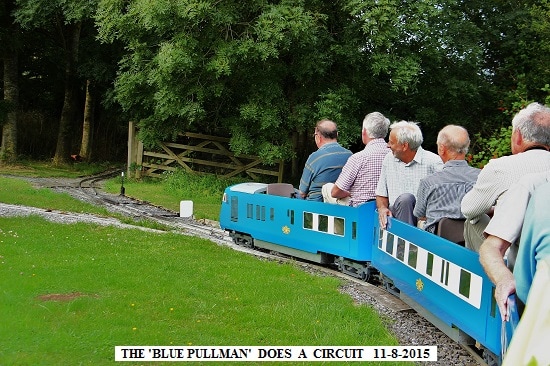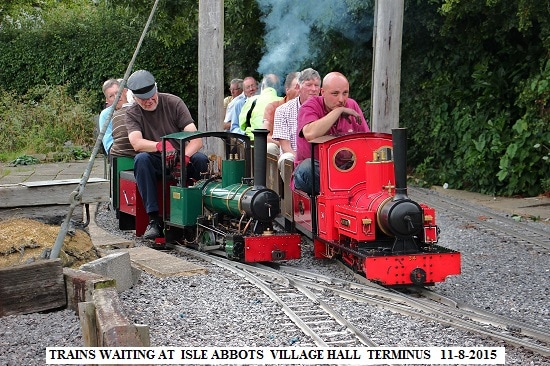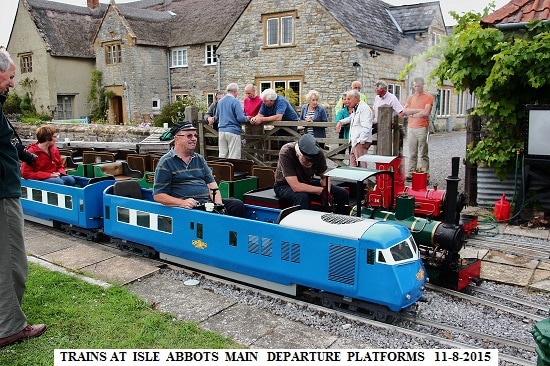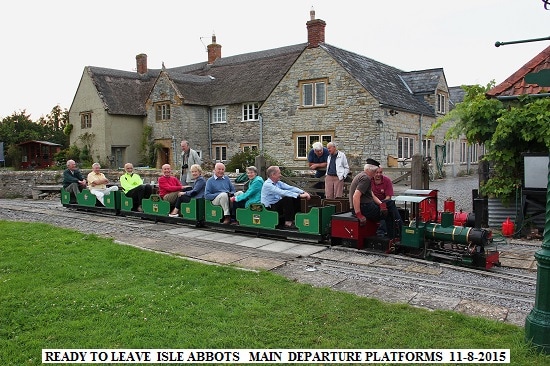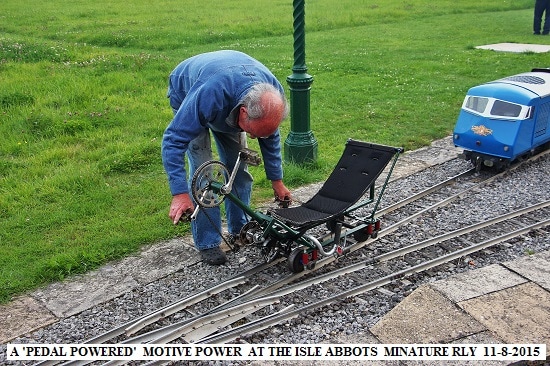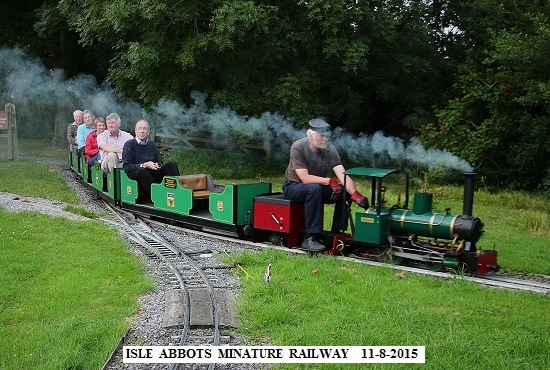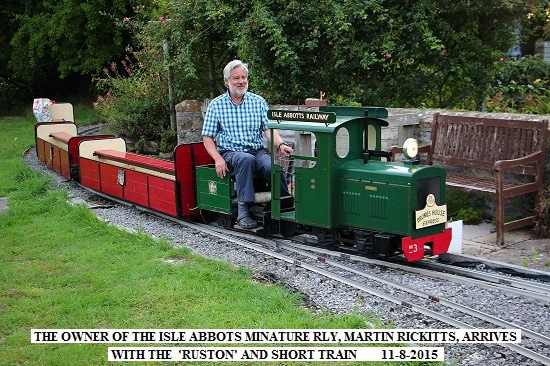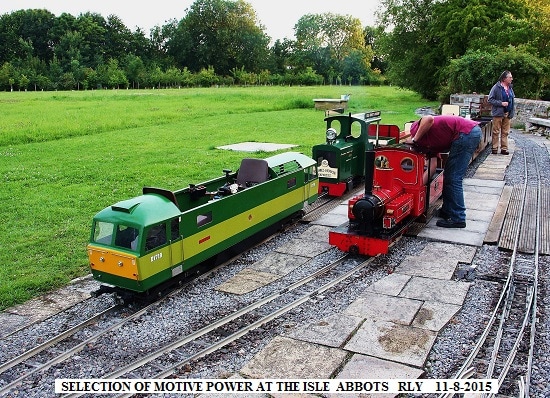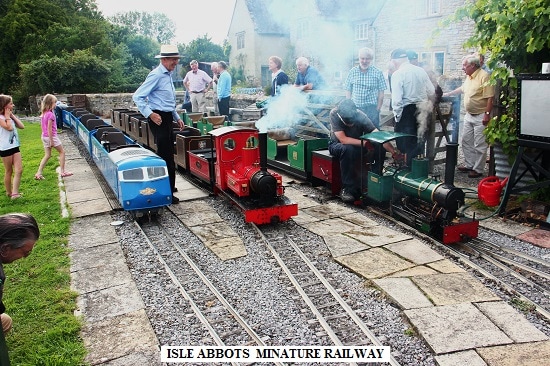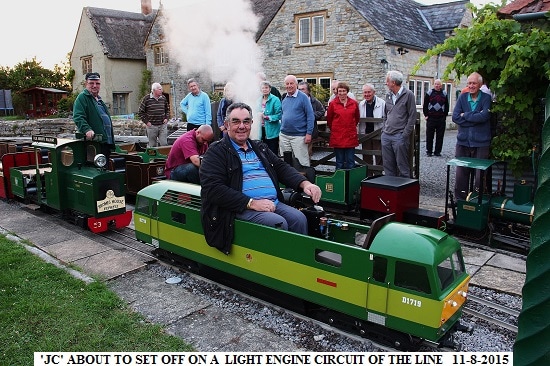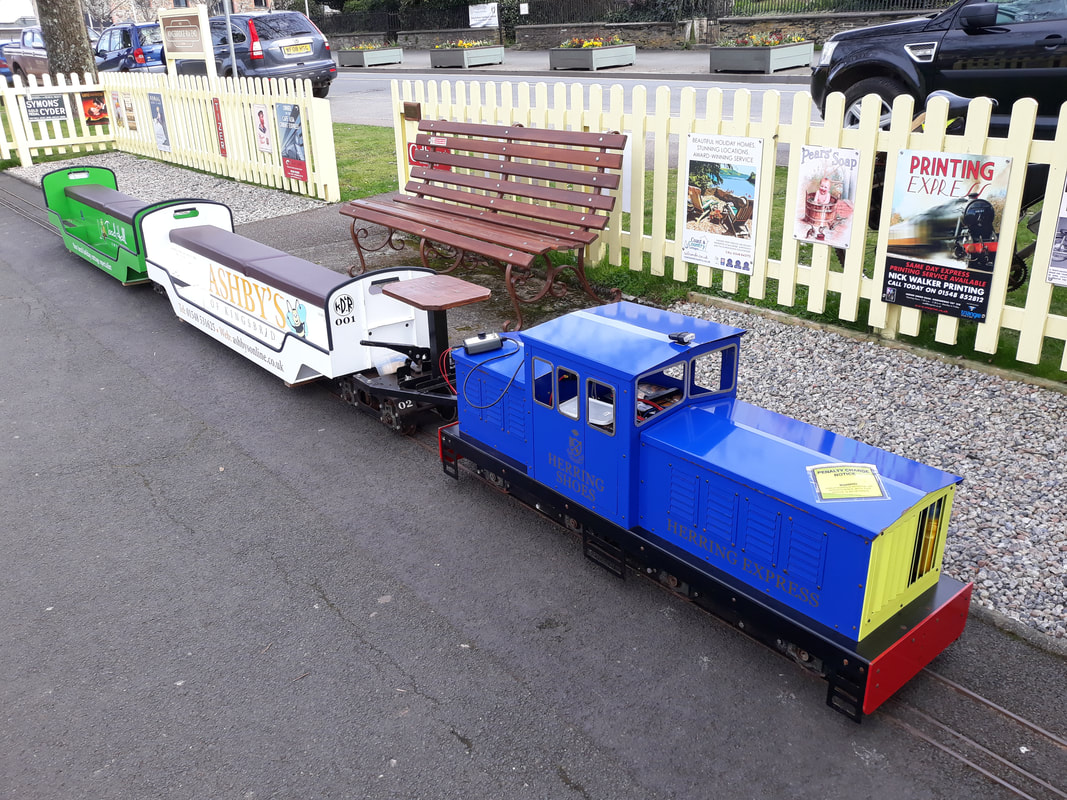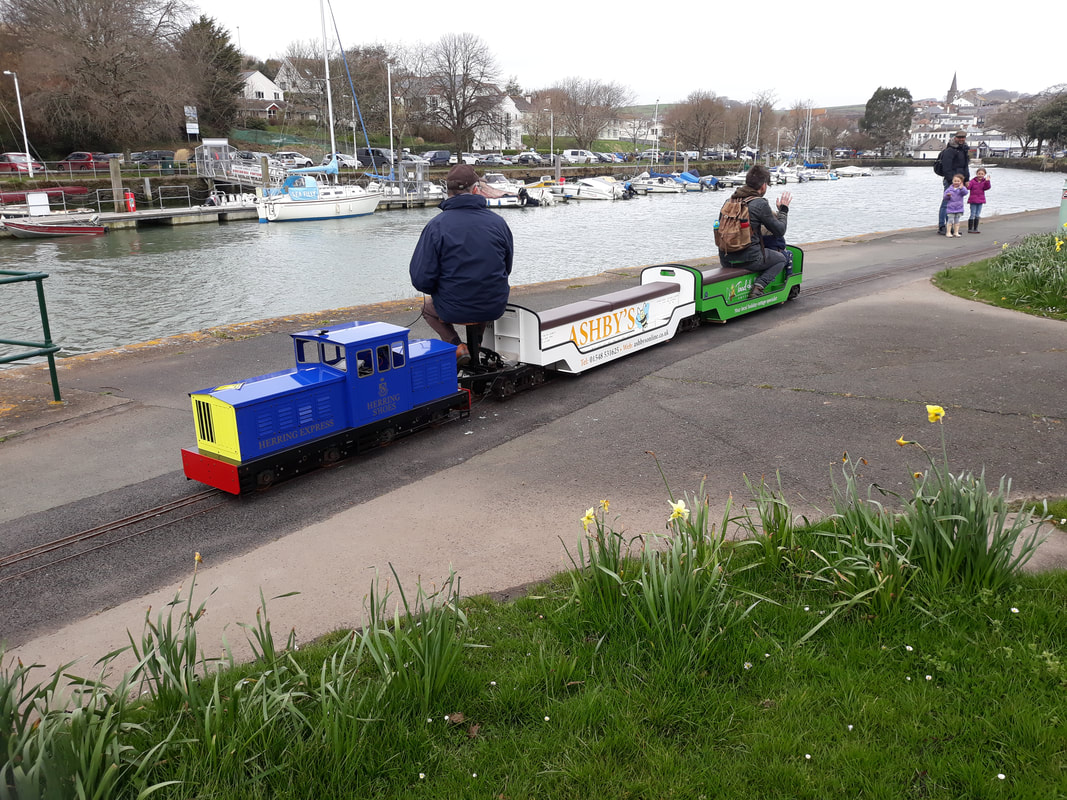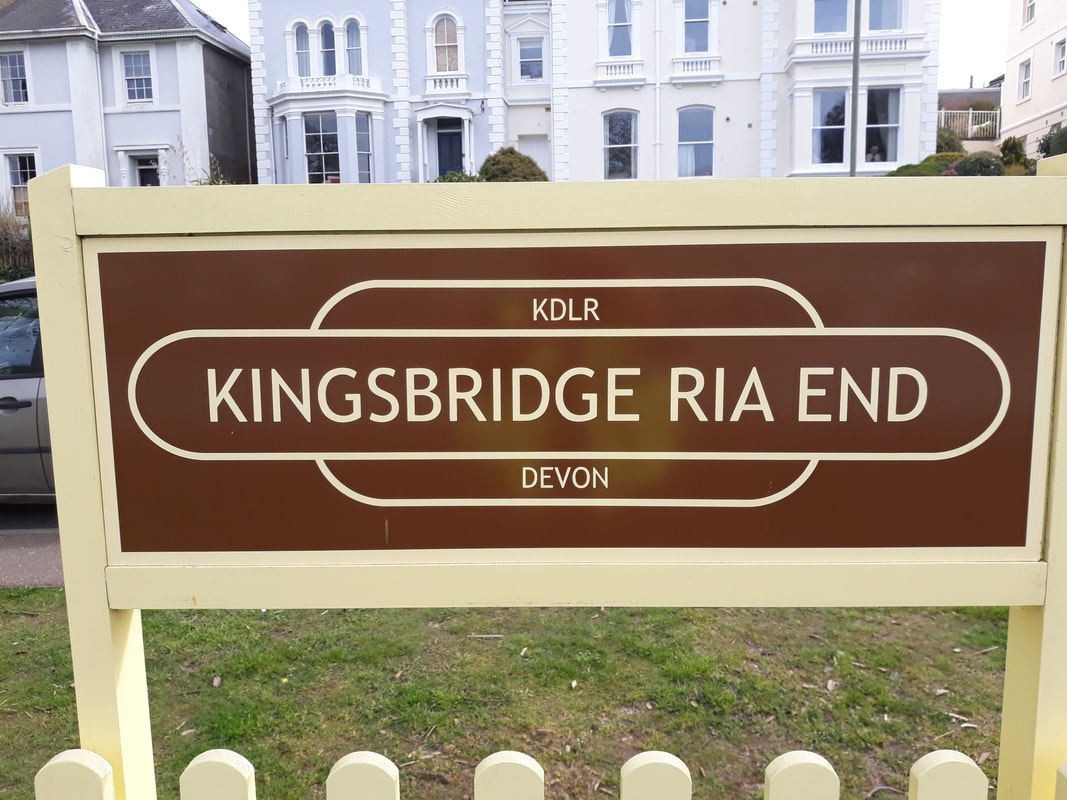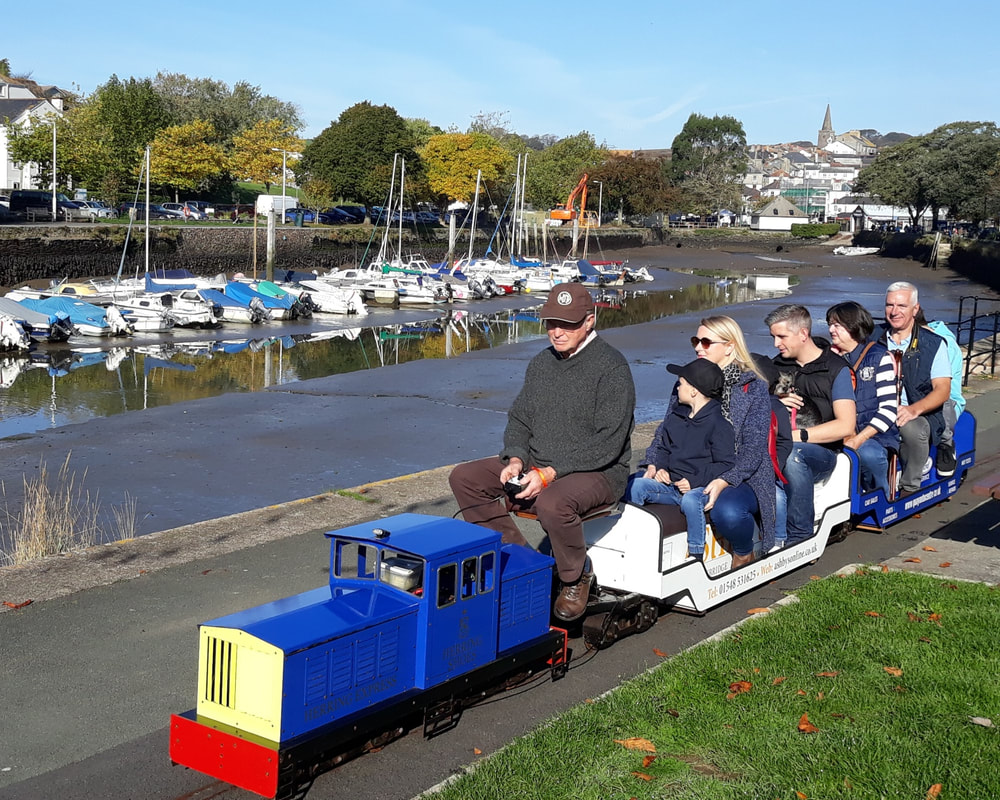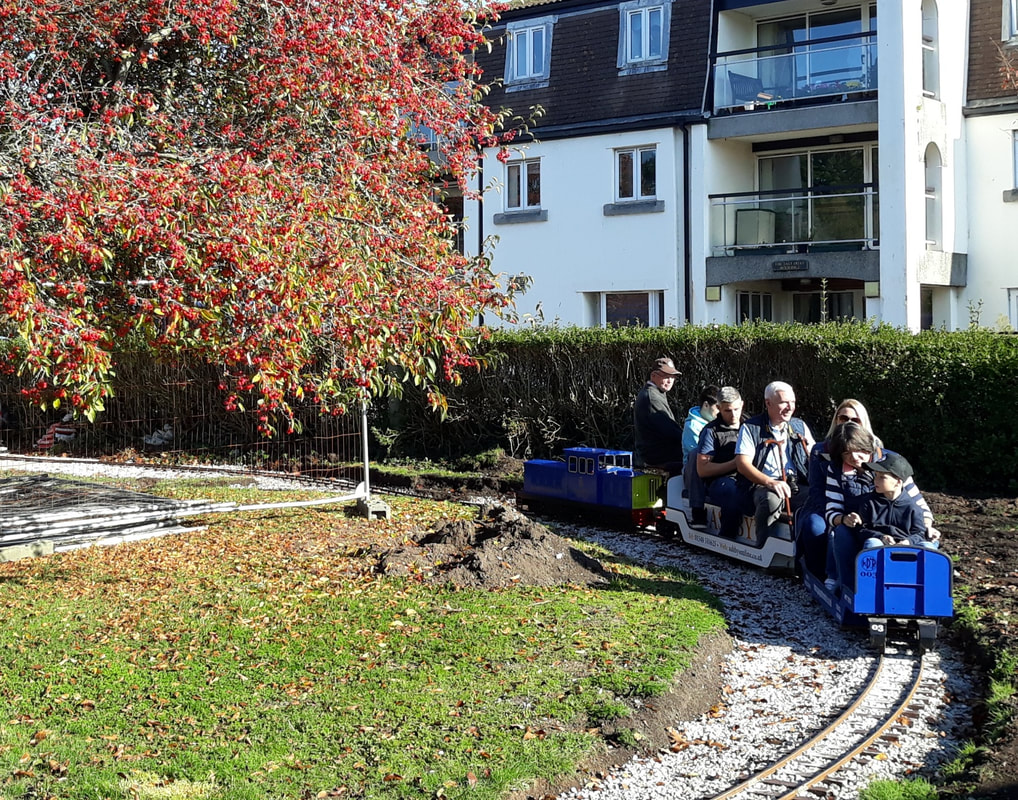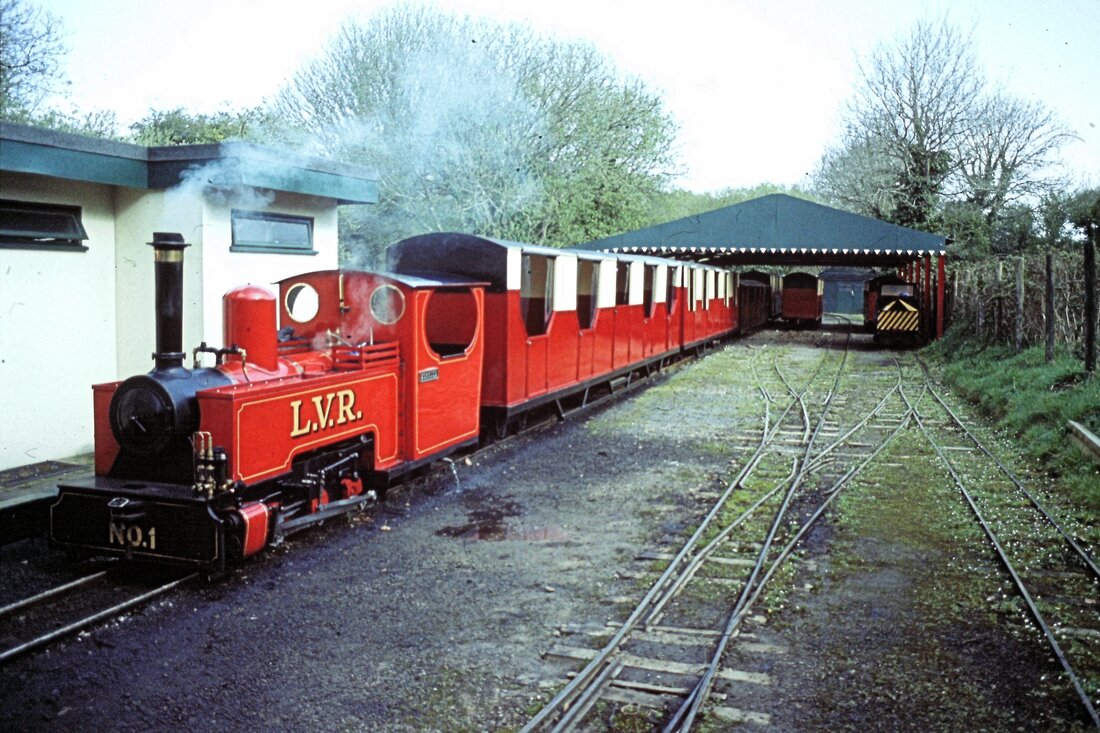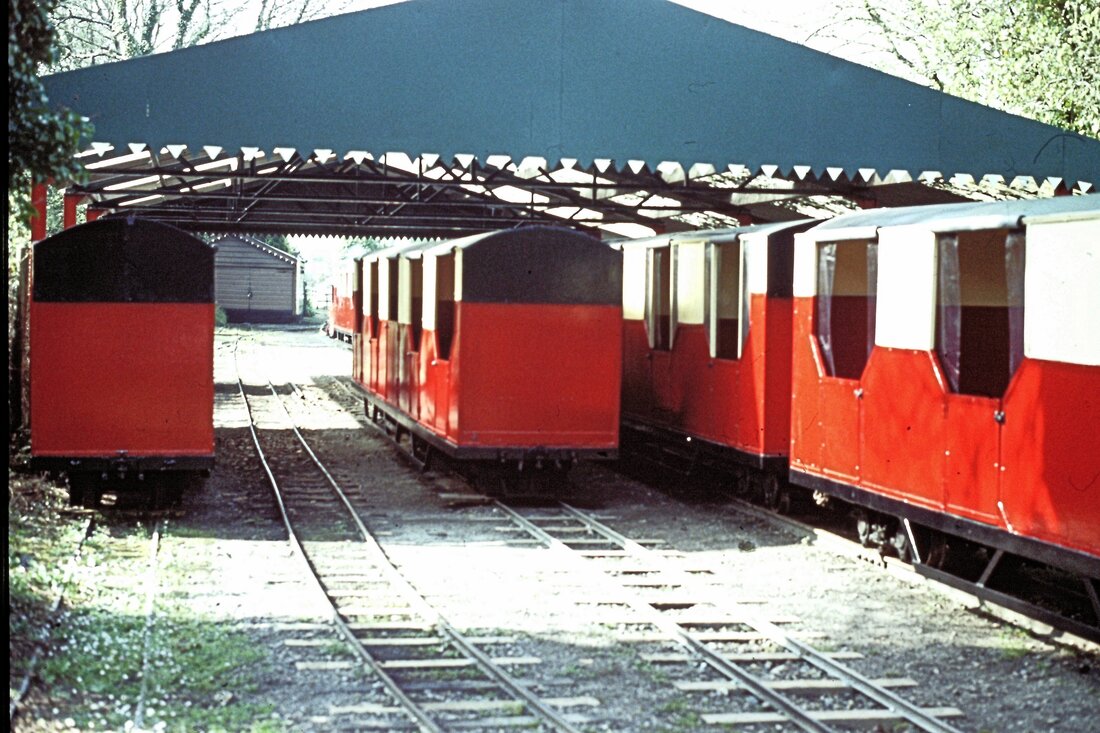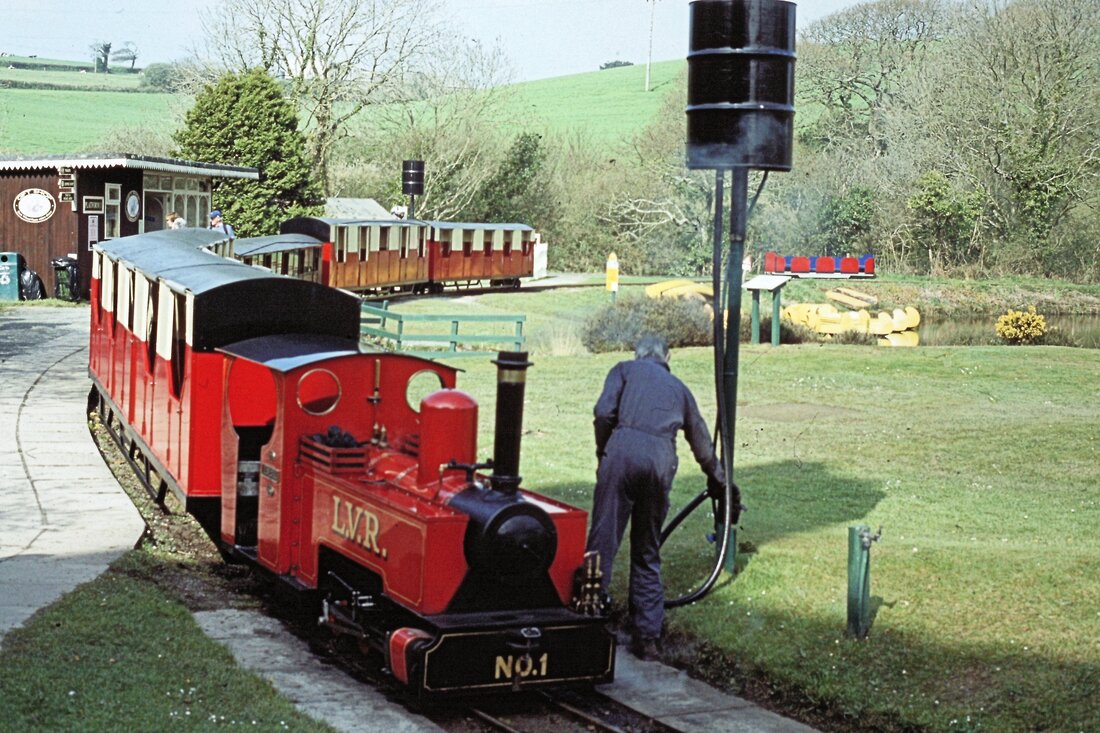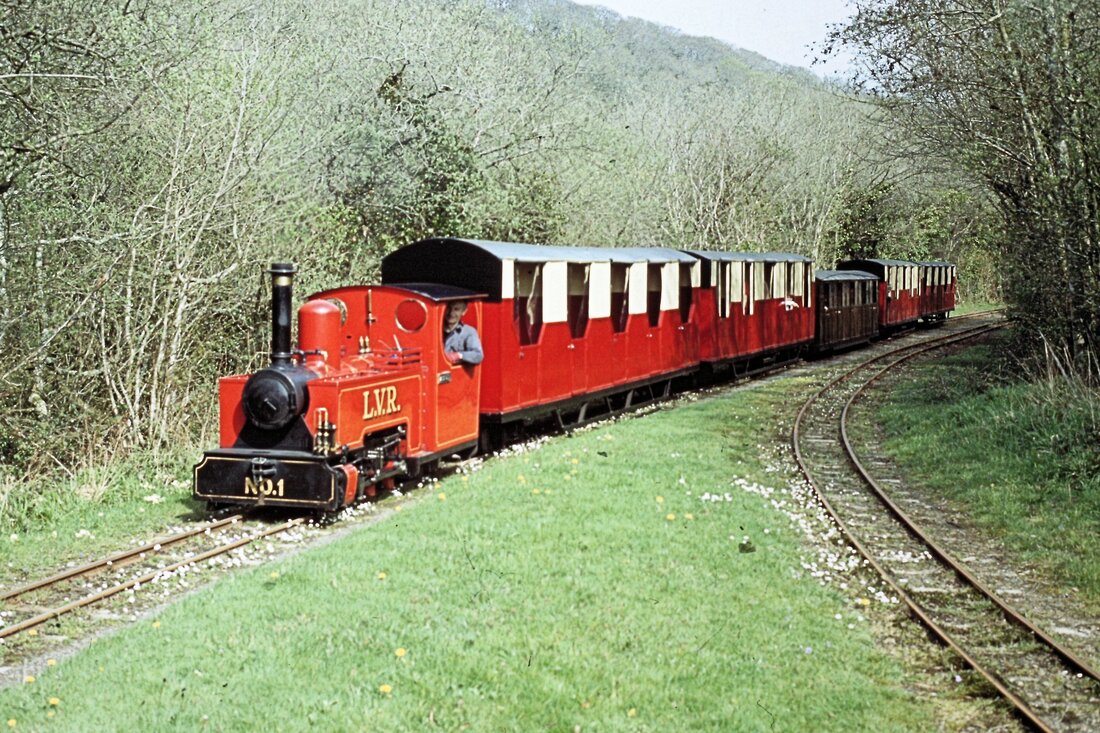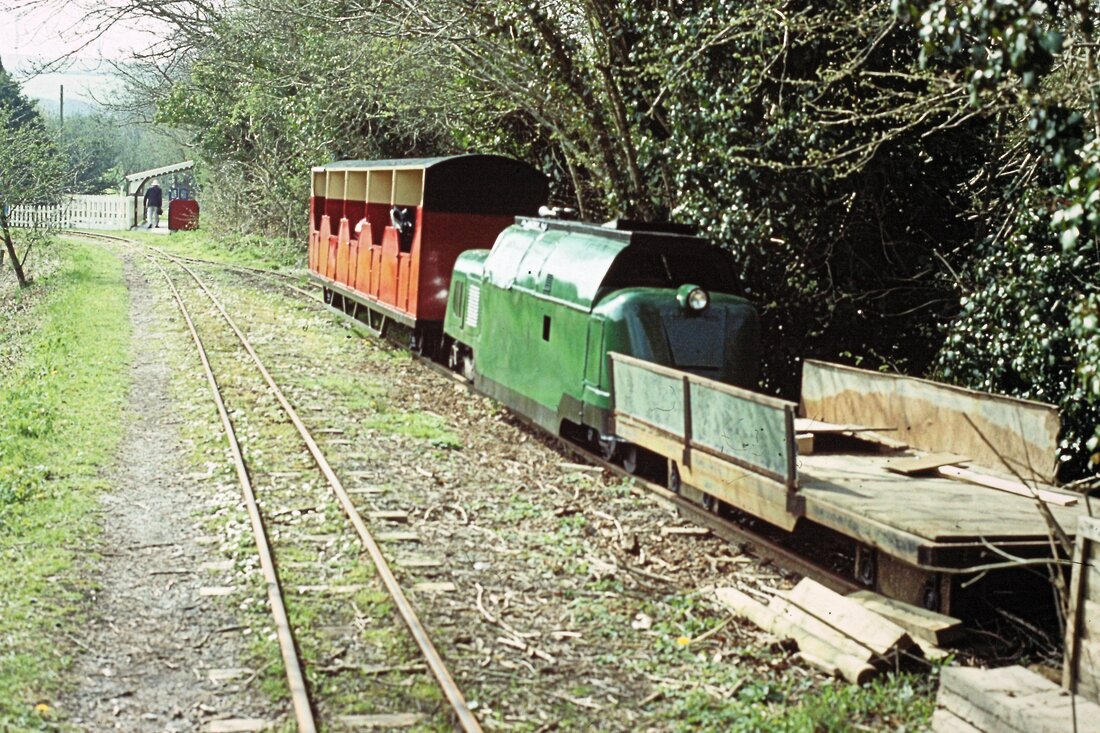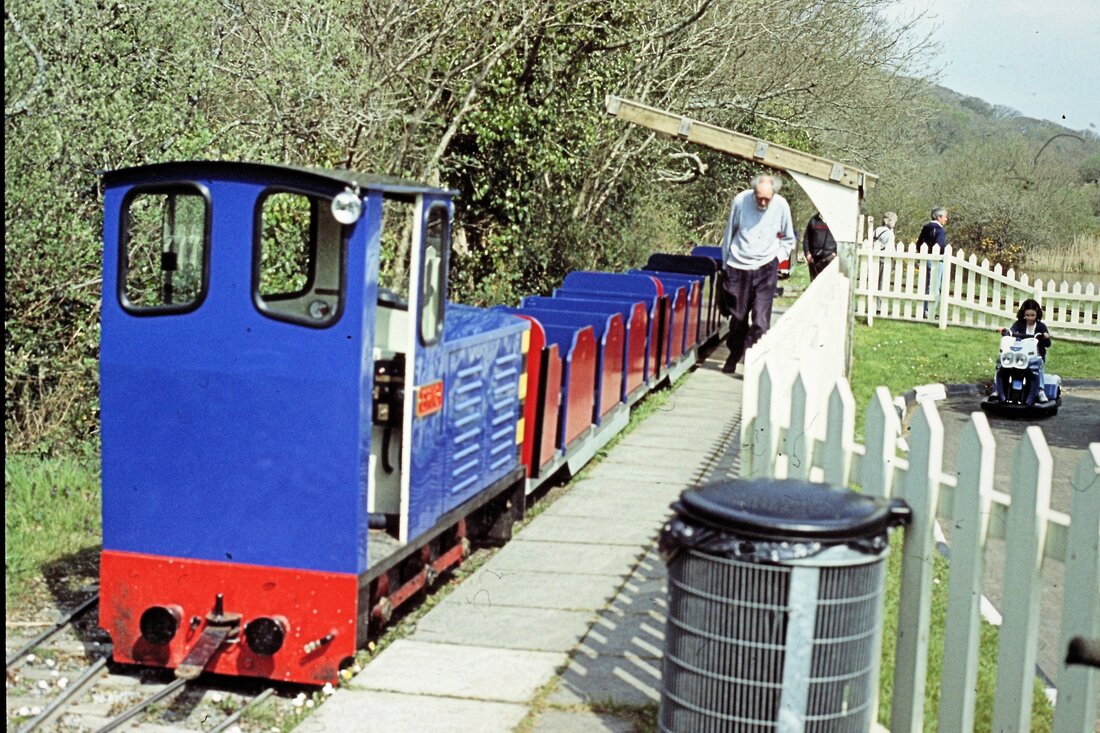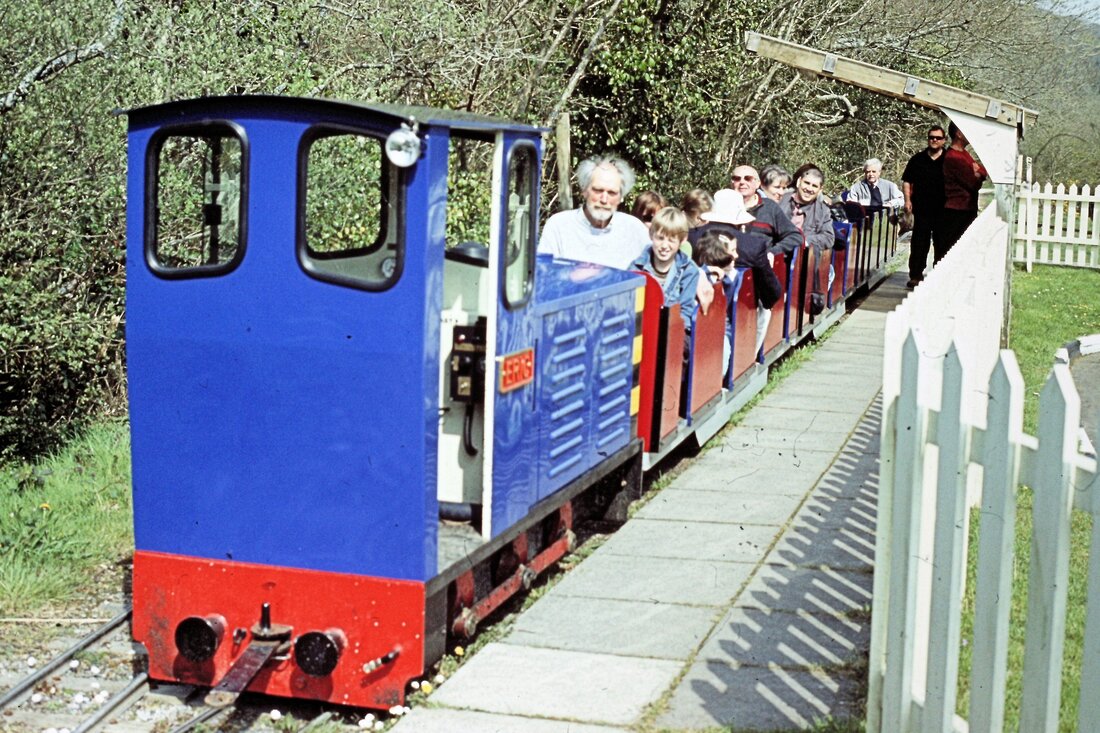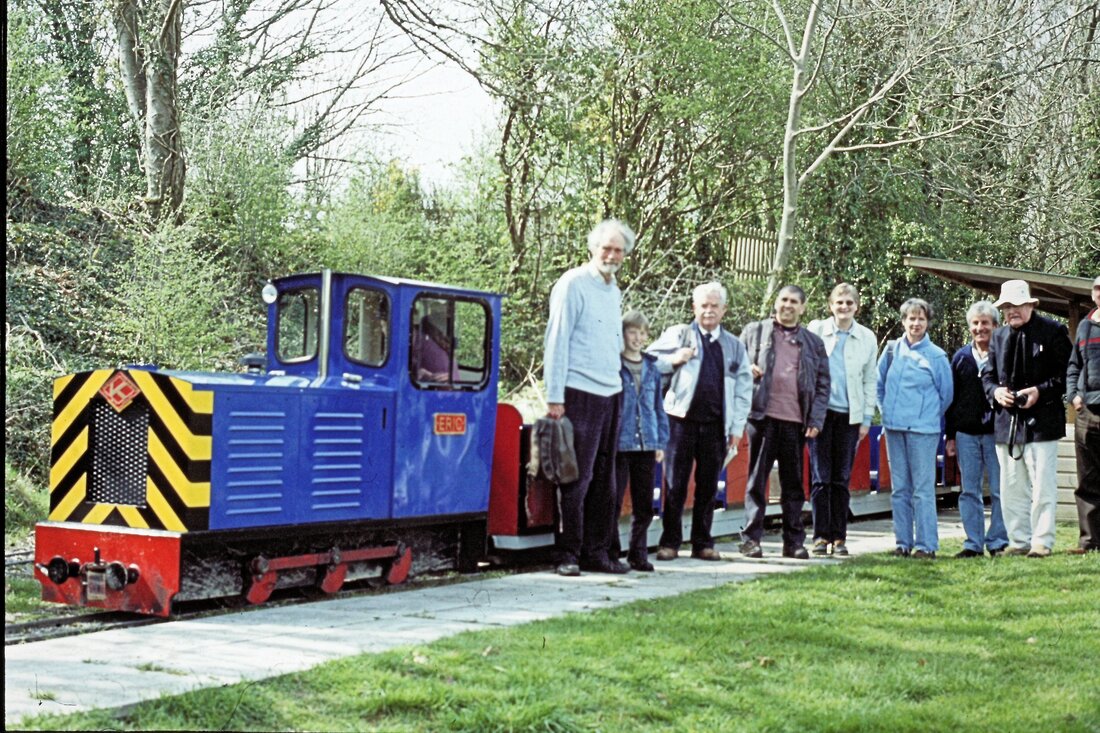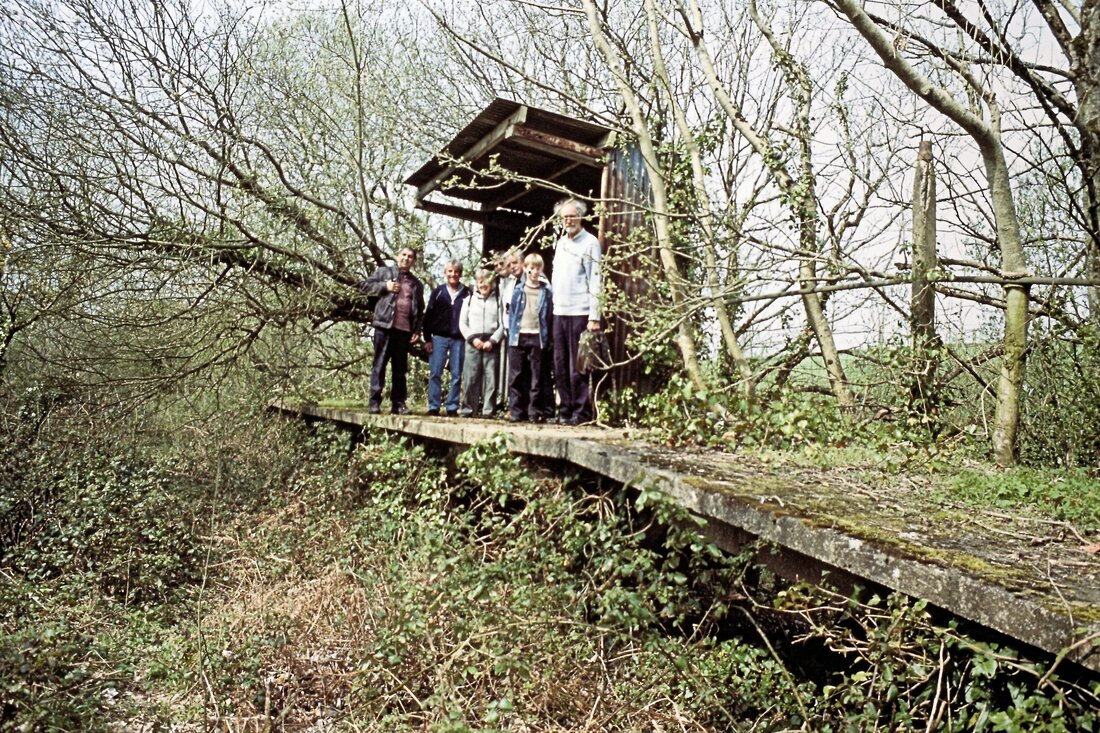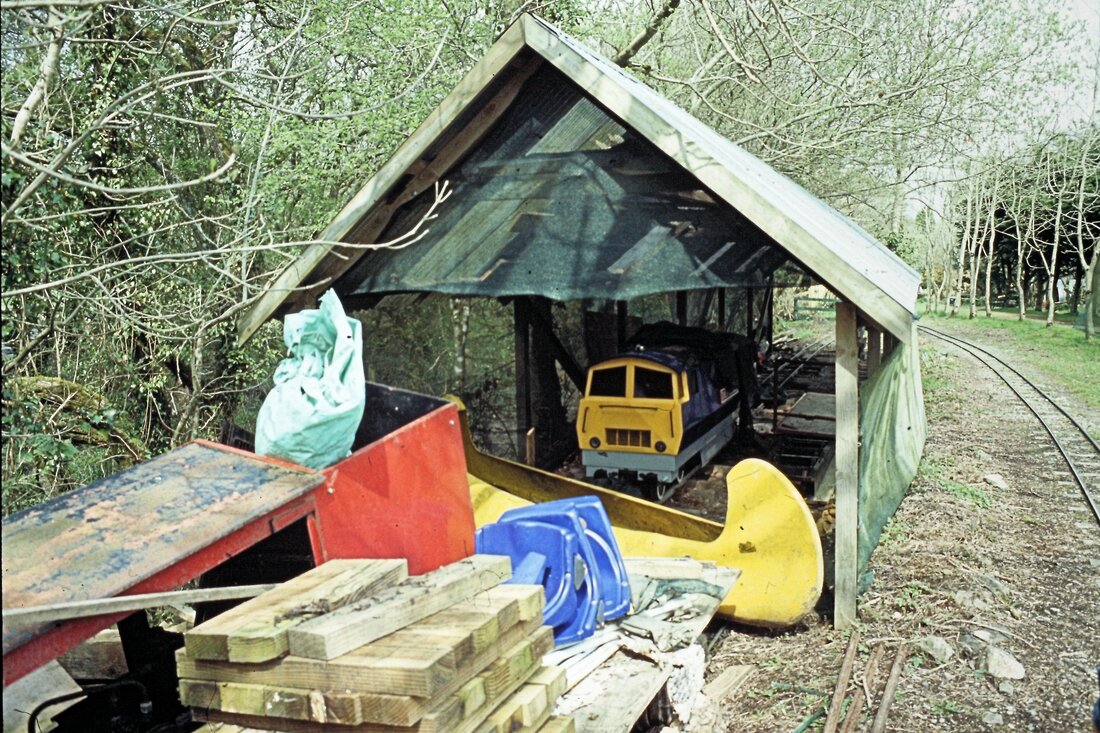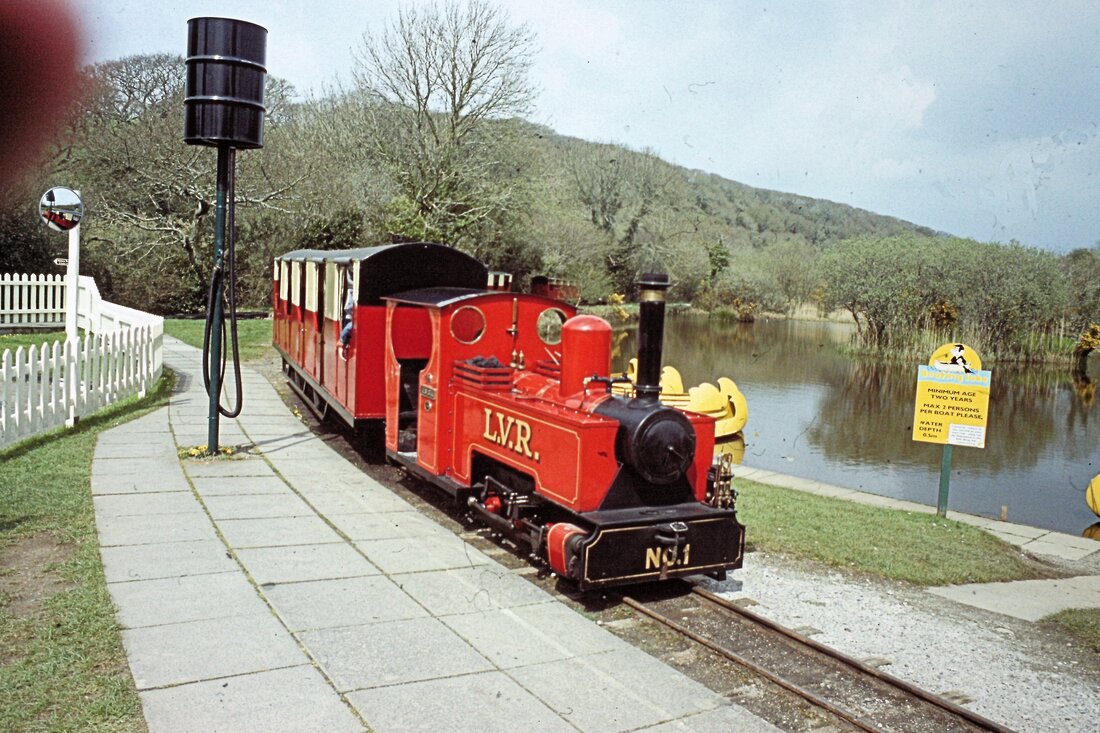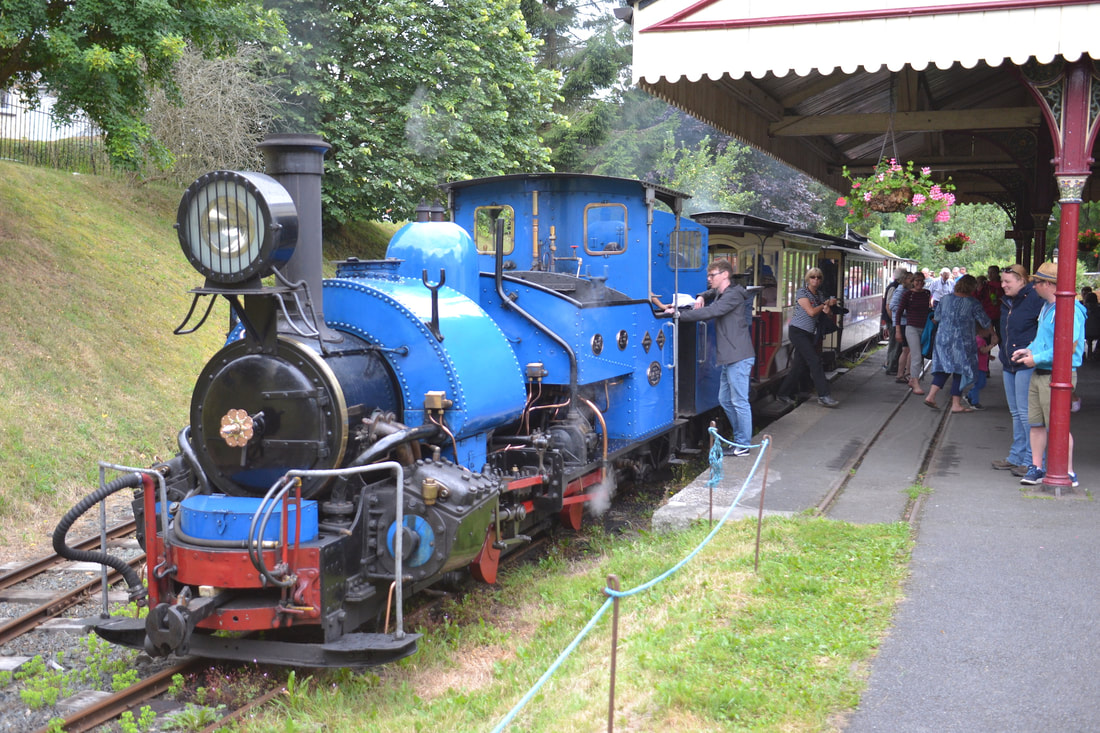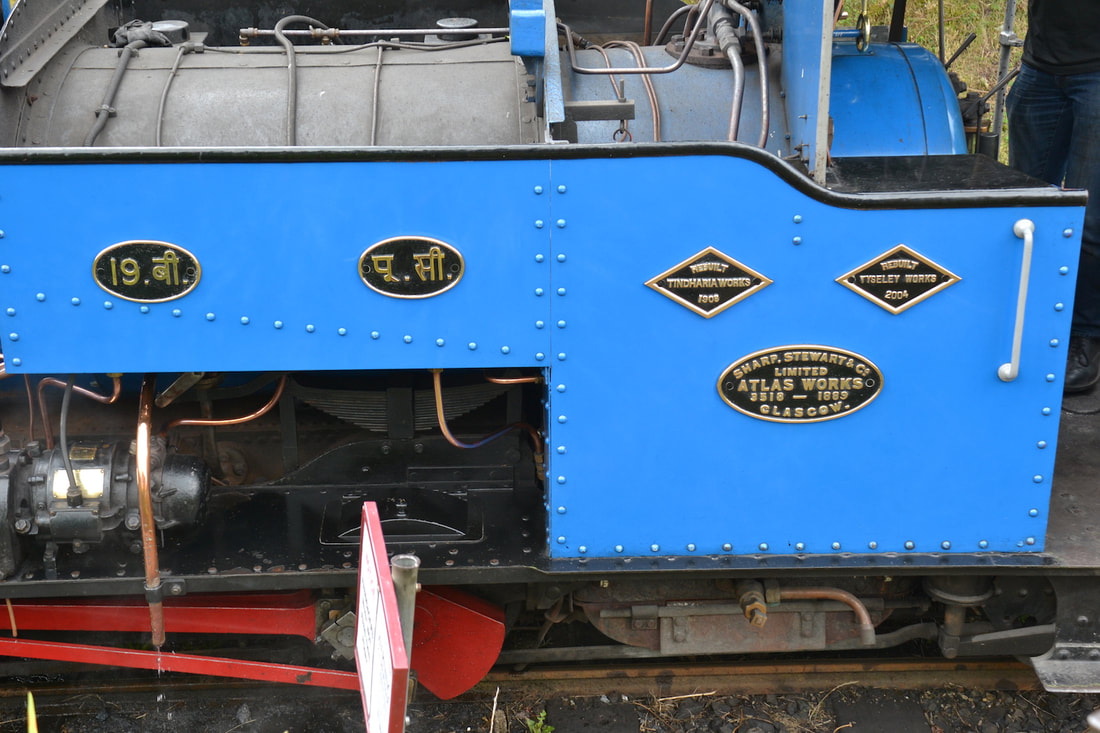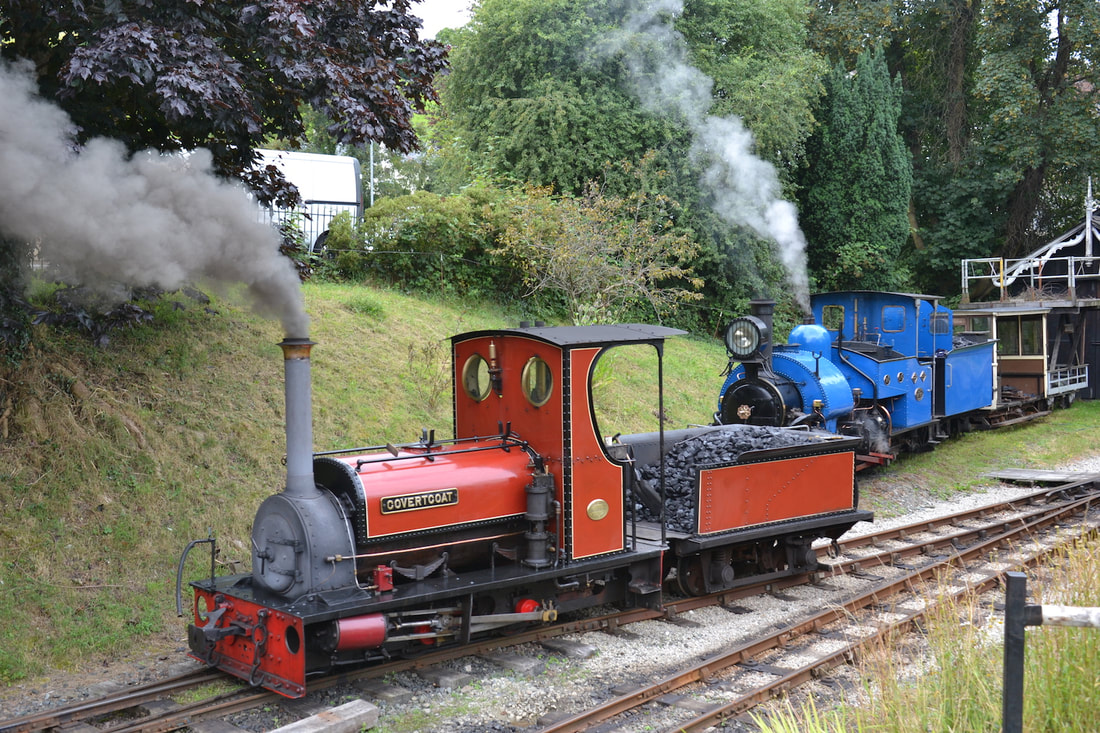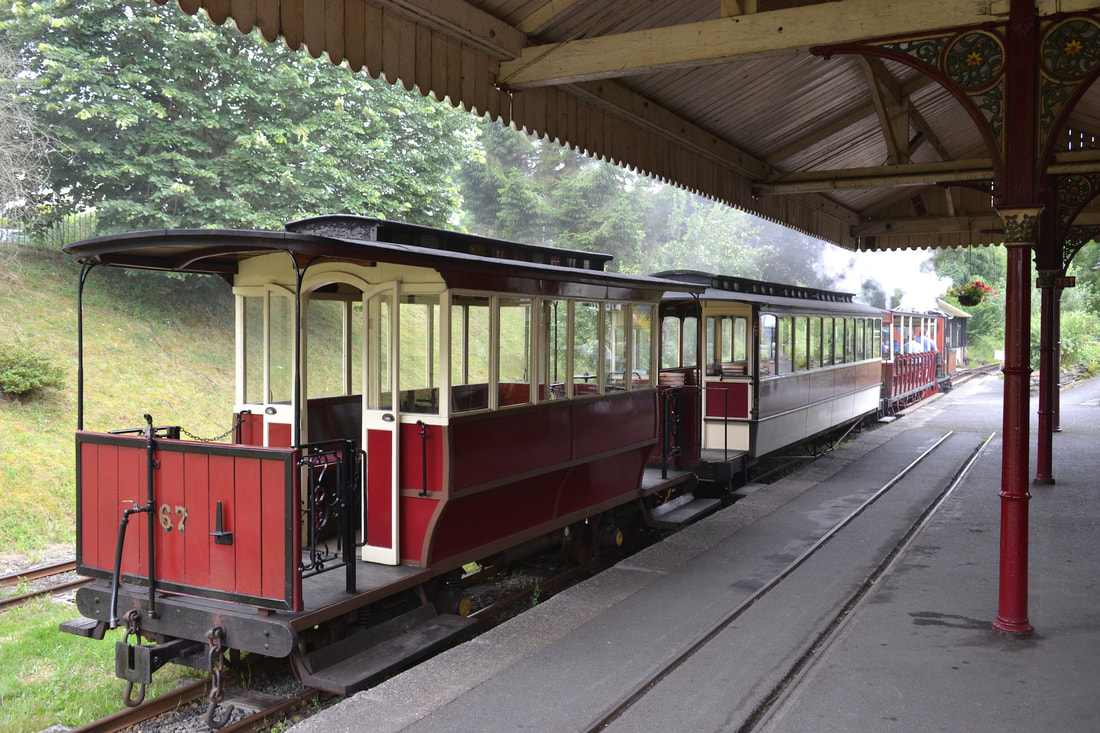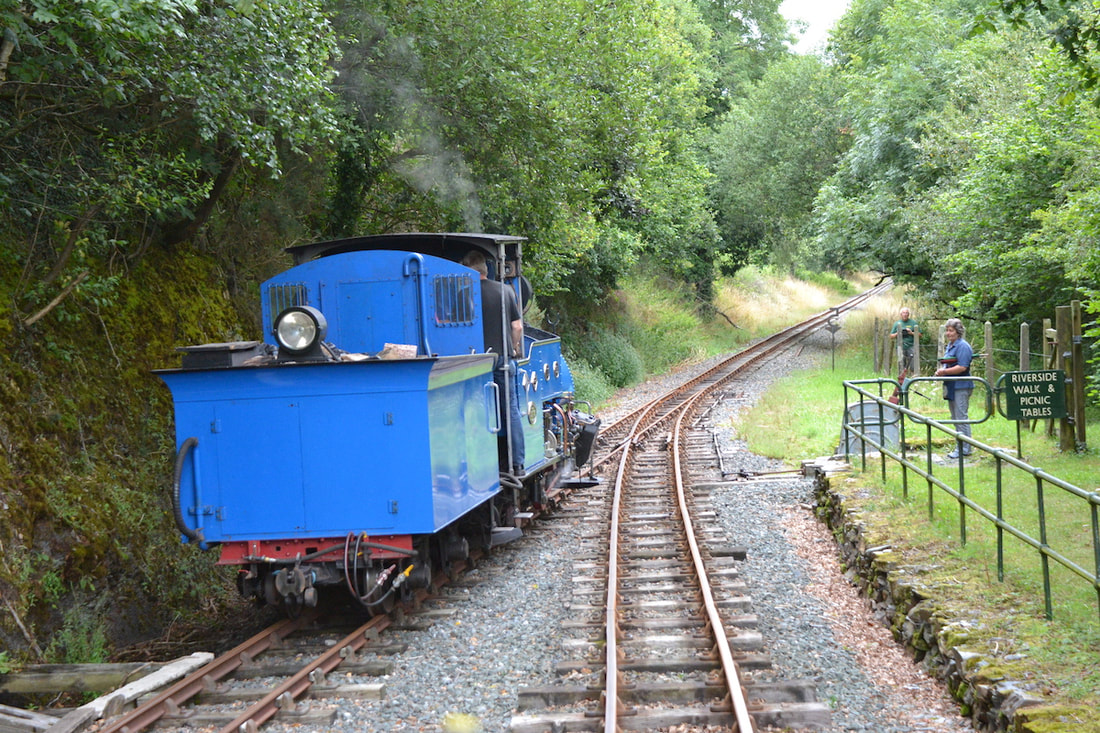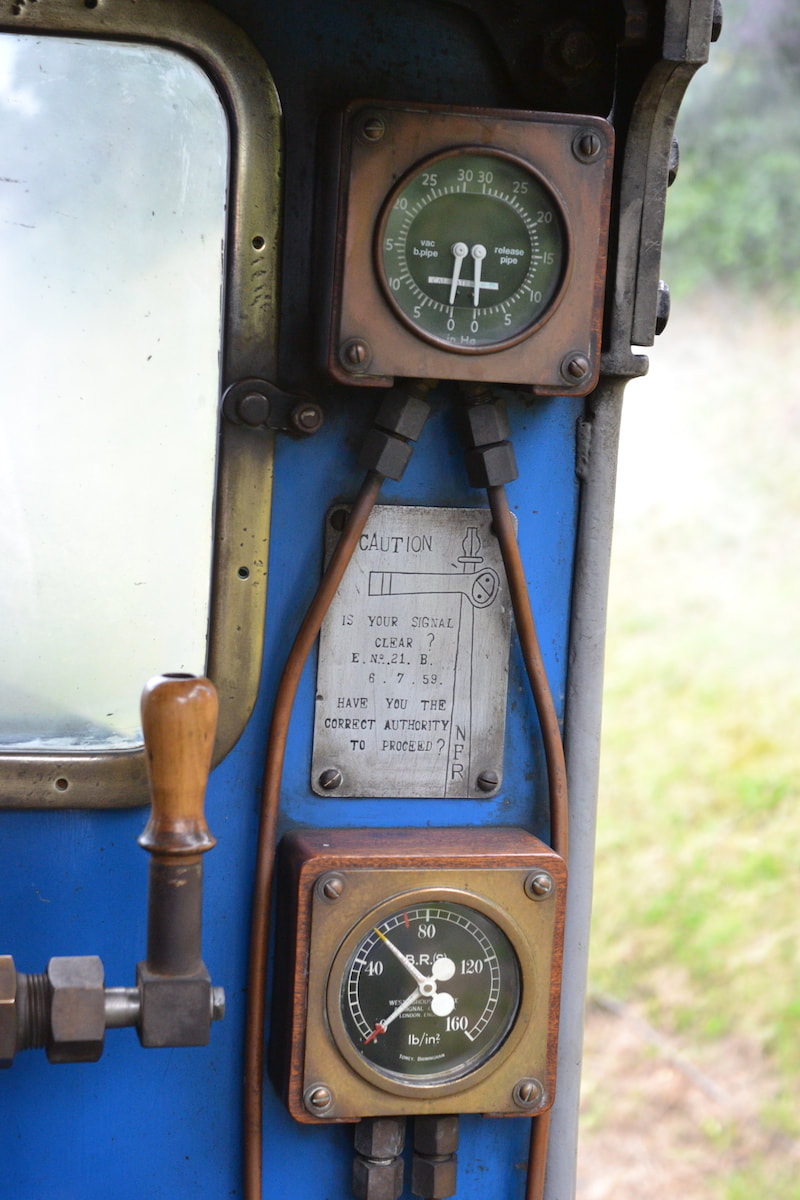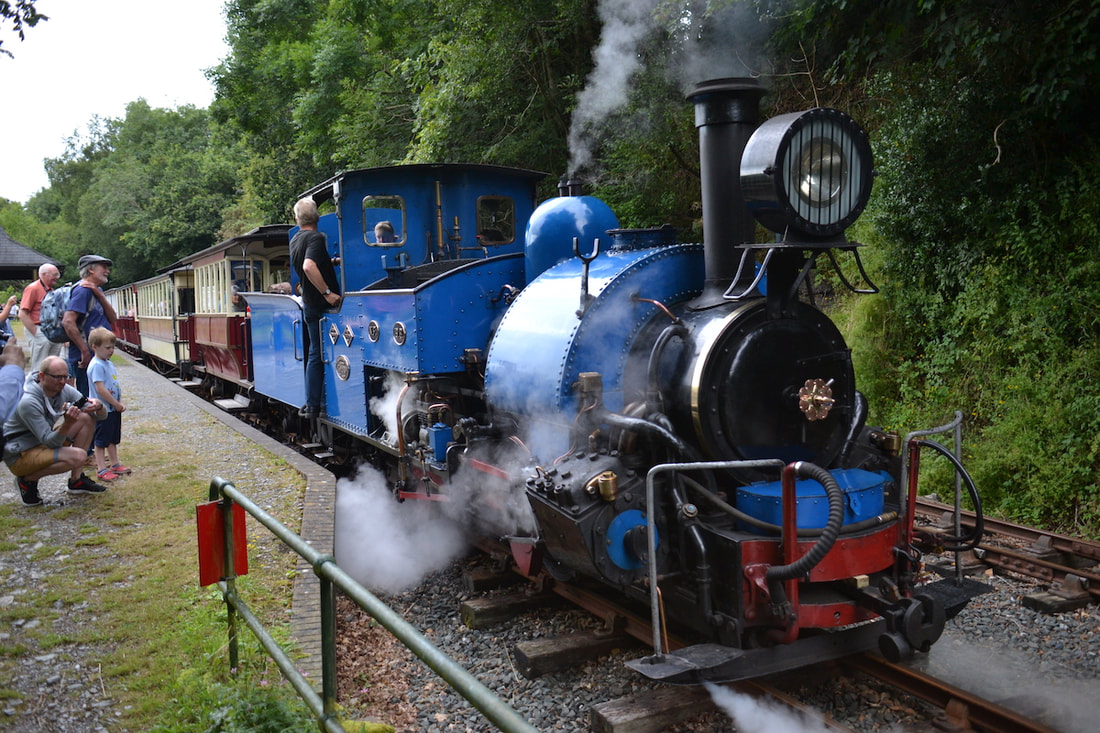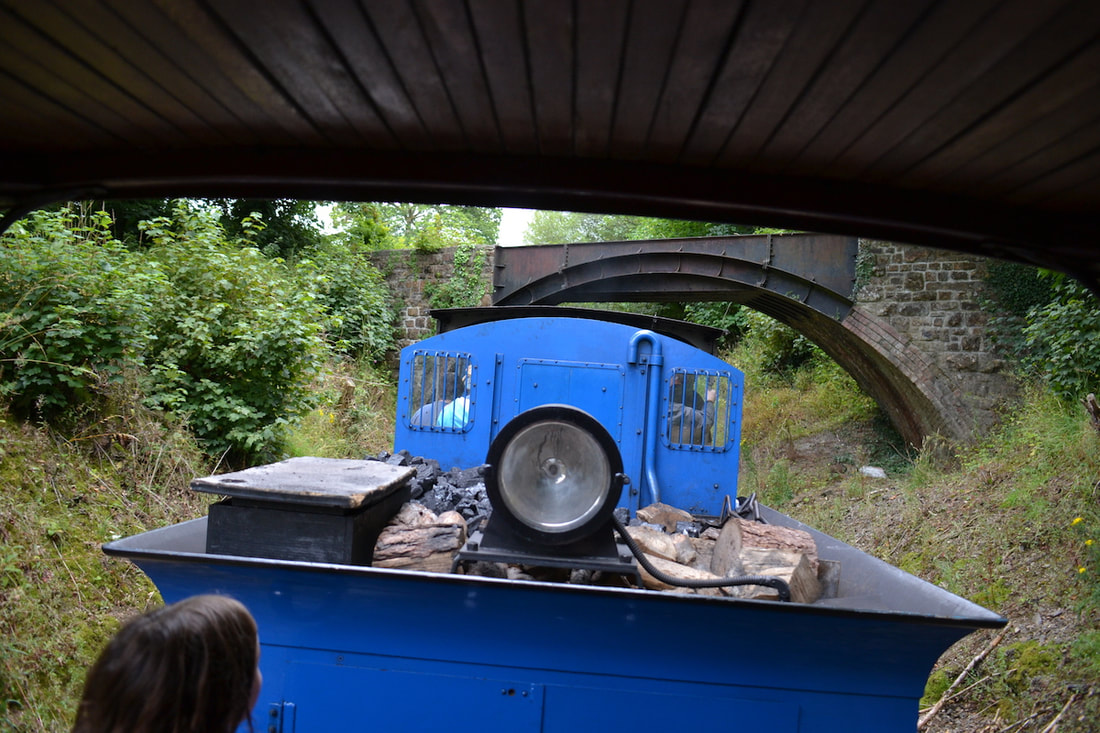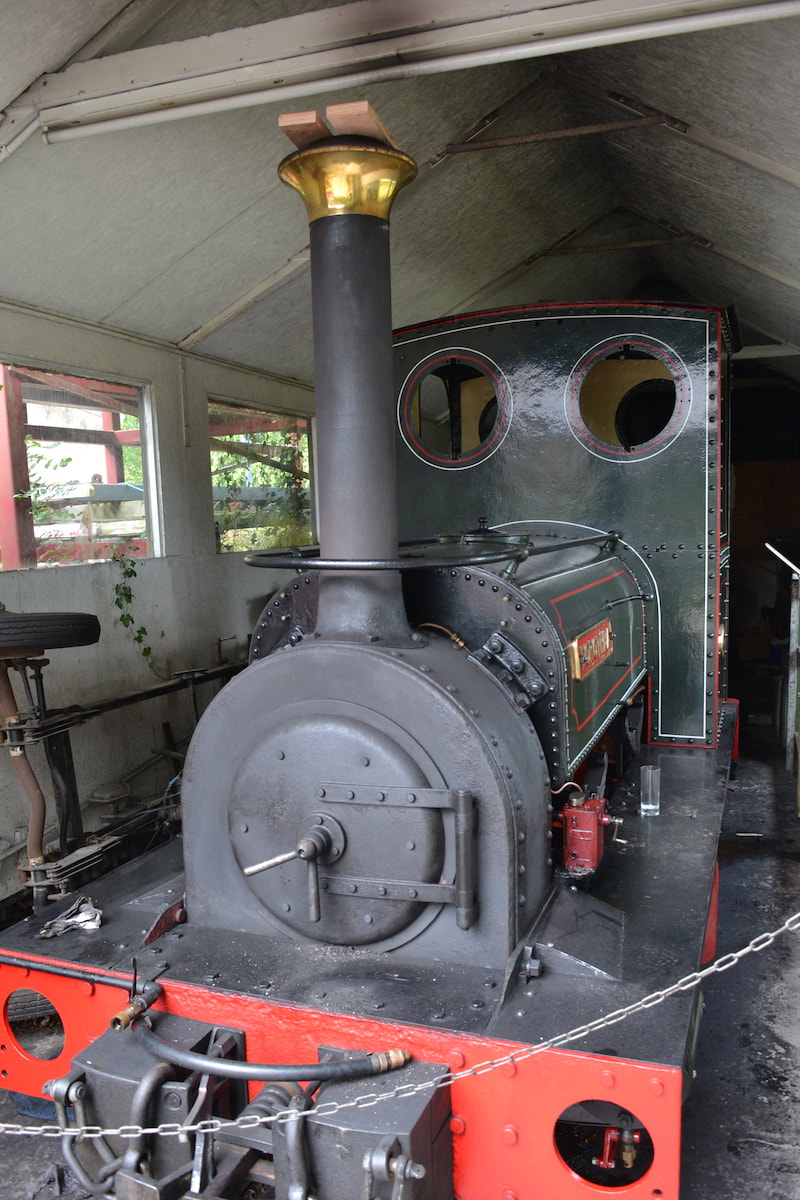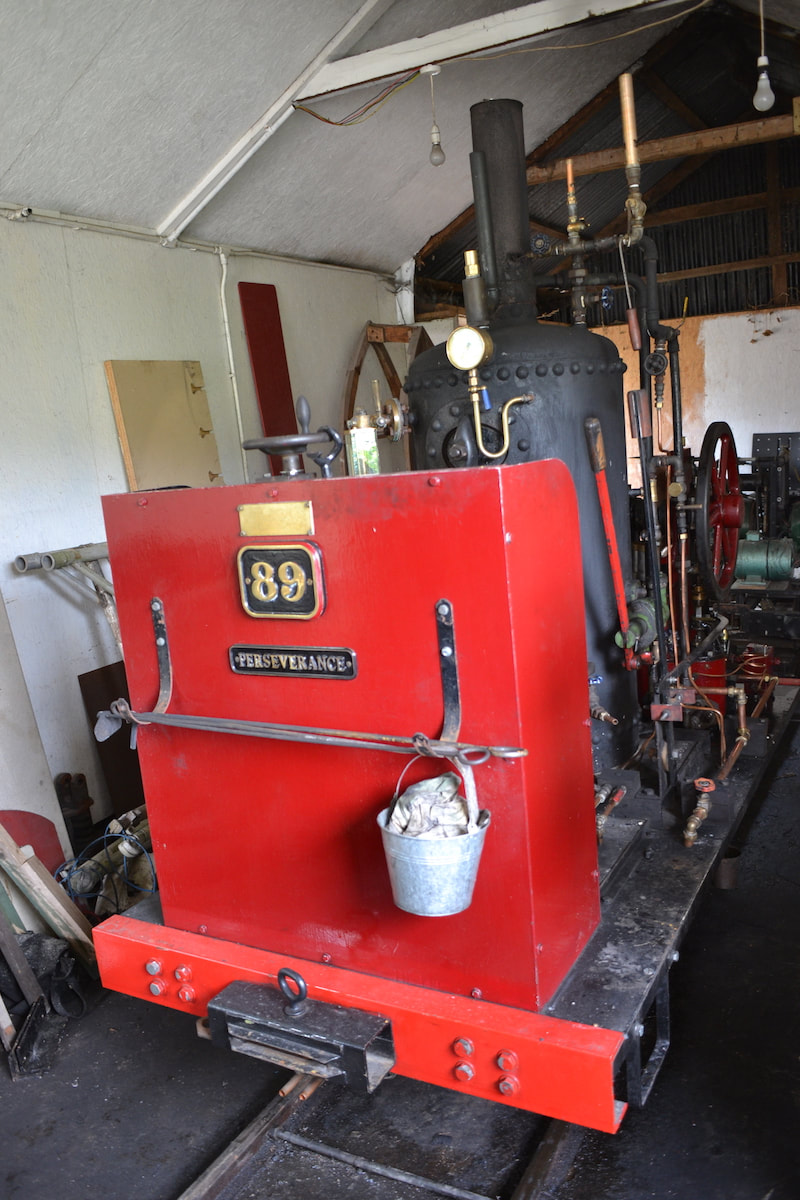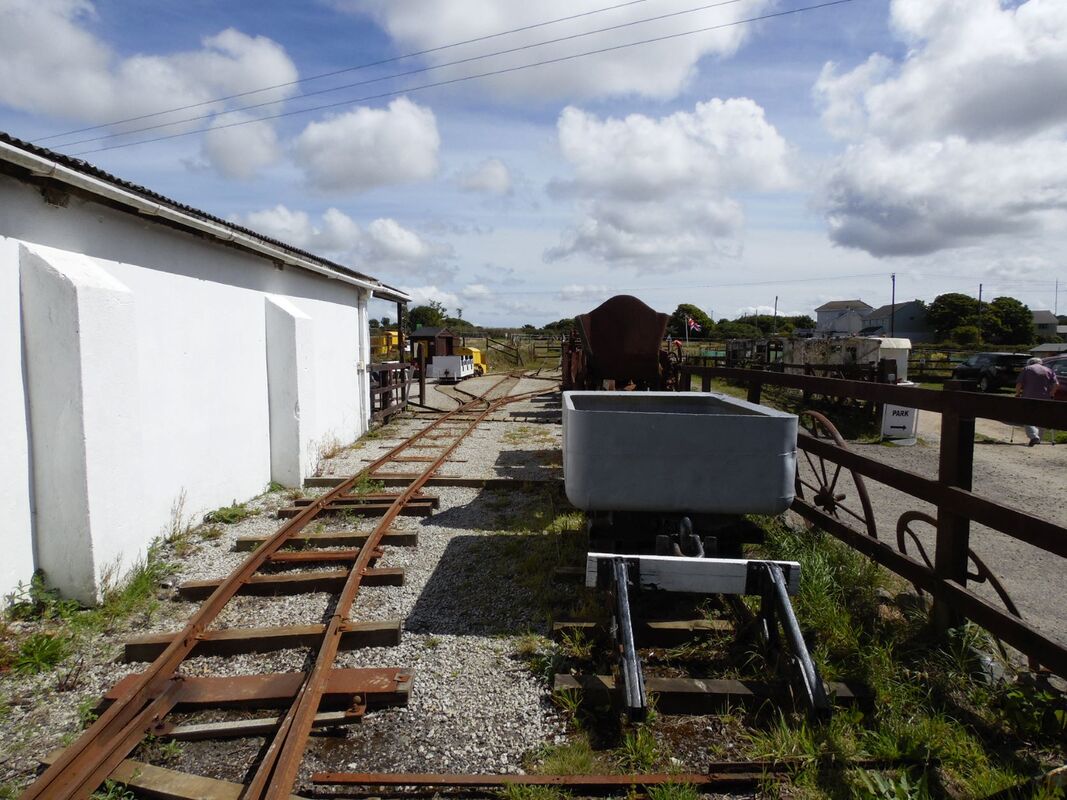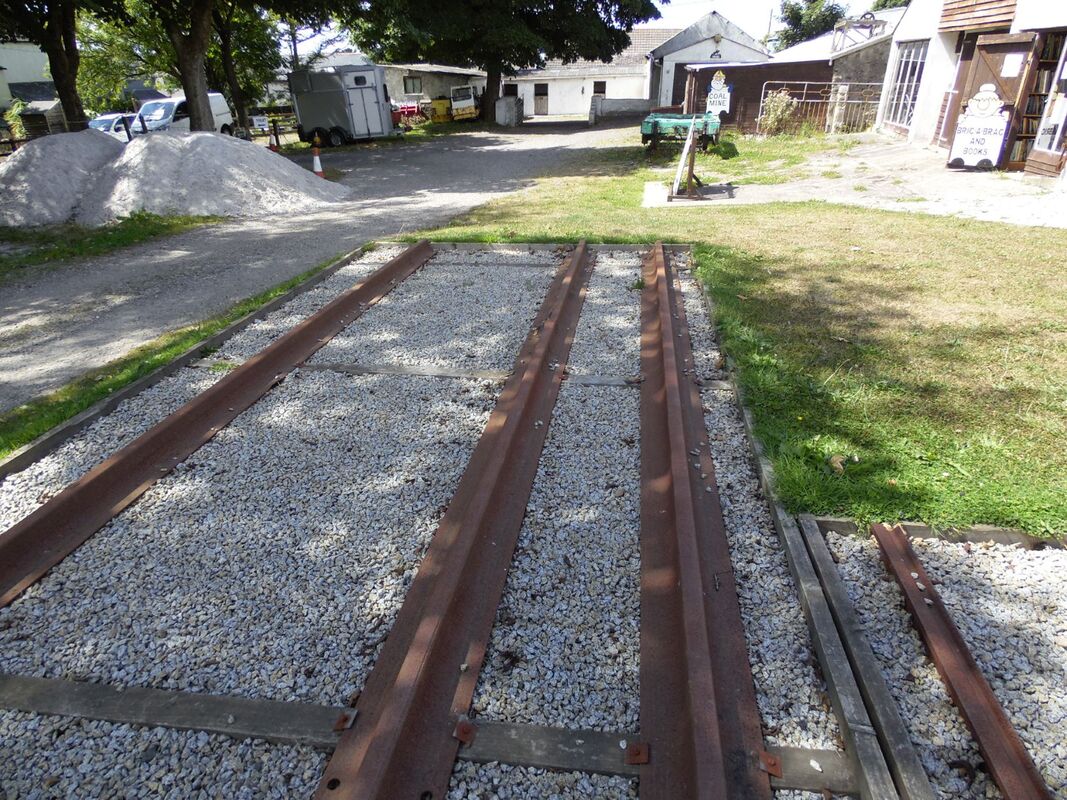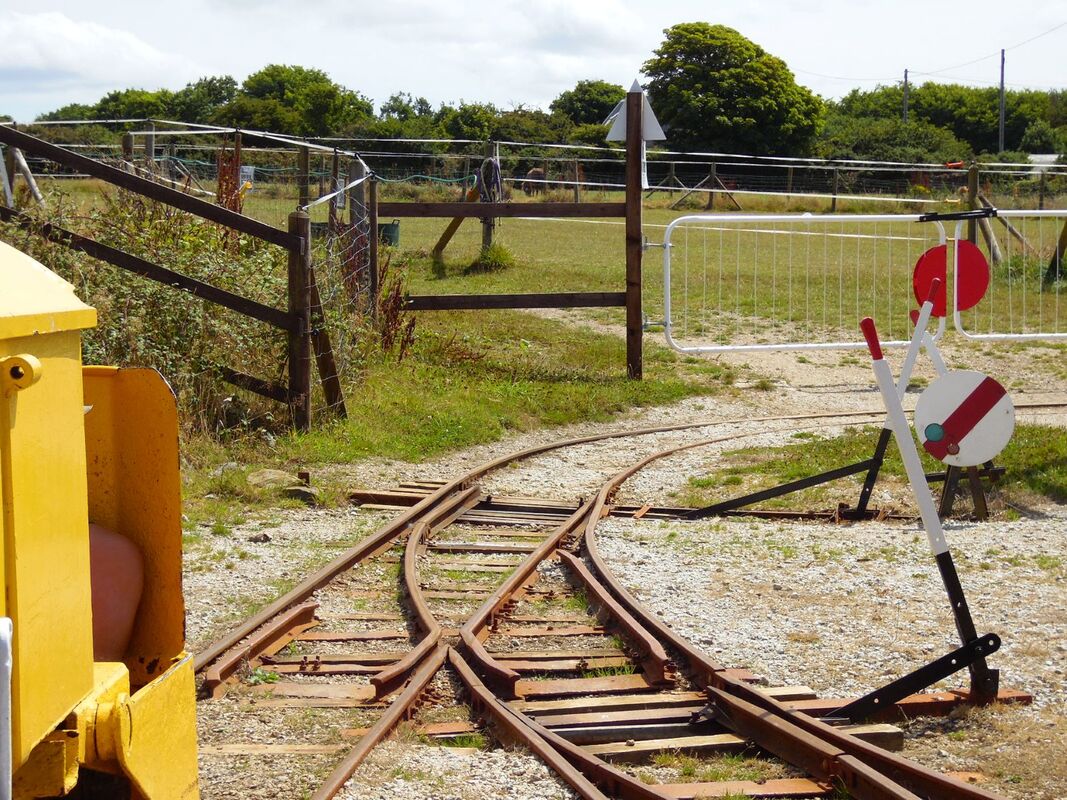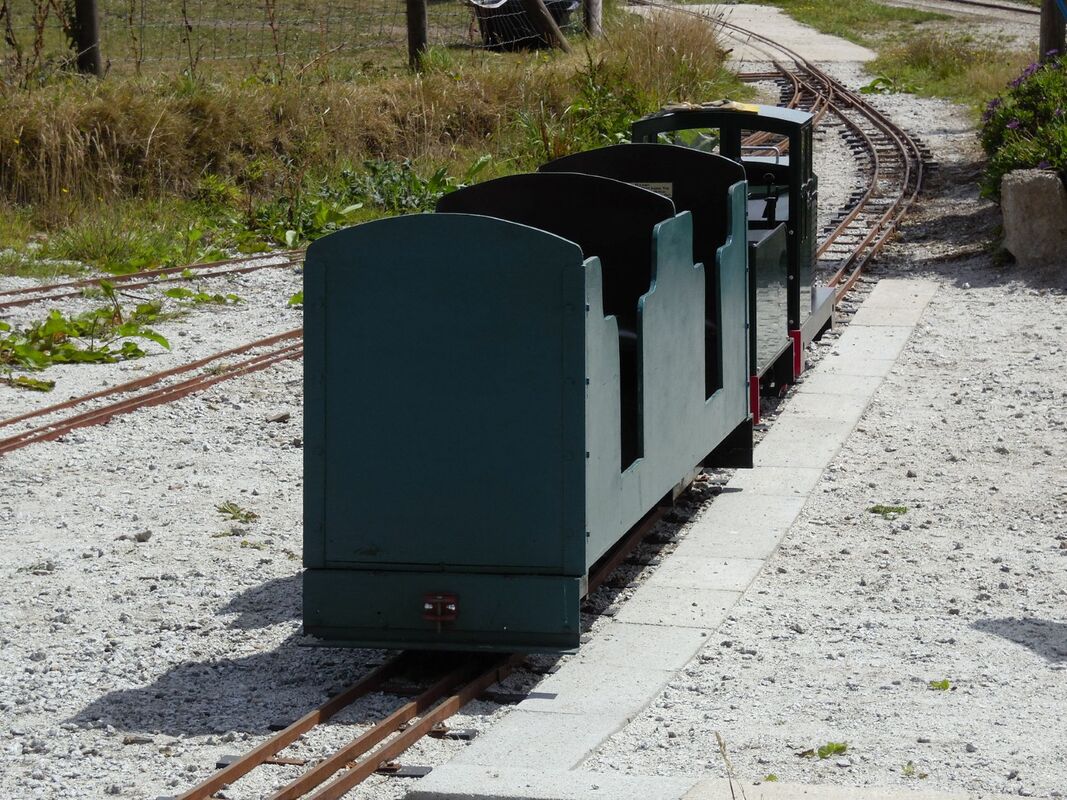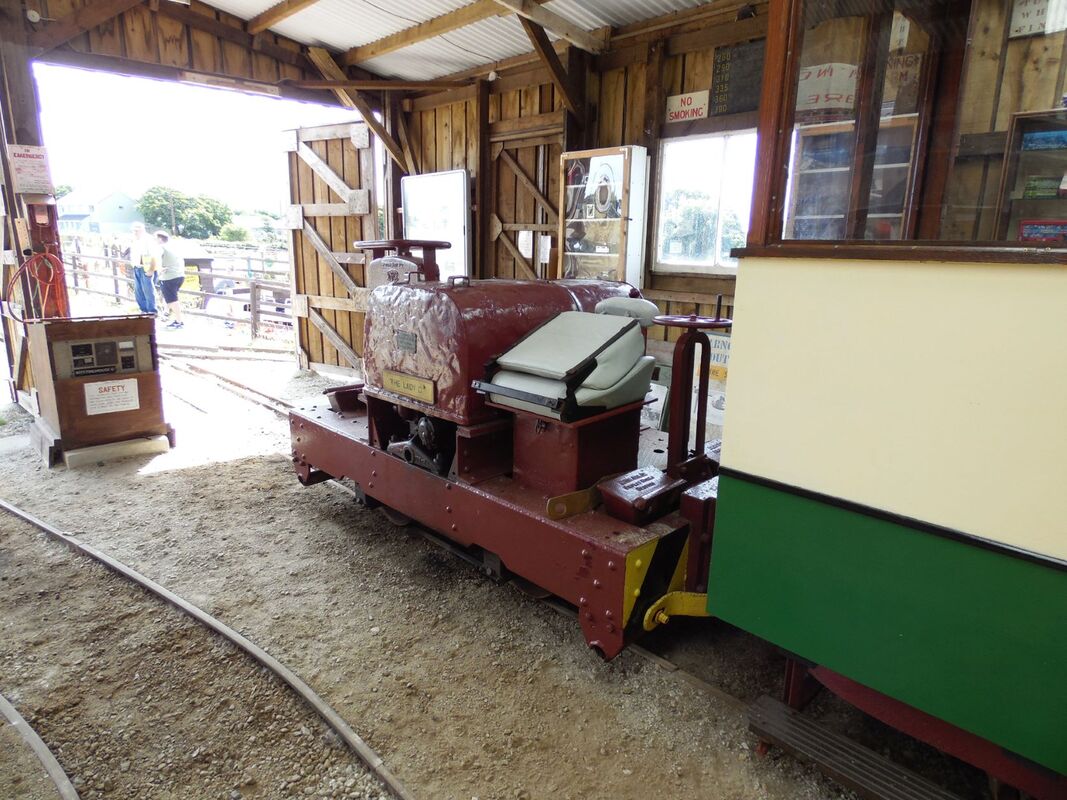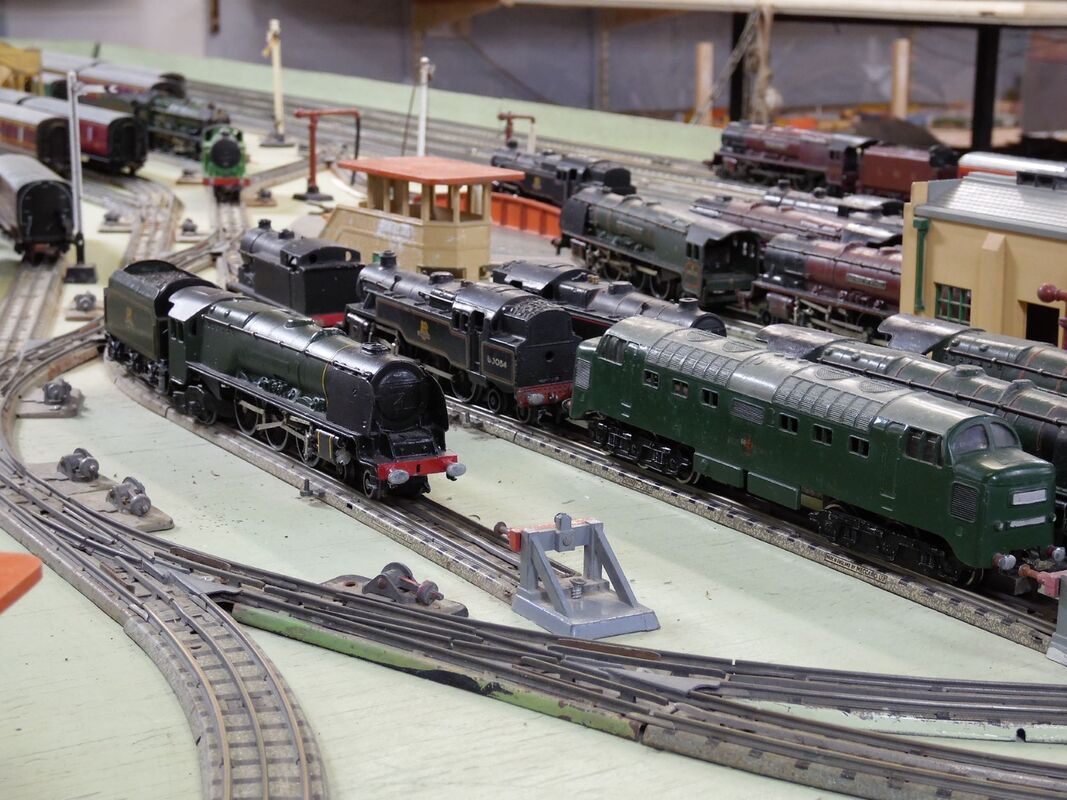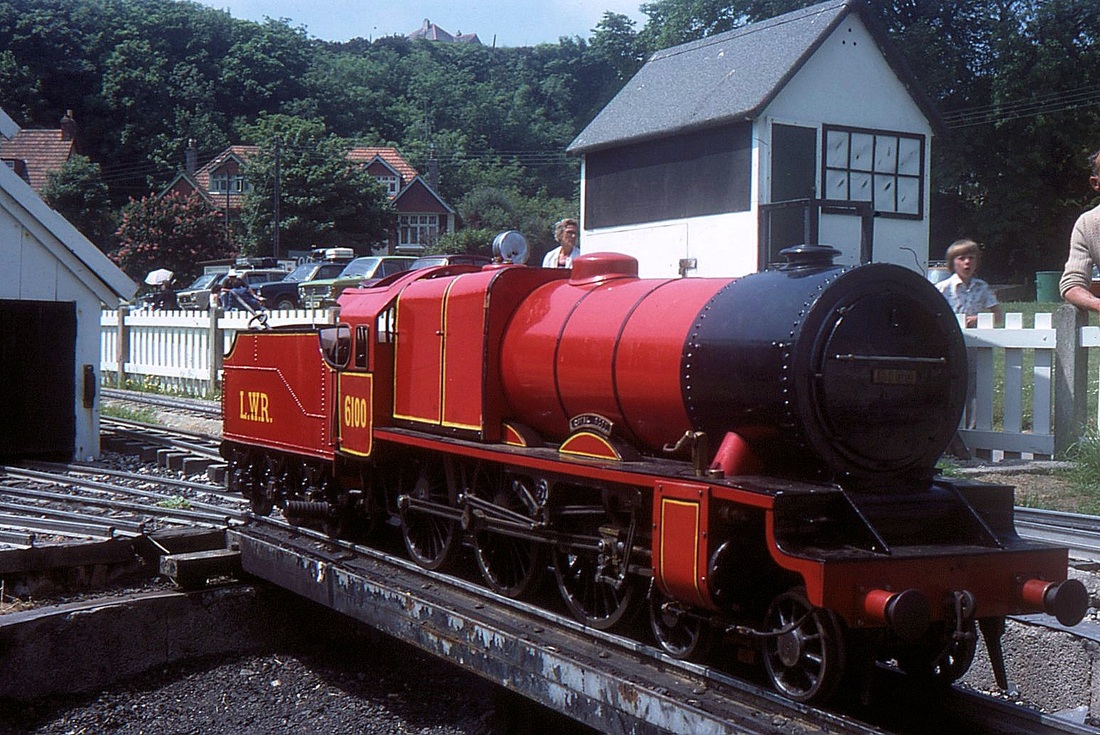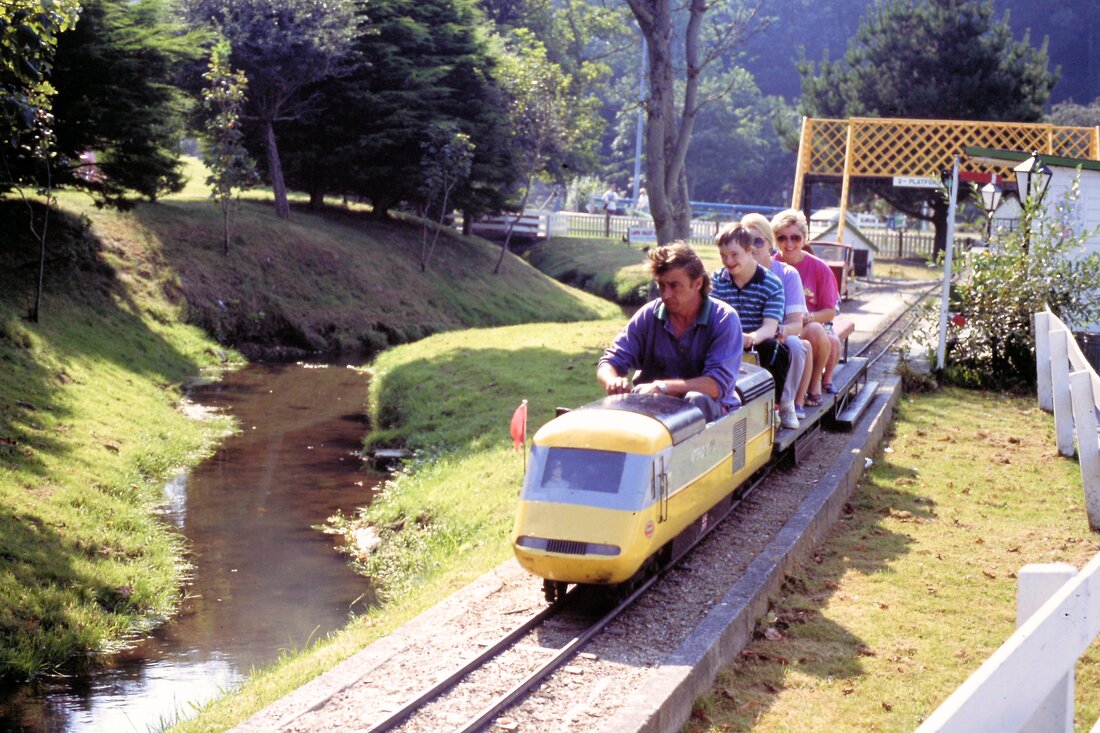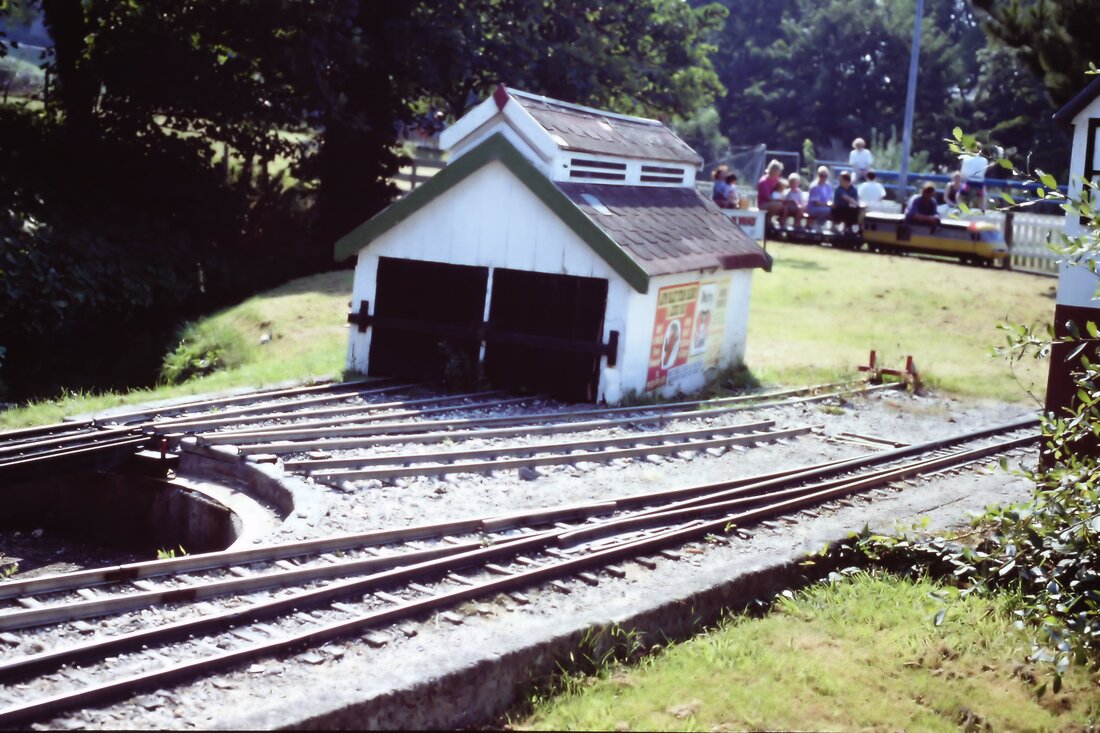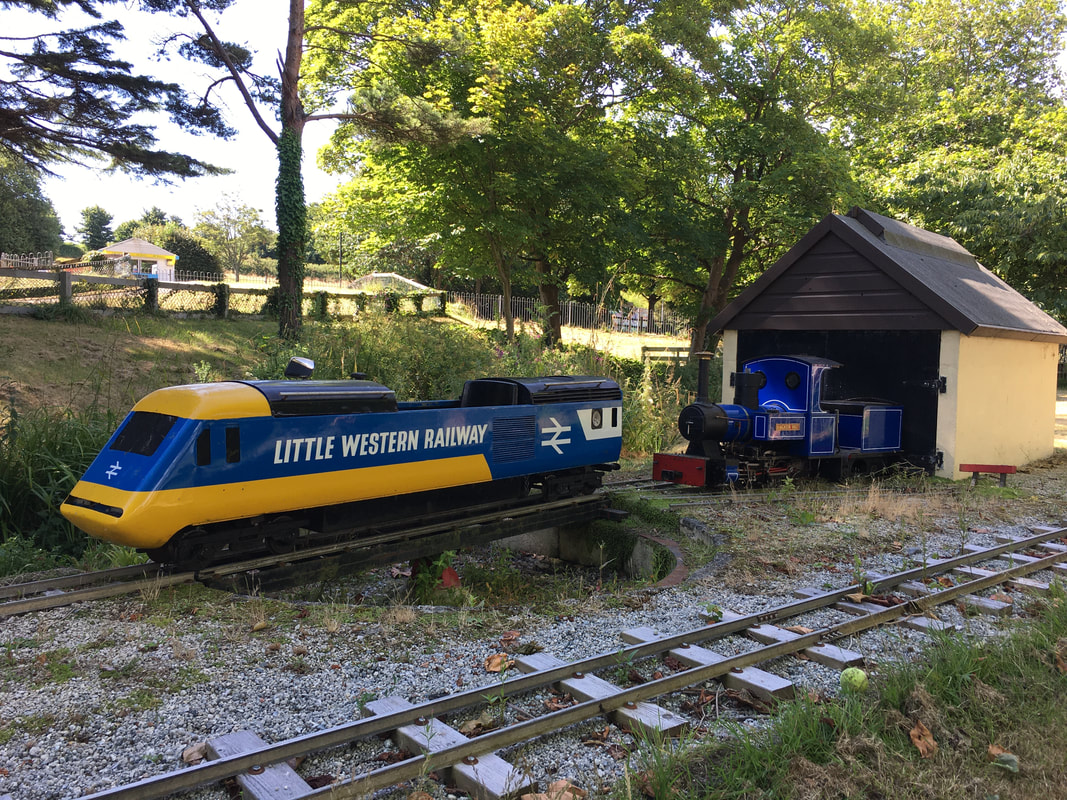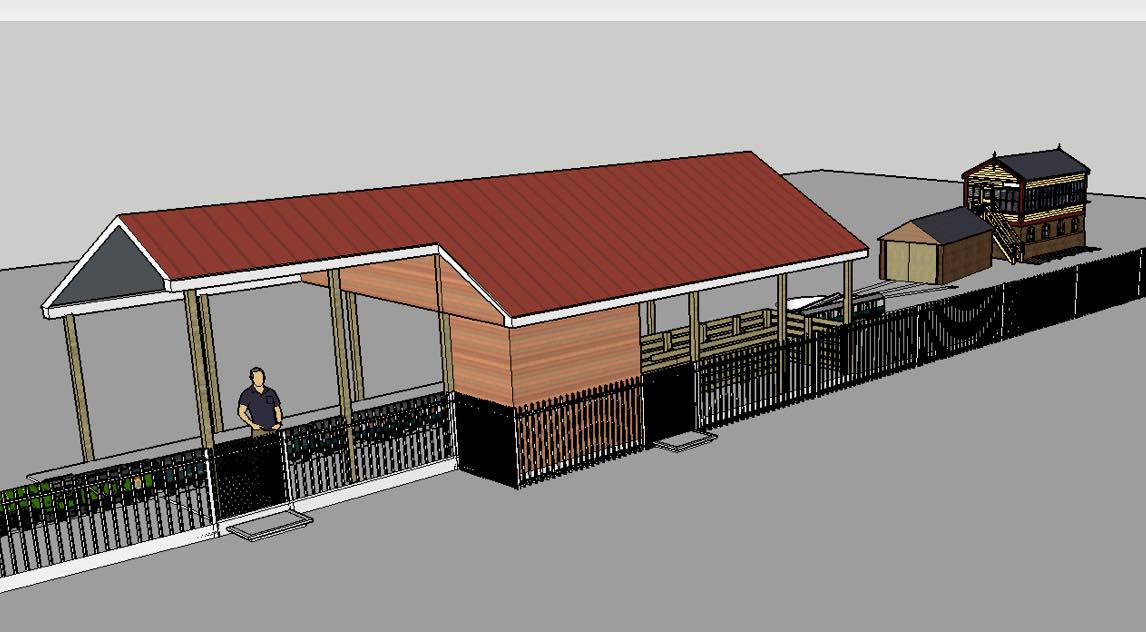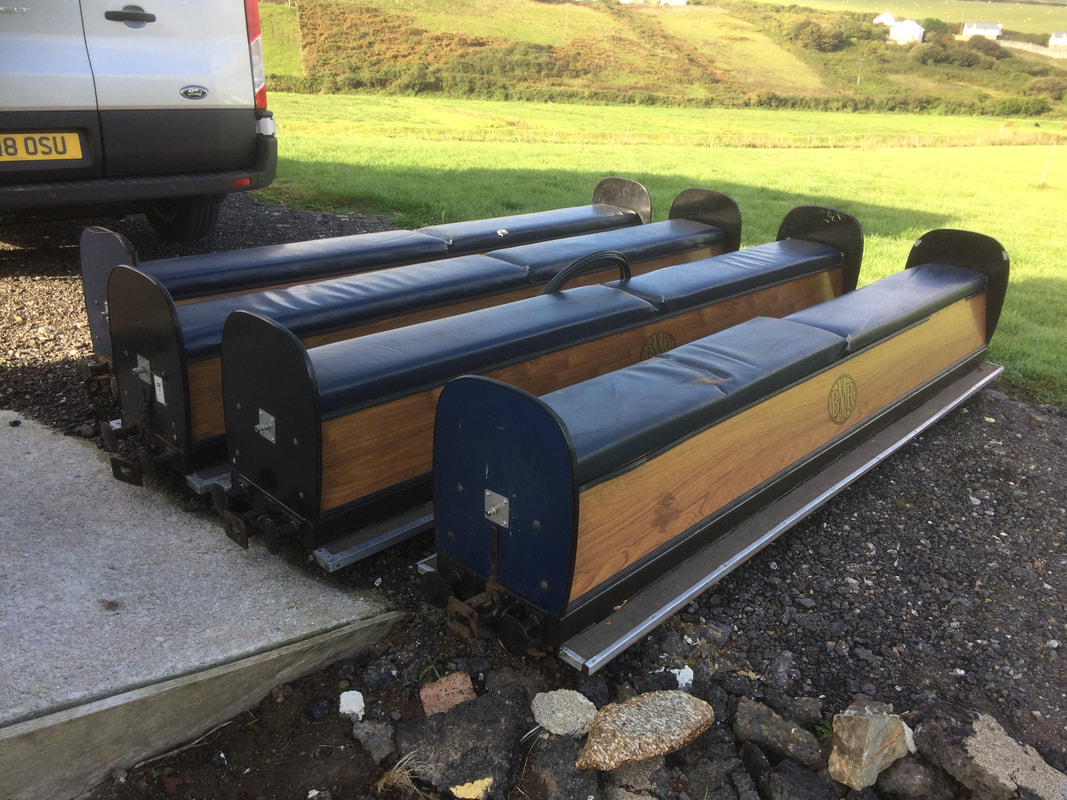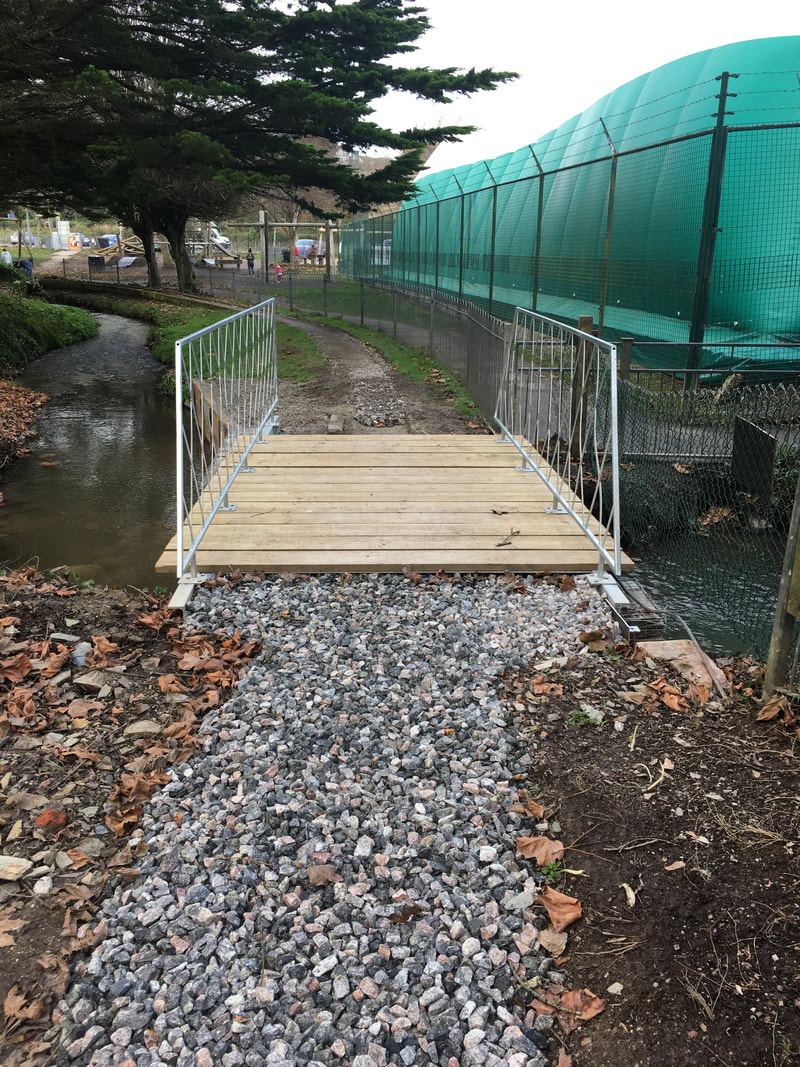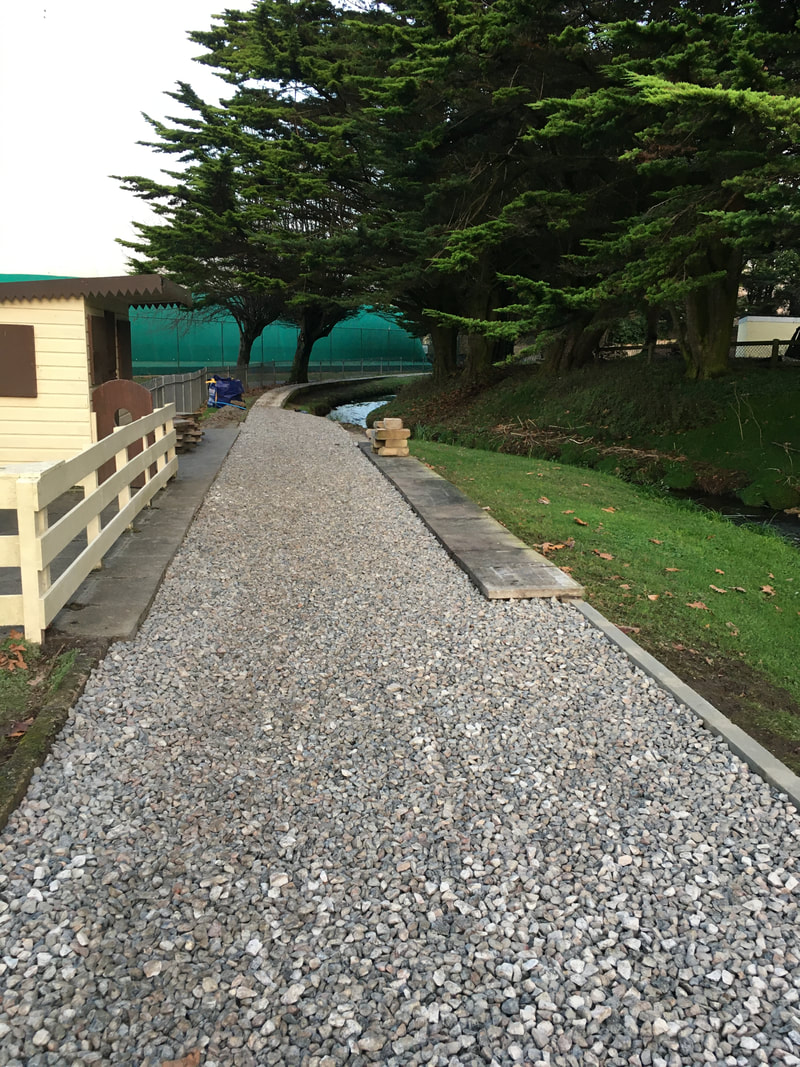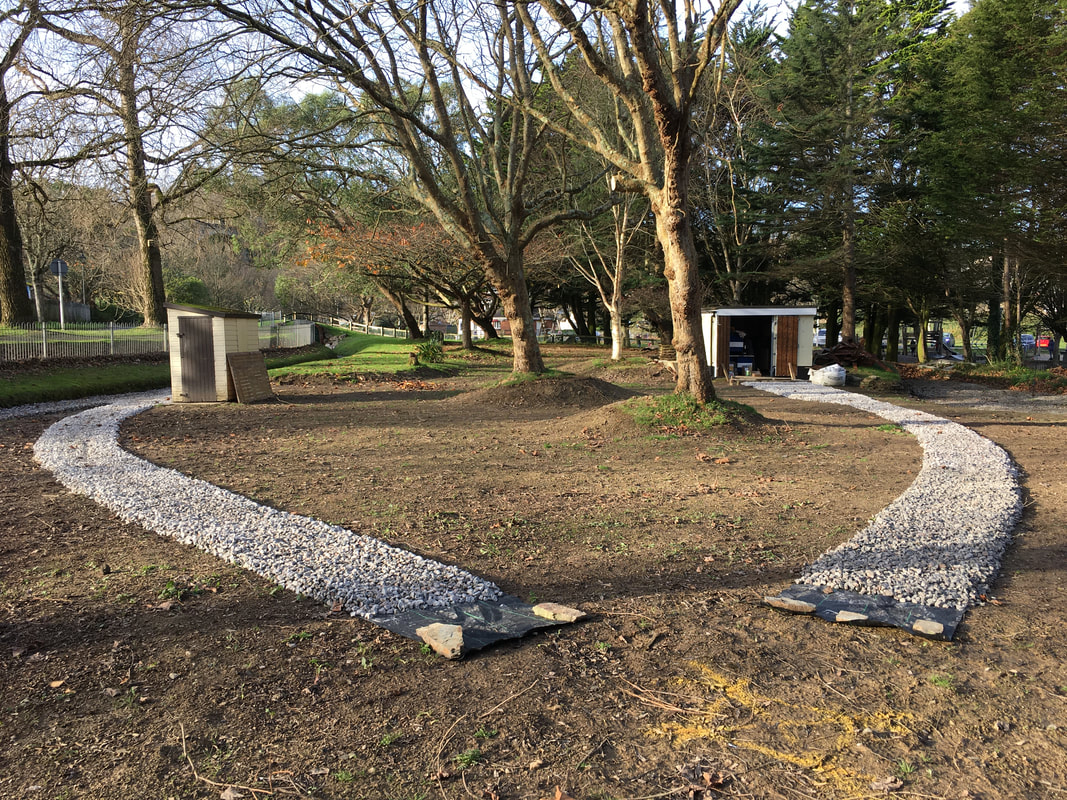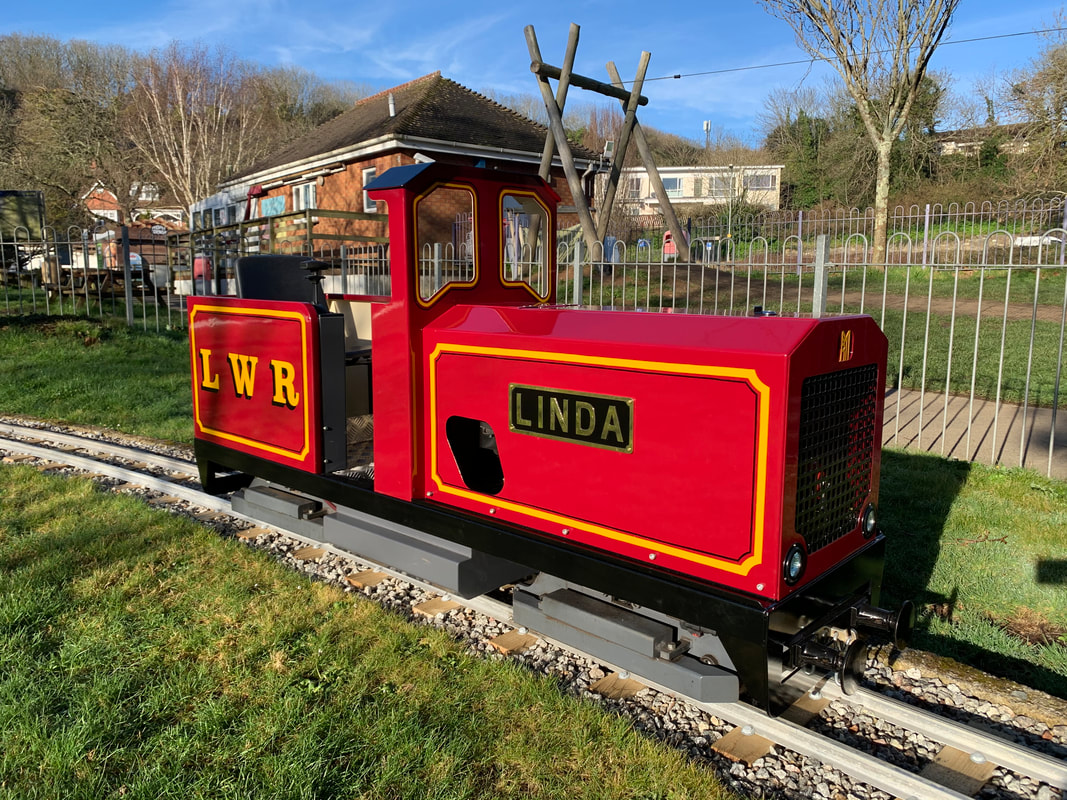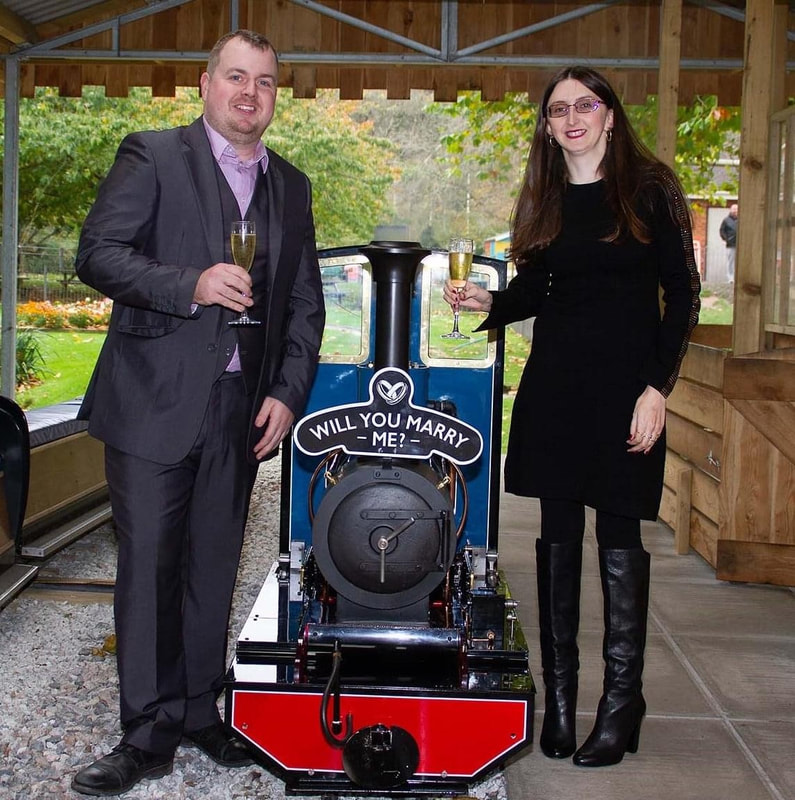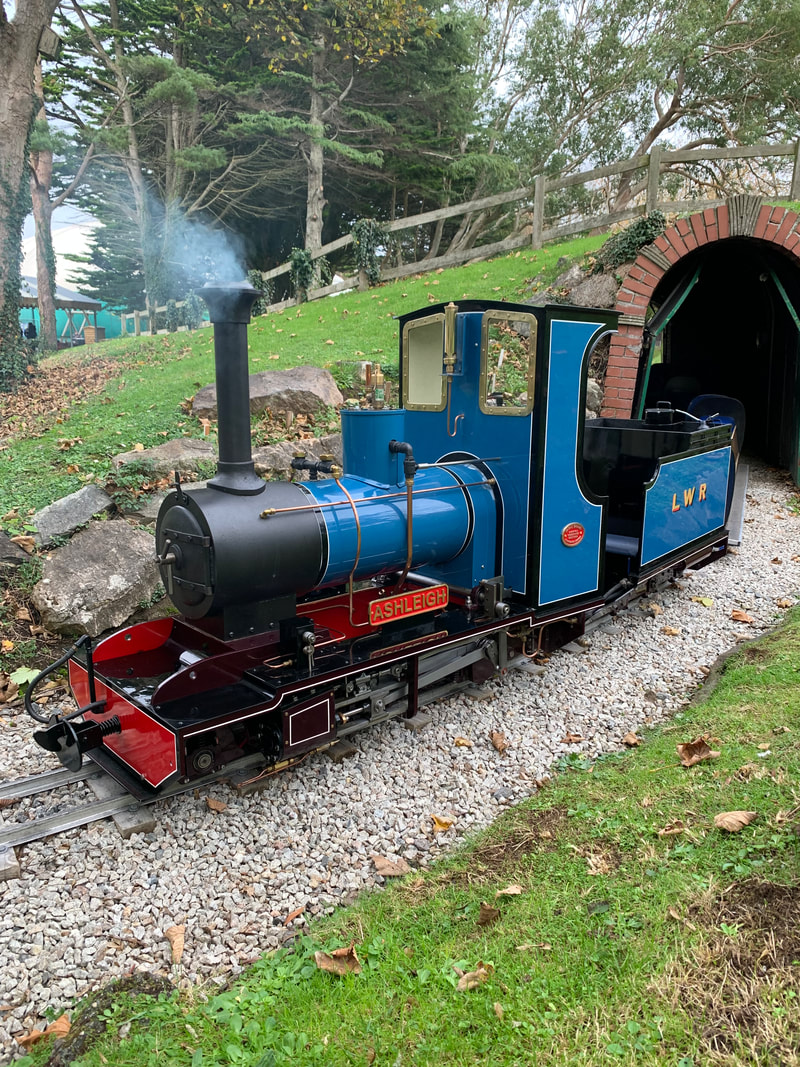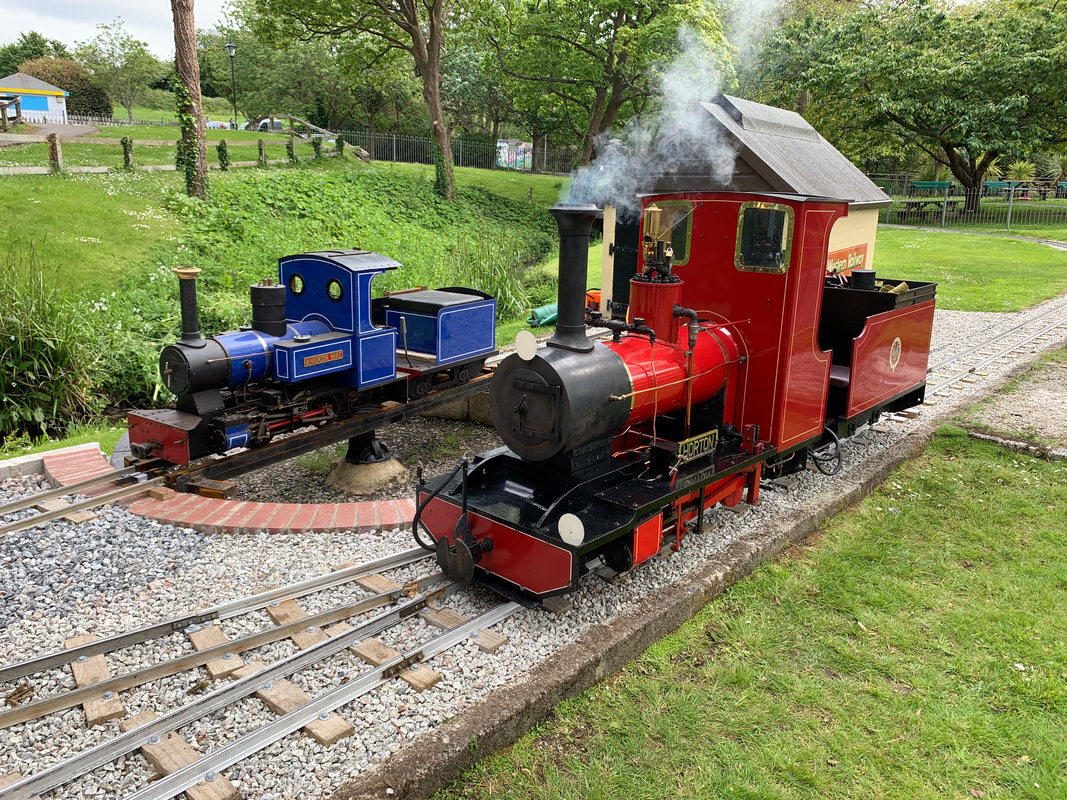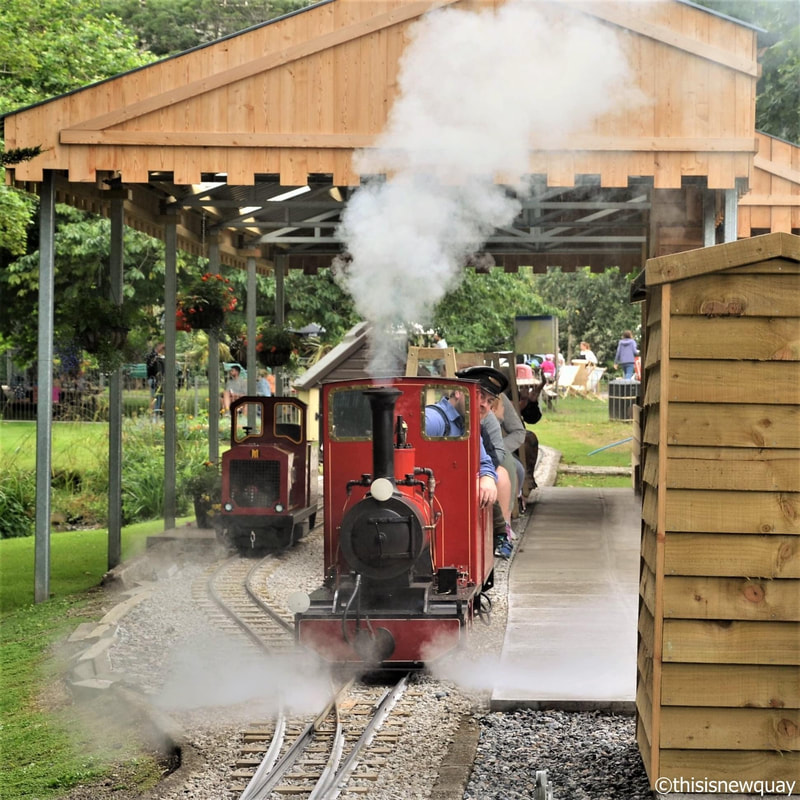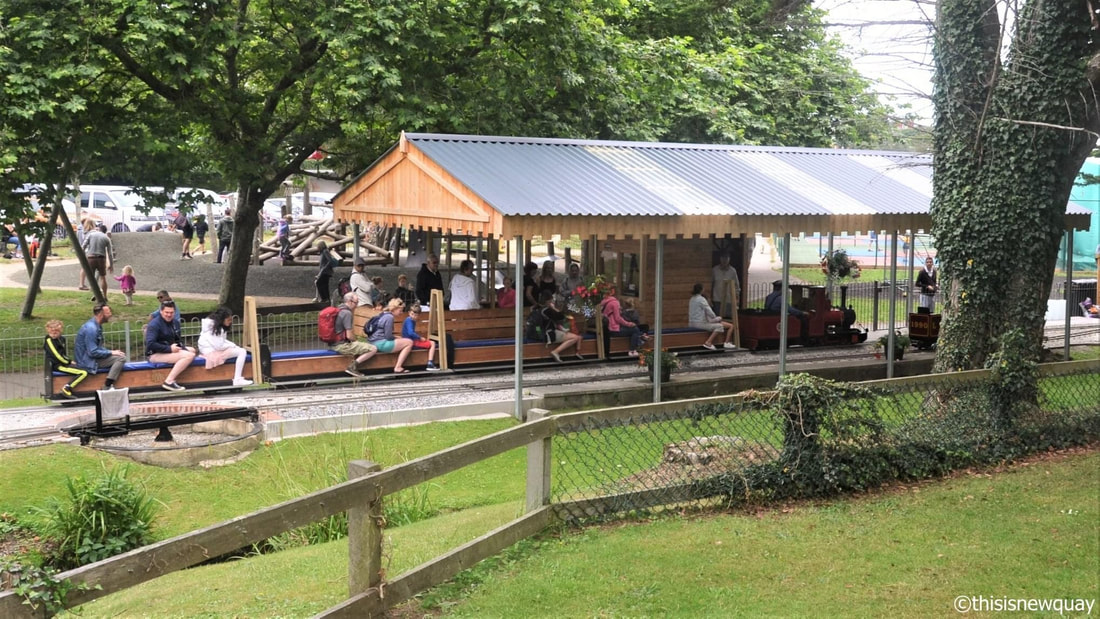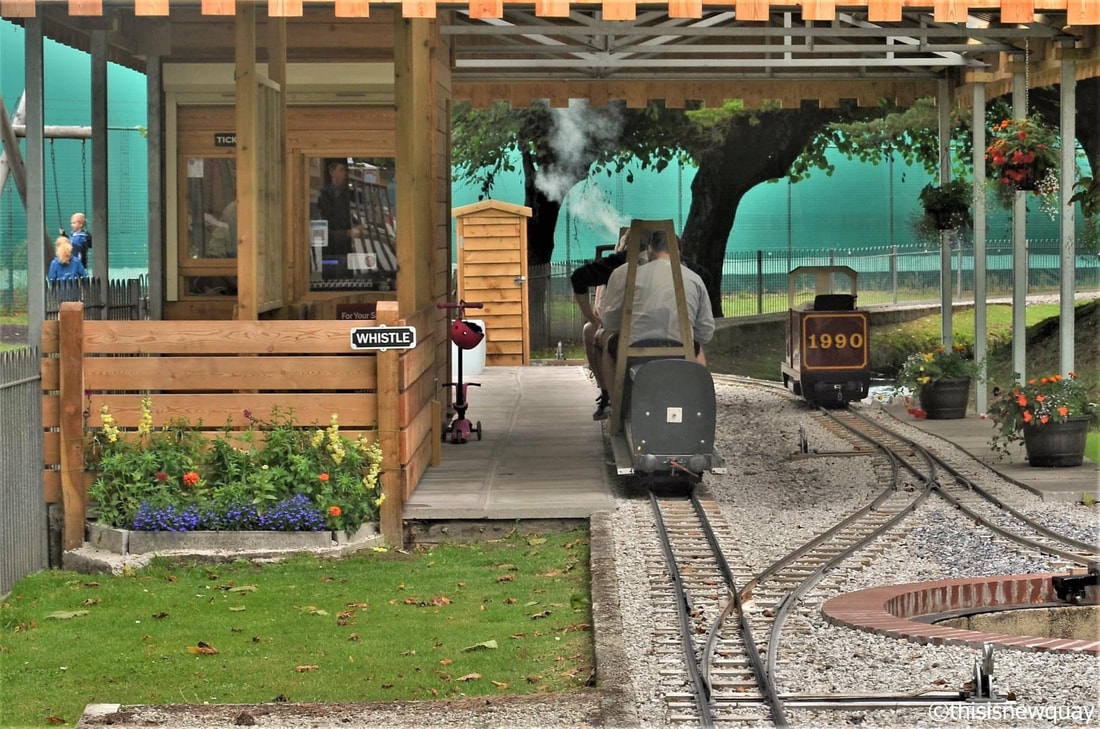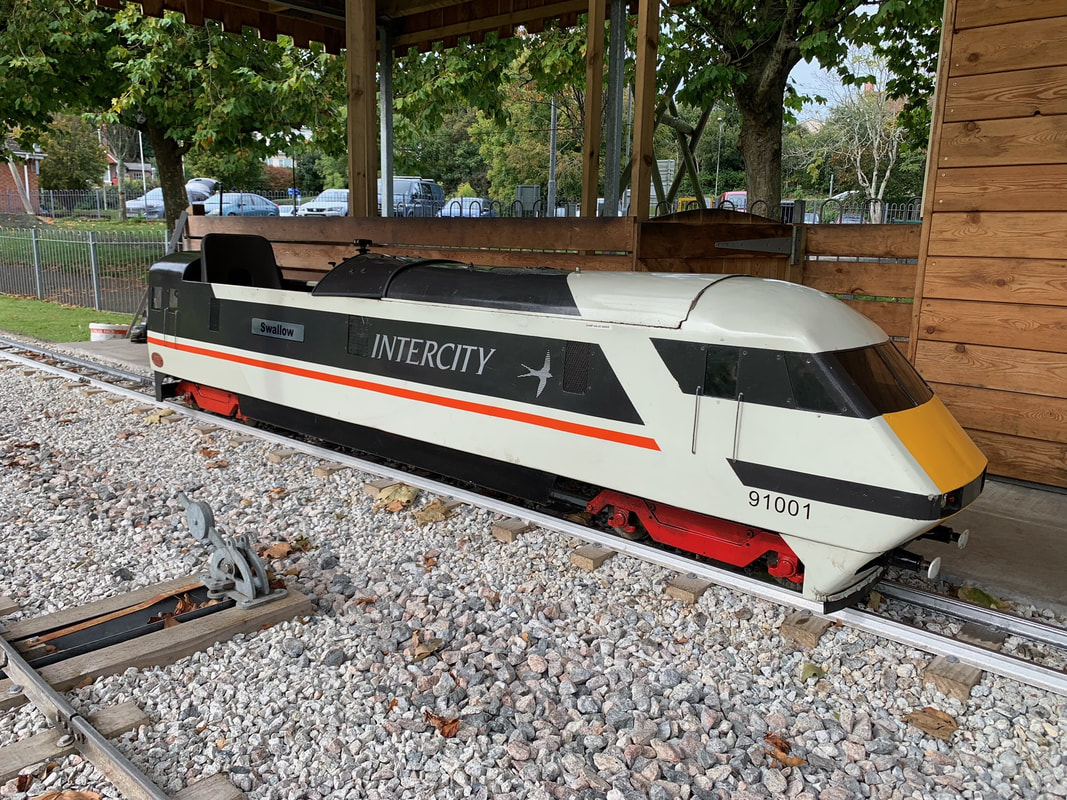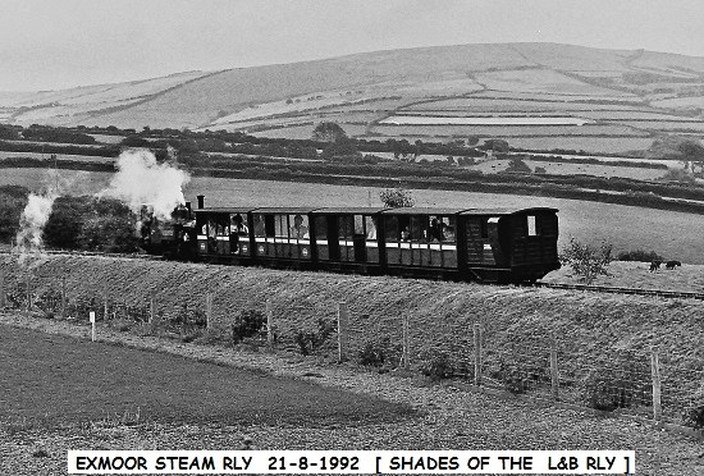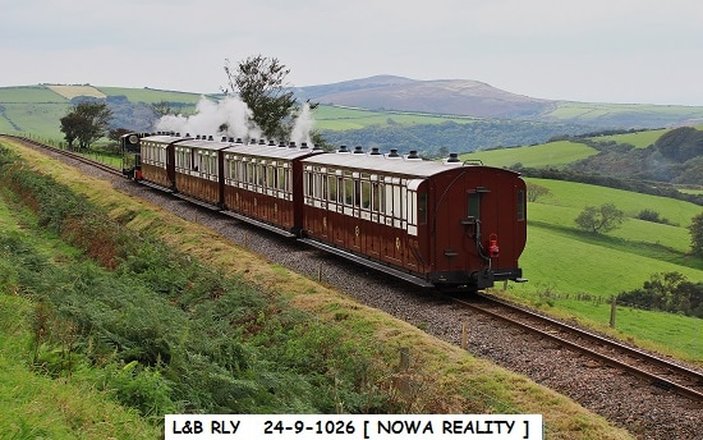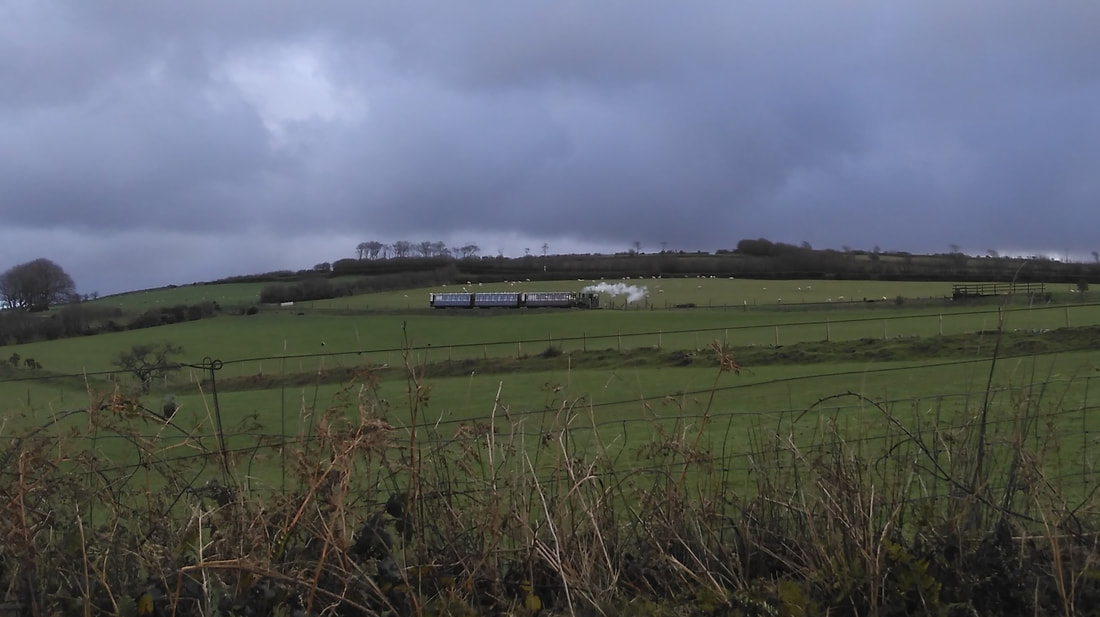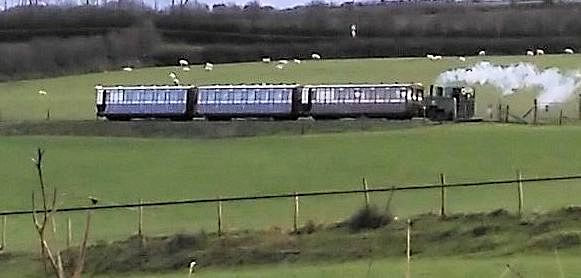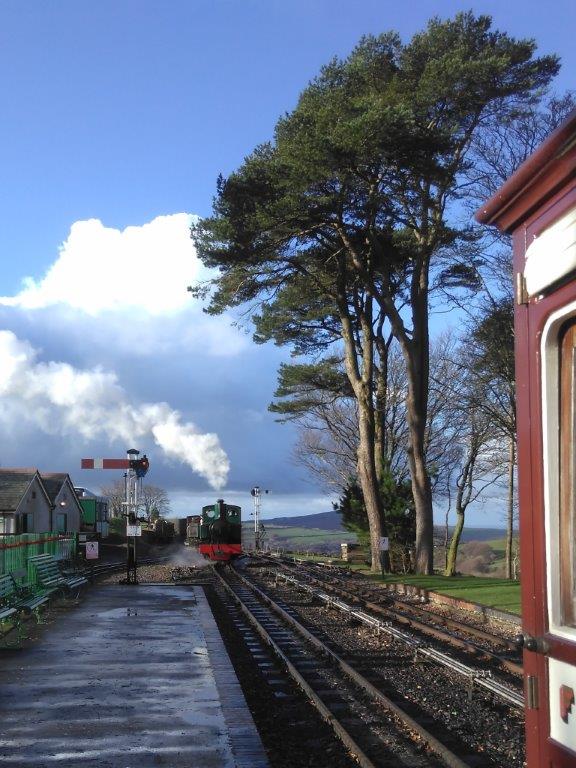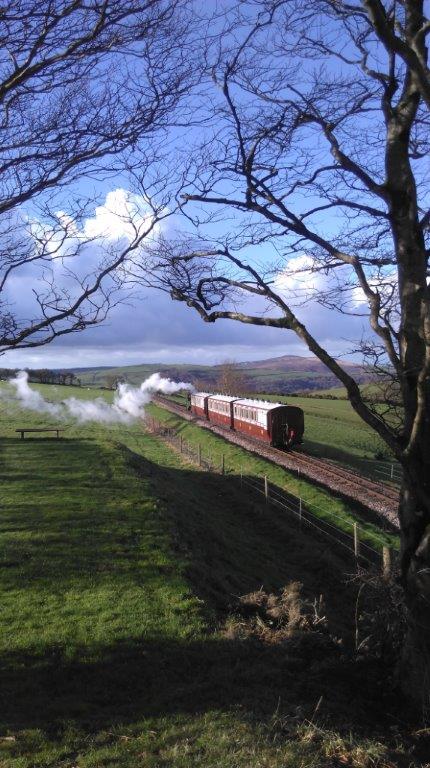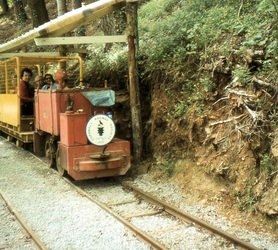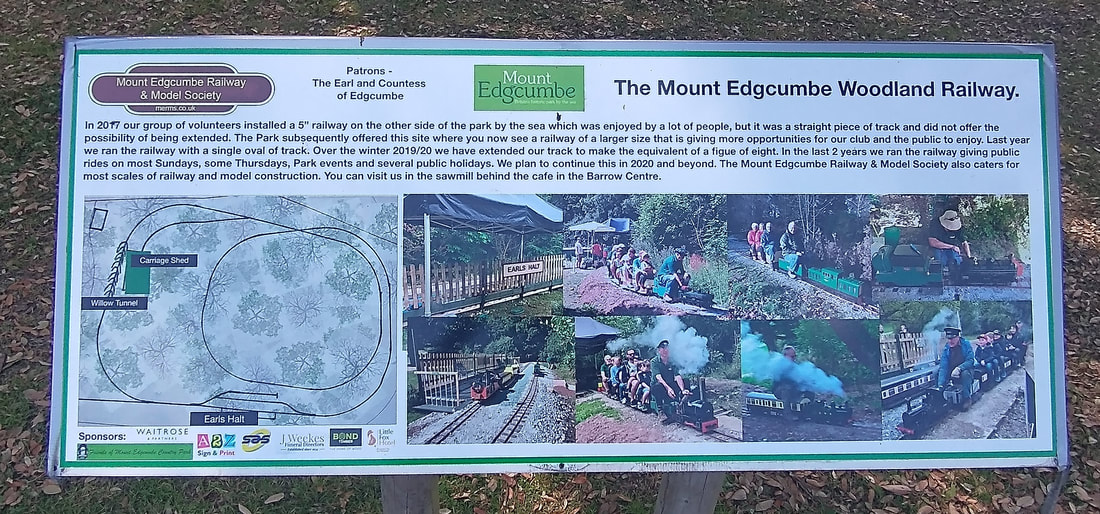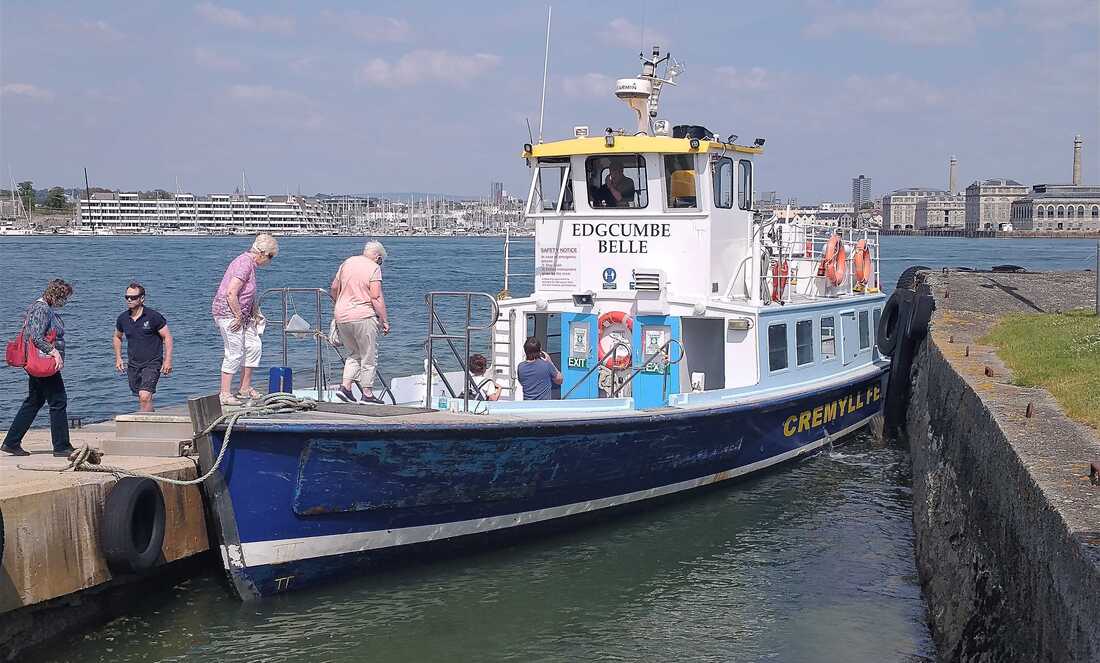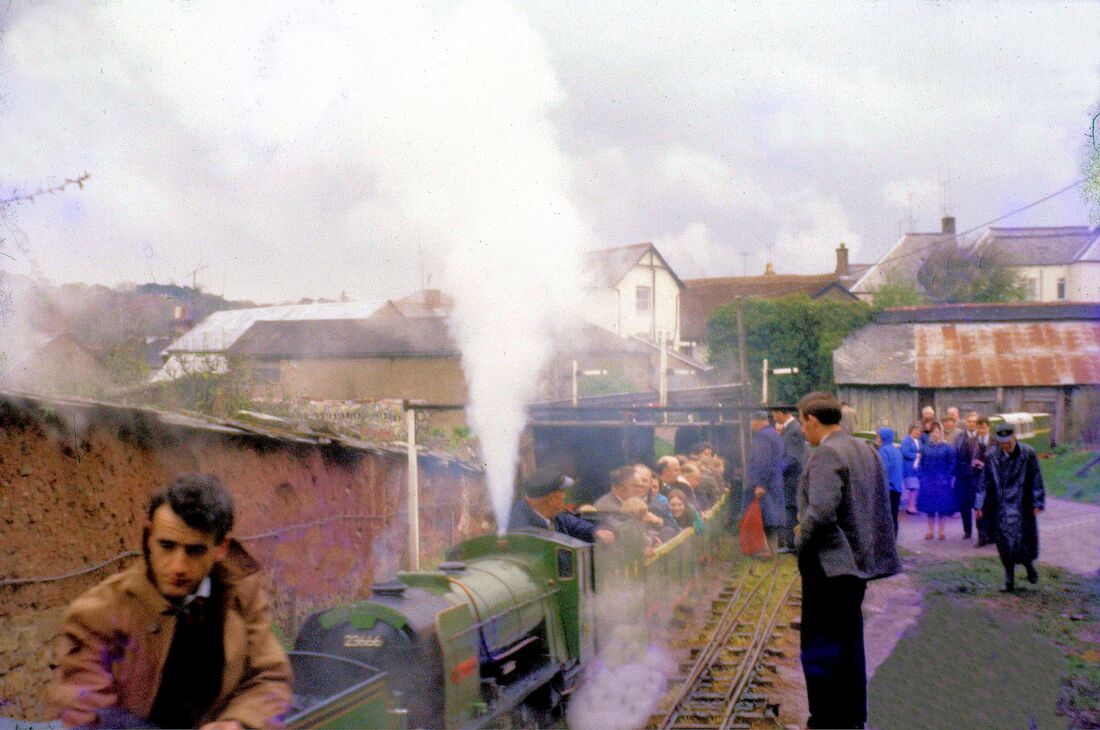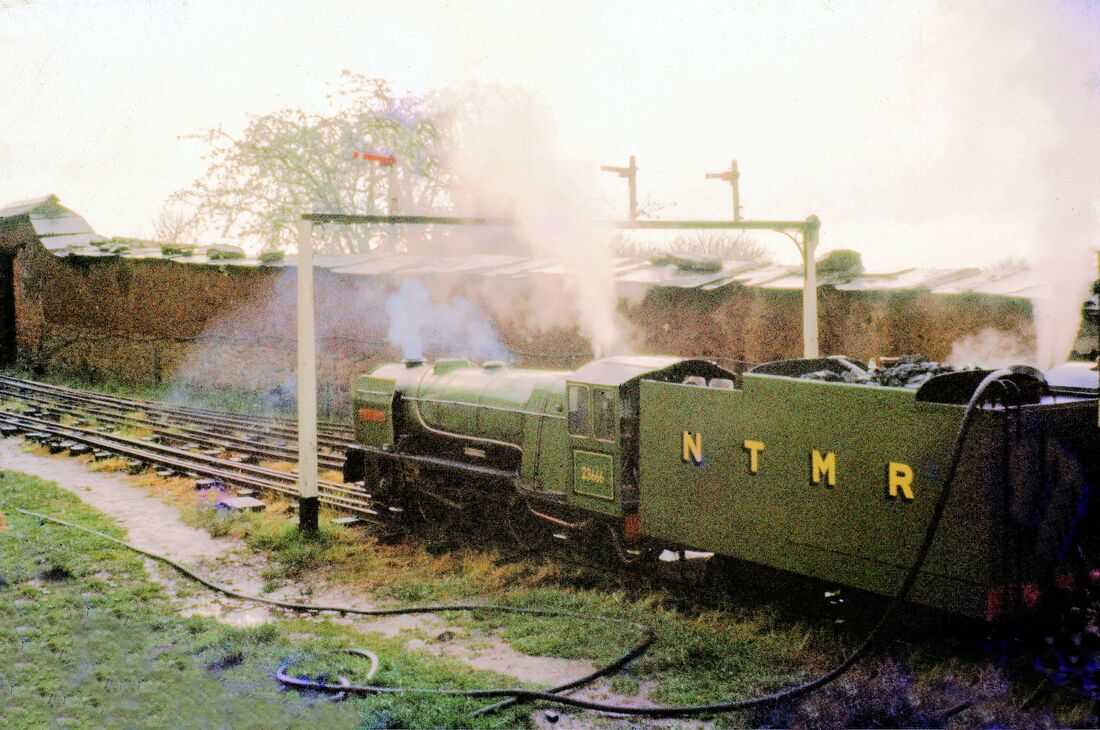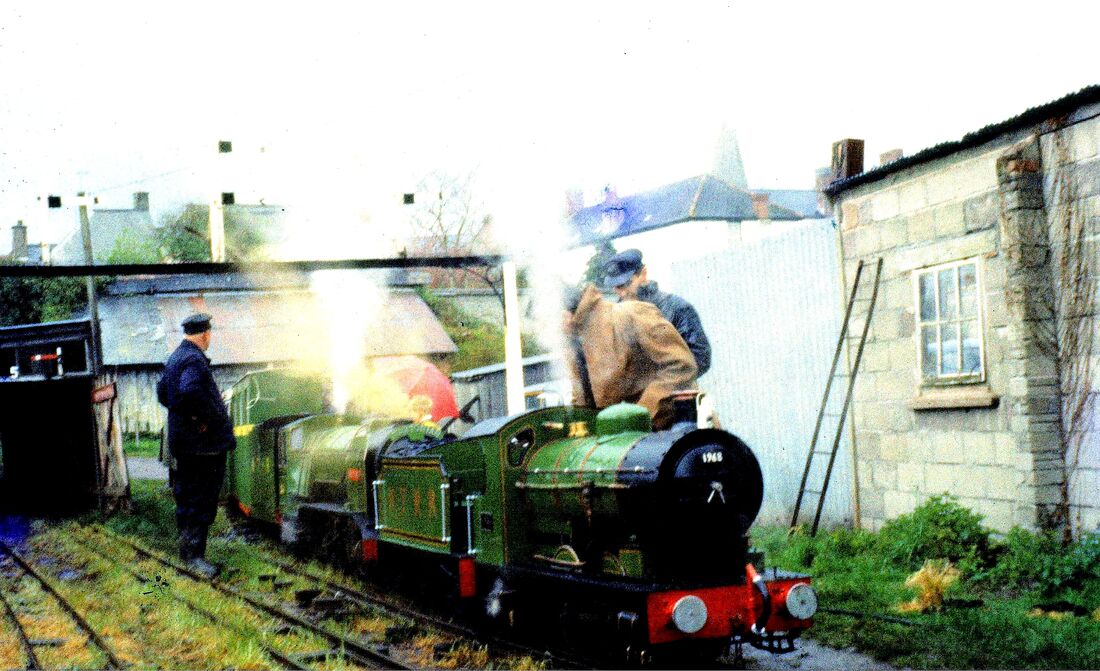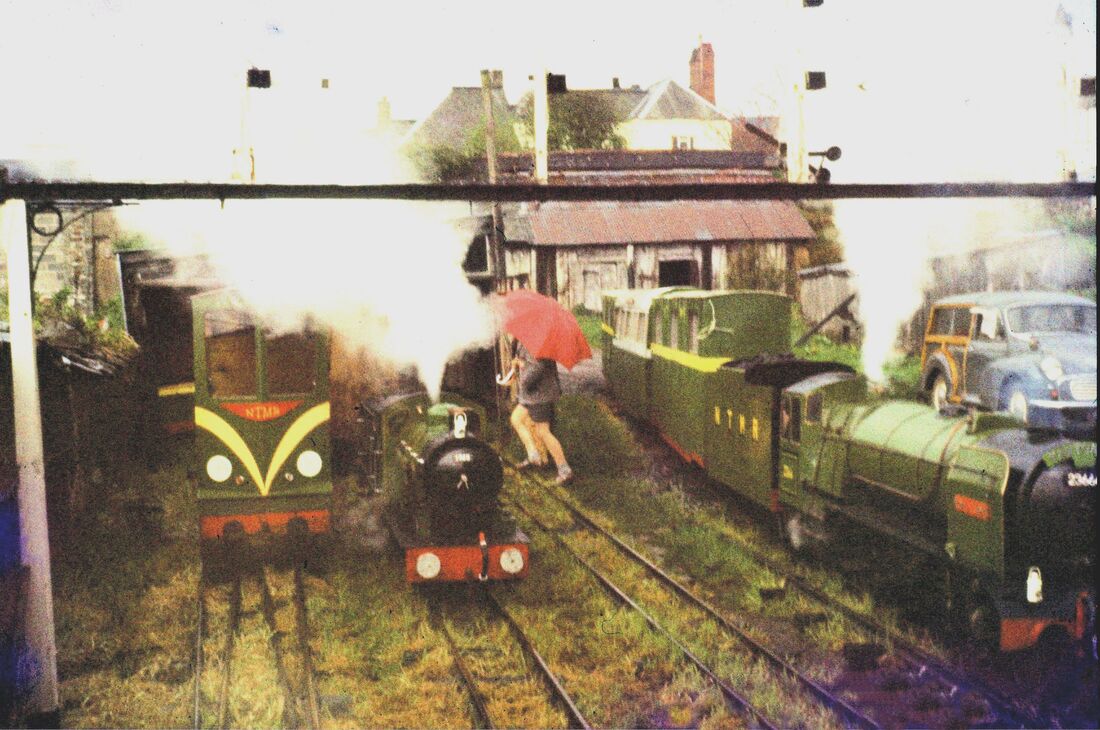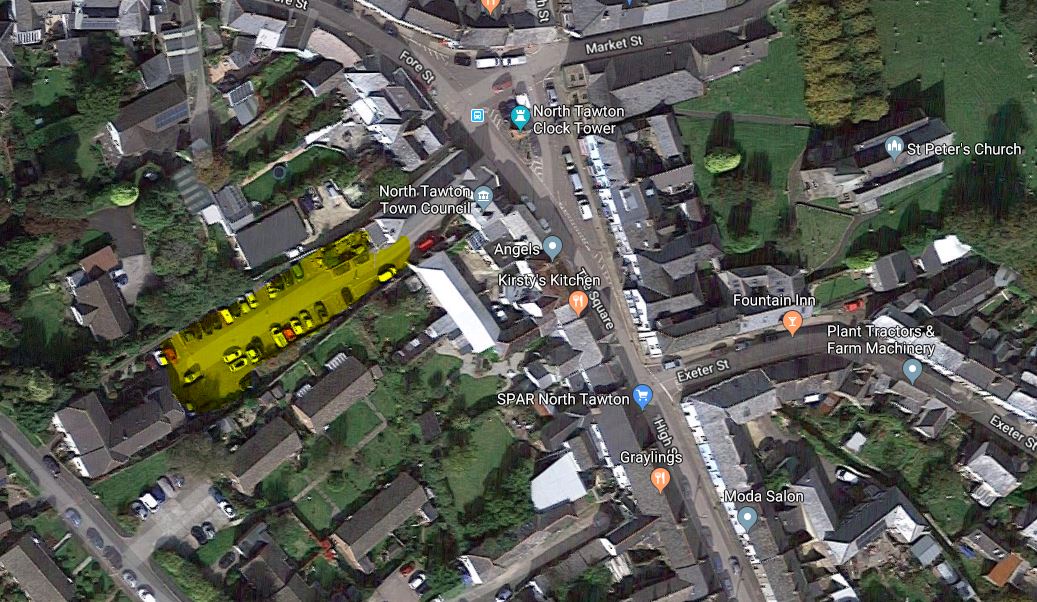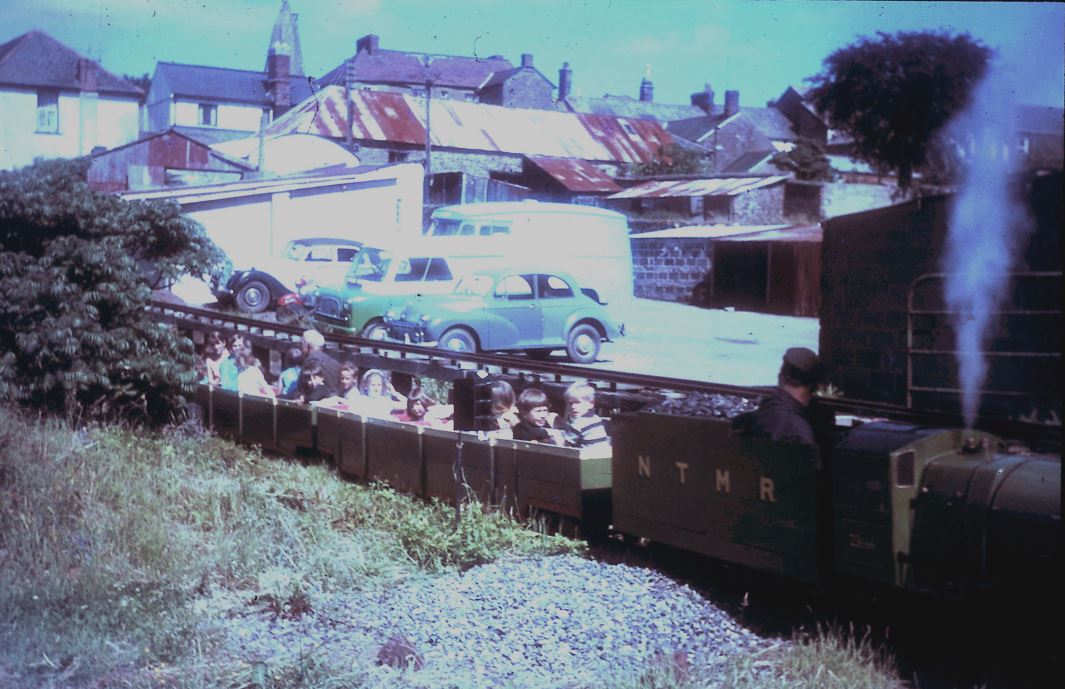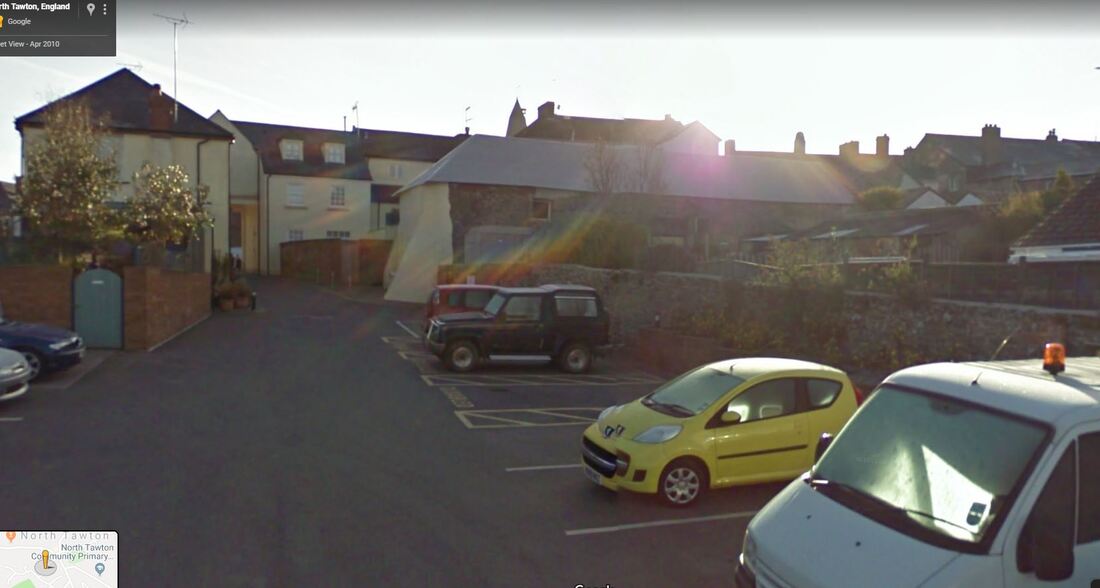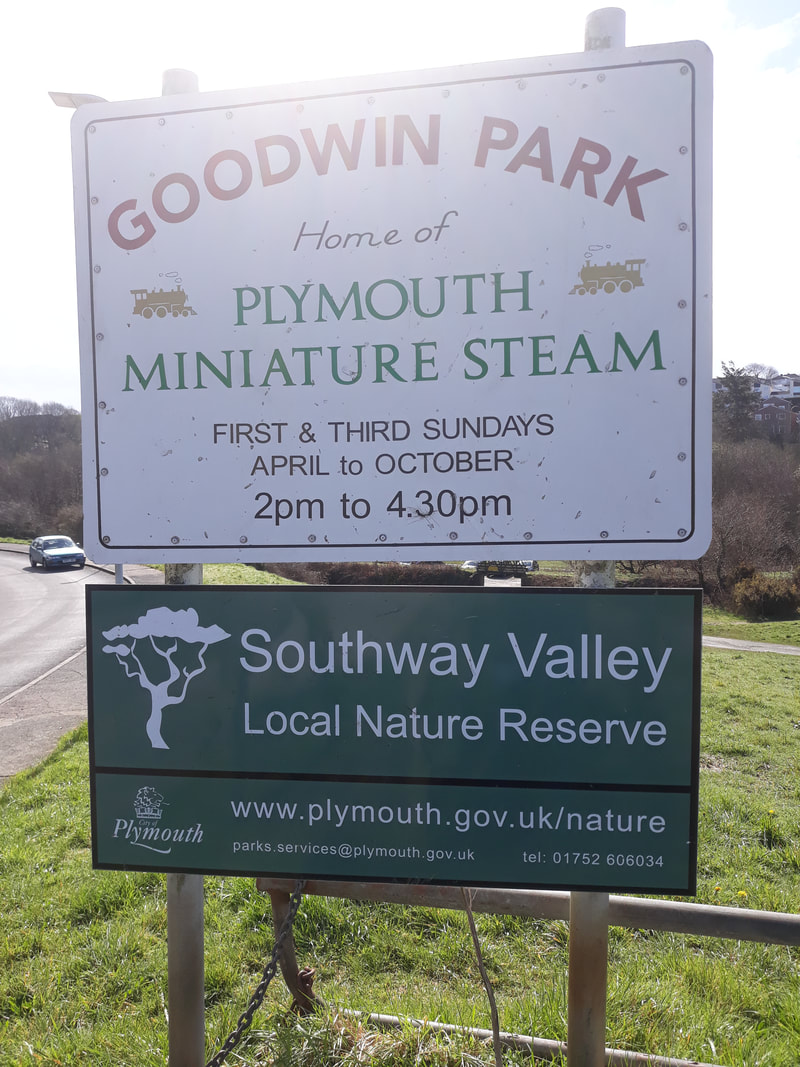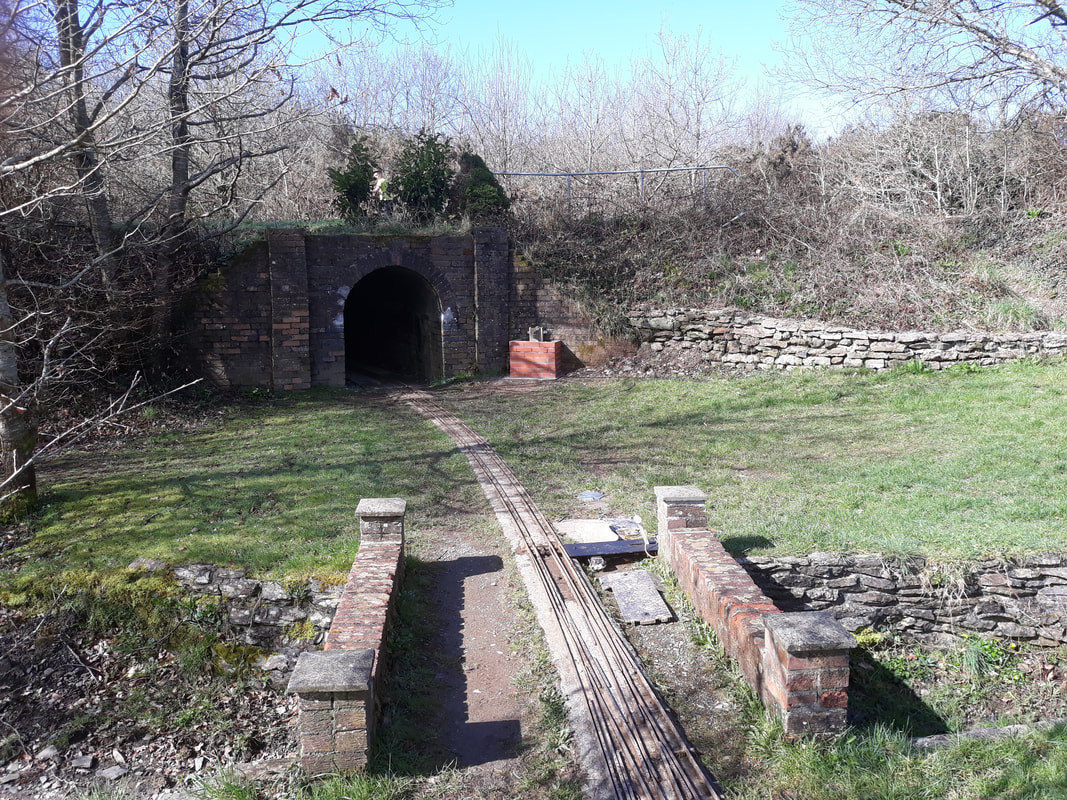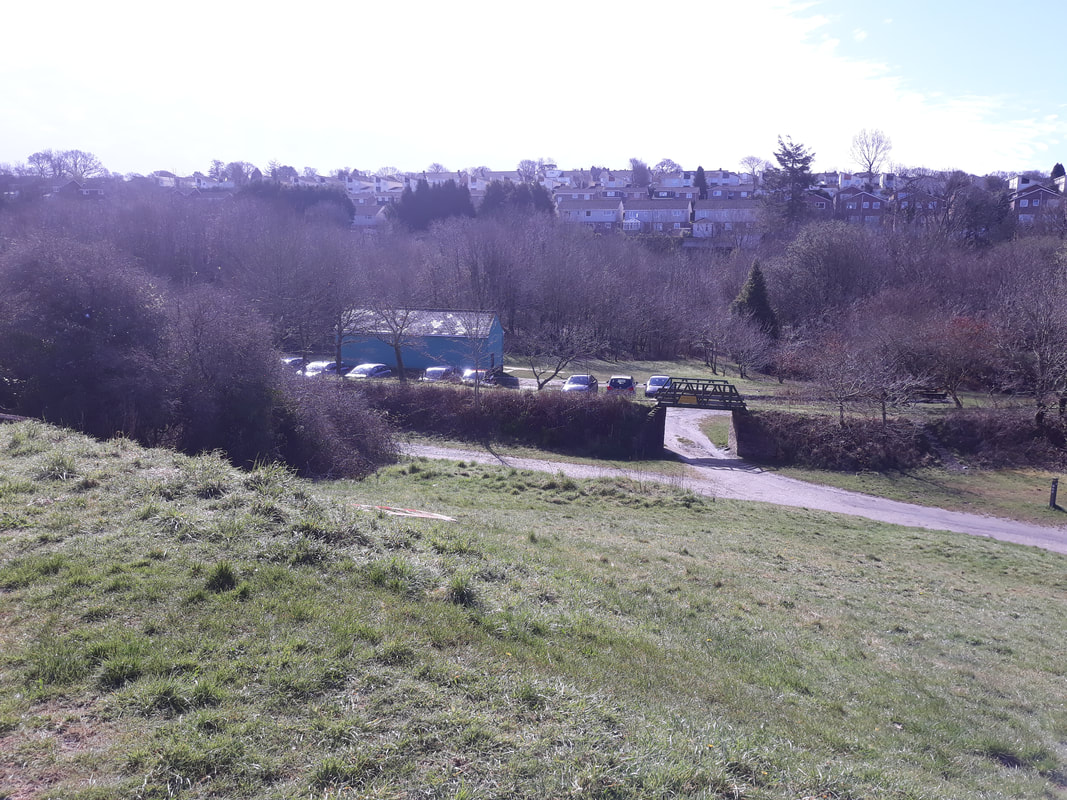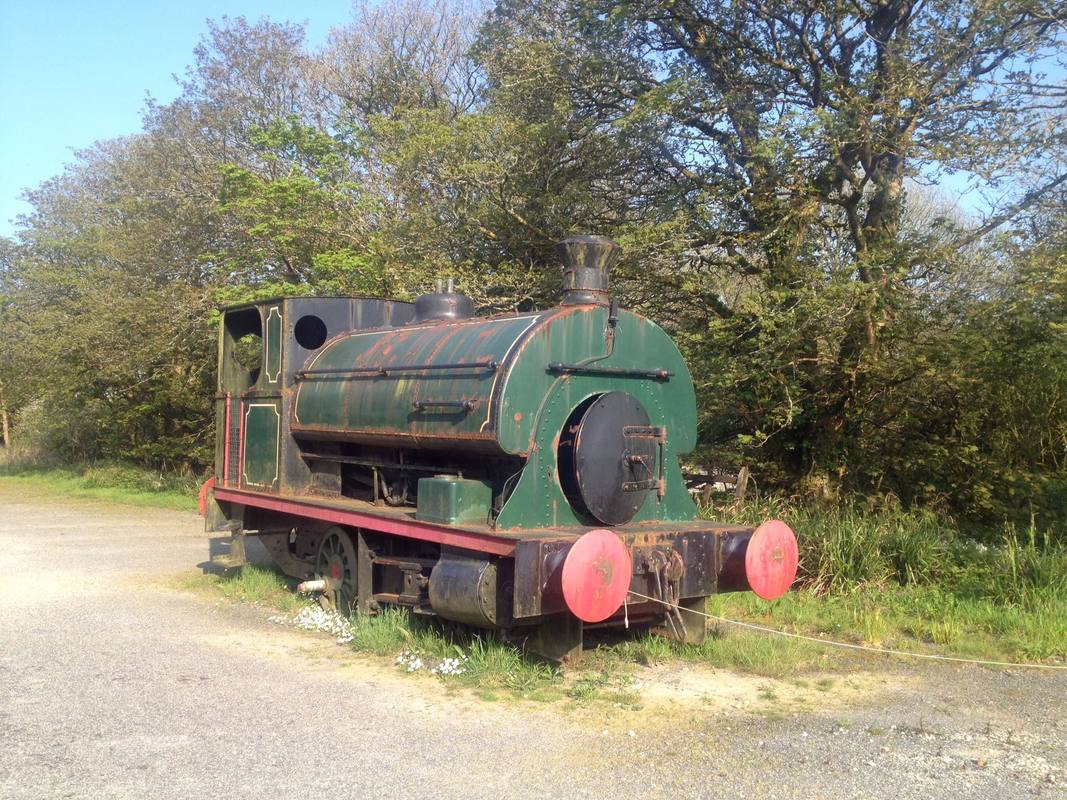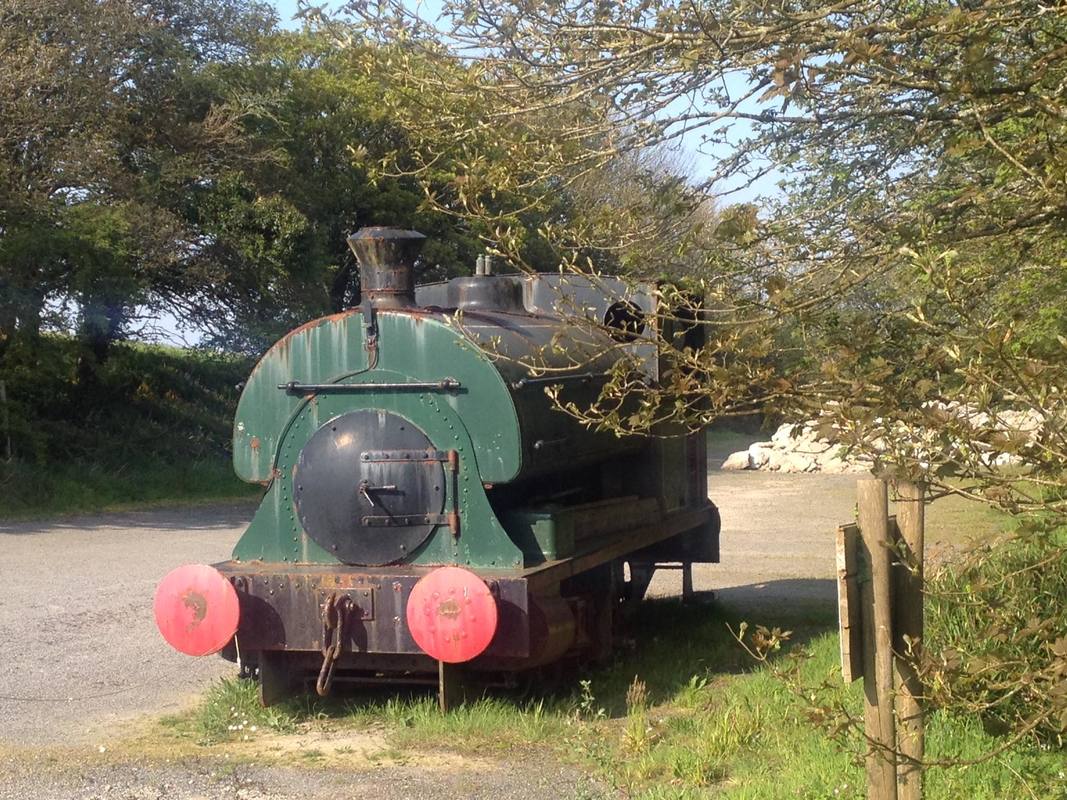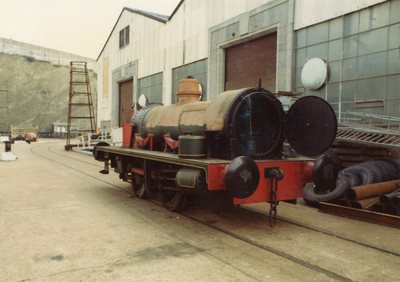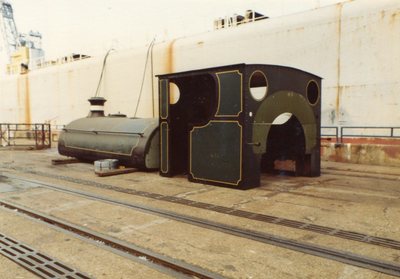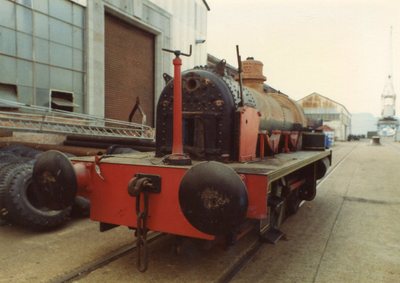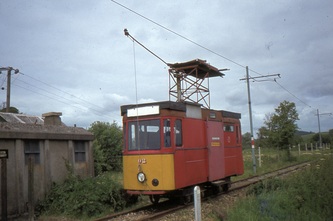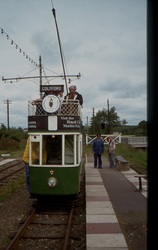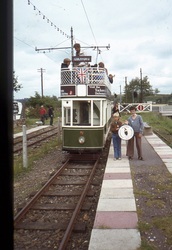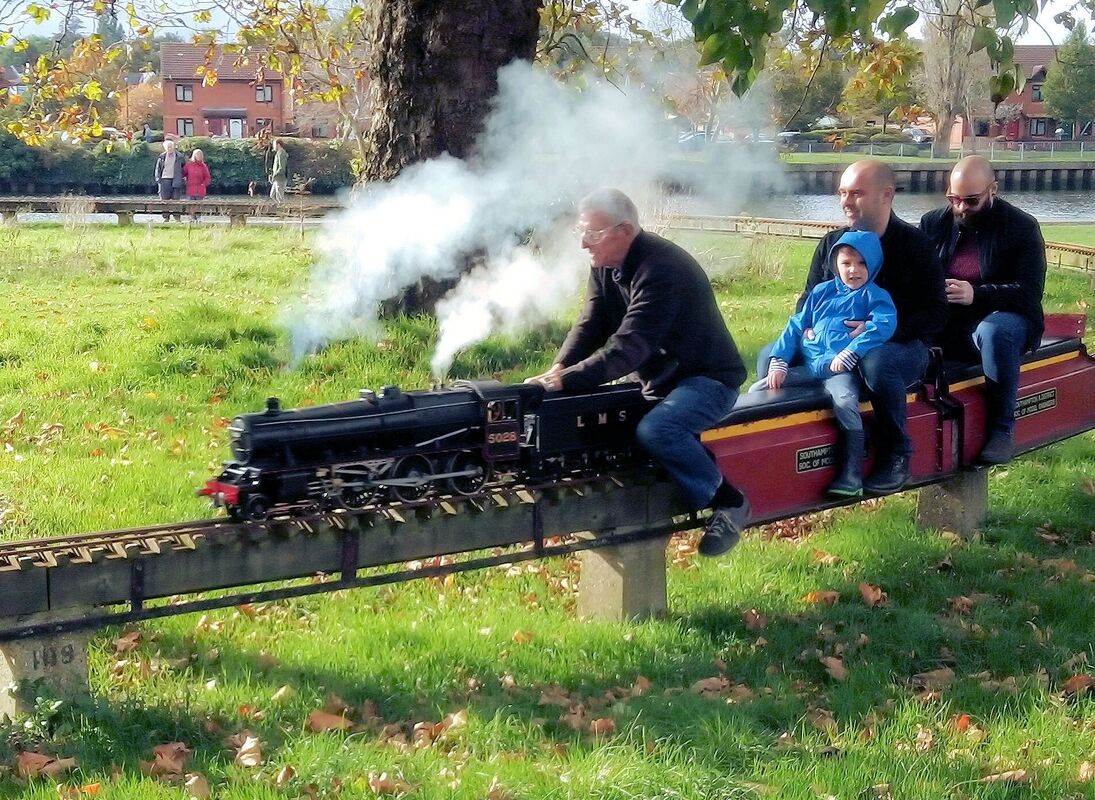Pleasure Tramways and Light Railways
Please note :-
All entries are in alphabetical order.
All entries are in alphabetical order.
Credits, Many thanks to all contributors - please see a list on the home page.
Bickington Railway
Andrew writes:- Whilst searching through my photograph library, I came across this one of the Bickington Steam Railway on the 3rd July 2013, situated outside Newton Abbot. The railway was built at the present site within the grounds of Trago Mills in 1988.
Constructed to a gauge of 10 and ¼, it is extensive and worth a visit.
The railway has quite a history, having originally been built by Brian Nicholson, the headmaster of Waterhouses School in Staffordshire. His intention was to relay part of the Leek and Manifold Light Railway, but for varying reasons the railway eventually ended up In Newton Abbot, having been recovered from Suffolk Wildlife Park.
D5910 in the photograph was built in 1987 based on the class 23, Baby Deltics, really a smaller version of the famous class 55 Deltics.
Regards, Andrew Jones. Many thanks indeed Andrew for your article and picture.
Constructed to a gauge of 10 and ¼, it is extensive and worth a visit.
The railway has quite a history, having originally been built by Brian Nicholson, the headmaster of Waterhouses School in Staffordshire. His intention was to relay part of the Leek and Manifold Light Railway, but for varying reasons the railway eventually ended up In Newton Abbot, having been recovered from Suffolk Wildlife Park.
D5910 in the photograph was built in 1987 based on the class 23, Baby Deltics, really a smaller version of the famous class 55 Deltics.
Regards, Andrew Jones. Many thanks indeed Andrew for your article and picture.
.Located at Trago Mills Regional Shopping Centre, Newton Abbot, the 10 1⁄4 in (260 mm) rideable miniature railway Bickington Steam Railway was opened in 1988, using equipment recovered from the Suffolk Wildlife Park, which itself was taken from Rudyard Lake. It was built by Brian Nicholson, the headmaster of Waterhouses School in Staffordshire. Waterhouses was the junction for the Leek and Manifold Light Railway. After being thwarted in an attempt to rebuild a portion of the Leek and Manifold Valley railway, Nicholson moved his railway, via Rudyard Lake and Suffolk, to Trago Mills.
Originally the railway was a 1 mile (1.6 km) double loop around two lakes with one station, 'Trago Central', but in 2006 the railway grew over 1⁄2 mile (805 m), with an extension taking it to Trago's front car park. A three-track terminus and turntable was built and named the 'Riverside Station'. A third station was added in 2008, located at the far end of the Trago site on one of the original sections of line; this was named 'Goose Glen Halt'. This was constructed in the hope that shoppers would use the ride to return to their vehicles, a near half-mile uphill walk from the main shopping complex.
The above courtesy Wikipedia
Originally the railway was a 1 mile (1.6 km) double loop around two lakes with one station, 'Trago Central', but in 2006 the railway grew over 1⁄2 mile (805 m), with an extension taking it to Trago's front car park. A three-track terminus and turntable was built and named the 'Riverside Station'. A third station was added in 2008, located at the far end of the Trago site on one of the original sections of line; this was named 'Goose Glen Halt'. This was constructed in the hope that shoppers would use the ride to return to their vehicles, a near half-mile uphill walk from the main shopping complex.
The above courtesy Wikipedia
Bicton Gardens Railway
Crowlas Age of Steam Was near Penzance - long since dismantled
Many thanks to Roger Winnen.
Exeter & District Model Engineering Society's, Engine shed and siding opening.
An article by Mick House with additional photos by David Tozer.
An article by Mick House with additional photos by David Tozer.
This is a Follow-up to the article published last Wednesday 30th August, New Railway Infrastructure at Exeter, by Dave Tozer.
I had the pleasure of attending the official opening of the Exeter & District Model Engineering Society's new shed and siding (photo 1MH), at the site of St Katherine's Priory a 12th century Benedictine Priory on Sunday 3rd September (photo 2MH). On arrival at around 11.00 I could see that it was going to be a popular event, as the car parking areas were pretty full, the event having opened an hour earlier, I was later told that the event attracted around 400 visitors. I was introduced to the Chairman Pete Hackney and was given all area's access to the site to photograph. I also spoke with Treasurer Samuel Woolley owner of one of the locomotives 0-4-0 Ajax (photo 3MH), taking passengers around. On the steaming bay being prepared to run is 4-6-0 4981 Abberley hall (photo 4MH). Also running passengers around was Southern 2-4-2 762 Lyn (photo 5DT), driven by Ces Courtney just pulling away from the station. A view of the site with lots of items of rolling stock to see, with two trains passing in the station to the left and the Priory on the right (photo 6MH), the line-up of rolling stock, with LMS 8F 8042 in the foreground (photo 7DT).In the Priory building itself they had a model railway exhibition (photos 8MH & 9MH) and catering (the homemade apple cake and clotted cream was excellent).Chairman Pete Hackney told me they applied to GWR Community Investment Fund for 2021/22 back in 2021 for funding of the materials to build the raised siding and engine shed tracks and to lay the slabs as at that point we only ran smaller 5" gauge engines as they can be brought to the track and taken away at the end of the day. Not so easy with 71/4". We have a club Sweet William 71/4" engines stored in a garage and carriages and of course wanted to run it, hence the application to GWR.
The time had come and Pete Hackney at around 12.15 invited the public to cross over the site for the opening ceremony of the Engine shed and siding (photos 10DT & 11DT), after a short speech by Pete he handed over to the three members of GWR Left to right, Ian Mundy GWR Senior Portfolio Manager, Matt Barnes GWR Head of Strategic Service Development who gave a speech and cut the ribbon and Mike Preece GWR Development Manager (photo 12MH). South Western Railways Class 159 001 passes above the New Engine shed (photo 13MH).
What happens next, as the line is just over 200 metres long and at this time only end to end running, when funds are available they want to bridge the gap so to speak and this they plan to do with a Viaduct the two ends of the line are already on embankments (photos 14MH & 15MH), Ariel view of St Katherine’s priory site (photo 16), courtesy of Google maps.
My thanks go to everyone involved on the day, Exeter & District Model Engineering Society's members and the GWR team; I wish them every success for the future.
I had the pleasure of attending the official opening of the Exeter & District Model Engineering Society's new shed and siding (photo 1MH), at the site of St Katherine's Priory a 12th century Benedictine Priory on Sunday 3rd September (photo 2MH). On arrival at around 11.00 I could see that it was going to be a popular event, as the car parking areas were pretty full, the event having opened an hour earlier, I was later told that the event attracted around 400 visitors. I was introduced to the Chairman Pete Hackney and was given all area's access to the site to photograph. I also spoke with Treasurer Samuel Woolley owner of one of the locomotives 0-4-0 Ajax (photo 3MH), taking passengers around. On the steaming bay being prepared to run is 4-6-0 4981 Abberley hall (photo 4MH). Also running passengers around was Southern 2-4-2 762 Lyn (photo 5DT), driven by Ces Courtney just pulling away from the station. A view of the site with lots of items of rolling stock to see, with two trains passing in the station to the left and the Priory on the right (photo 6MH), the line-up of rolling stock, with LMS 8F 8042 in the foreground (photo 7DT).In the Priory building itself they had a model railway exhibition (photos 8MH & 9MH) and catering (the homemade apple cake and clotted cream was excellent).Chairman Pete Hackney told me they applied to GWR Community Investment Fund for 2021/22 back in 2021 for funding of the materials to build the raised siding and engine shed tracks and to lay the slabs as at that point we only ran smaller 5" gauge engines as they can be brought to the track and taken away at the end of the day. Not so easy with 71/4". We have a club Sweet William 71/4" engines stored in a garage and carriages and of course wanted to run it, hence the application to GWR.
The time had come and Pete Hackney at around 12.15 invited the public to cross over the site for the opening ceremony of the Engine shed and siding (photos 10DT & 11DT), after a short speech by Pete he handed over to the three members of GWR Left to right, Ian Mundy GWR Senior Portfolio Manager, Matt Barnes GWR Head of Strategic Service Development who gave a speech and cut the ribbon and Mike Preece GWR Development Manager (photo 12MH). South Western Railways Class 159 001 passes above the New Engine shed (photo 13MH).
What happens next, as the line is just over 200 metres long and at this time only end to end running, when funds are available they want to bridge the gap so to speak and this they plan to do with a Viaduct the two ends of the line are already on embankments (photos 14MH & 15MH), Ariel view of St Katherine’s priory site (photo 16), courtesy of Google maps.
My thanks go to everyone involved on the day, Exeter & District Model Engineering Society's members and the GWR team; I wish them every success for the future.
With many thanks to Mick House for his detailed report and photographs and to David Tozer for the additional photographs.
Exmouth Miniature Railway
The miniature railway on the seafront, it's said the oldest in the country, having been there since 1949, was closed at the end of August and is to be torn up by East Devon District Council to make way for a water sports centre.
Exmouth Fun Park, in which the railway lies, was a much loved attraction and helped give a traditional feel to the resort. I remember riding on the train when it was steam powered and partly blame the little railway for giving me the itch. -- Colin Burges
The miniature railway is a 150 yard circle, with the shed doubling as a tunnel. I have just bid to buy the loco and coaches but was immediately outbid, so that's as far as I'm going. CB.
http://www.miniaturerailwayworld.co.uk/Exmouth.html
Exmouth Fun Park, in which the railway lies, was a much loved attraction and helped give a traditional feel to the resort. I remember riding on the train when it was steam powered and partly blame the little railway for giving me the itch. -- Colin Burges
The miniature railway is a 150 yard circle, with the shed doubling as a tunnel. I have just bid to buy the loco and coaches but was immediately outbid, so that's as far as I'm going. CB.
http://www.miniaturerailwayworld.co.uk/Exmouth.html
Many thanks to Colin.
Forest Railway at Dobwalls
The shed area of the Forest Railroad Dobwalls 1998
Andrew Triggs
Andrew Triggs
Thanks Andrew
Gorse Blossom Railway
Was near Newton Abbot. The Cornwall Railway Society paid a visit to this little line while on a coach trip in
Was near Newton Abbot. The Cornwall Railway Society paid a visit to this little line while on a coach trip in
Hayle Towans Railway
A party of enthusiasts visited this small line in August 74 - it was run by a gentleman by the name of Mr. Toms. The line of 10 1/4" gauge traversed a figure of eight route some of the line being in cutting. There was a short tunnel. By 1992, although disused and the track overgrown it was reported to be still intact. As can be seen the station sported a Camborne & Marazion station nameboards.
The Inny Valley Railway
Andrew Jones
Andrew Jones
Dear Keith and Valerie, Please find attached two photographs of the Inny Valley Railway, situated at Trebullet near Launceston. Diane was milk recording at the time and I went along for the ride, which often took us to some amazing places in the early hours.
Both photographs were taken in 1981 and I had forgotten all about them until checking through some paperwork and notes last week.
The railway was established by James Evans who built the private railway in 1968 to the gauge of 1 feet 10 ¾ in 1968.
Two steam locomotives were based at Trebullet, Velinheli built by Hunslet in 1886 and Sybil built by W.G.Bagnall in 1906, originally from Dinorwic Quarry.
On closure in 1987 both locomotives and a carriage were transferred to the Launceston Steam Railway.
Information about the railway is scarce, research online shows a visit by Plymouth Railway Circle in 1978 who travelled in a wagon fitted with old church pews!
Although only 400 metres in length, I remember there were some sidings which you can see in the photographs with a ground signal and a 10 mph speed limit, unfortunately the vegetation had taken over somewhat.
Does anyone have any memories or more photographs?
Best wishes Andrew and Diane
Both photographs were taken in 1981 and I had forgotten all about them until checking through some paperwork and notes last week.
The railway was established by James Evans who built the private railway in 1968 to the gauge of 1 feet 10 ¾ in 1968.
Two steam locomotives were based at Trebullet, Velinheli built by Hunslet in 1886 and Sybil built by W.G.Bagnall in 1906, originally from Dinorwic Quarry.
On closure in 1987 both locomotives and a carriage were transferred to the Launceston Steam Railway.
Information about the railway is scarce, research online shows a visit by Plymouth Railway Circle in 1978 who travelled in a wagon fitted with old church pews!
Although only 400 metres in length, I remember there were some sidings which you can see in the photographs with a ground signal and a 10 mph speed limit, unfortunately the vegetation had taken over somewhat.
Does anyone have any memories or more photographs?
Best wishes Andrew and Diane
Try this link for view of 'pew seat' train.
Inny Valley Railway - Wikipediahttps://en.wikipedia.org › wiki › Inny_Valley_Railway
Inny Valley Railway - Wikipediahttps://en.wikipedia.org › wiki › Inny_Valley_Railway
N.B. If you are registered for Flickr here is a link to a picture of the pew carriage. https://flic.kr/p/fCkZyv Many thanks Andrew.
Many thanks to Andrew and Diane Jones.
Isle Abbots
Miniature Railway
Miniature Railway
Hi Keith, I don't know whether you've heard of the Isle Abbots miniature railway.
A ten and a quarter inch gauge line, it runs for over a mile around fields of the owner MARTIN RICKITTS.
with a branch line off the main circuit up to the village hall. The Yeovil Railway Circle visited it
in August 2015 for an evening, riding the circuits and a very enjoyable time was had by all.
Isle Abbot is 6/7 miles east from Taunton, follow the Taunton to Langport road and turn off
to the right at Fivehead, Isle Abbots is a couple of miles from there out in the country.
Their are no set operating days or timetabled trains. They usually operate when there is an
event going on in the village, private visits can be arranged,as we did. A very interesting little rly. when we visited,they were marking out another loop extension to run behind the main house,
I've been told this loop has since been installed. enjoy cheers JOHN C.
This is a private railway.
A ten and a quarter inch gauge line, it runs for over a mile around fields of the owner MARTIN RICKITTS.
with a branch line off the main circuit up to the village hall. The Yeovil Railway Circle visited it
in August 2015 for an evening, riding the circuits and a very enjoyable time was had by all.
Isle Abbot is 6/7 miles east from Taunton, follow the Taunton to Langport road and turn off
to the right at Fivehead, Isle Abbots is a couple of miles from there out in the country.
Their are no set operating days or timetabled trains. They usually operate when there is an
event going on in the village, private visits can be arranged,as we did. A very interesting little rly. when we visited,they were marking out another loop extension to run behind the main house,
I've been told this loop has since been installed. enjoy cheers JOHN C.
This is a private railway.
Many thanks to John for this selection of his photographs.
Kingsbridge and District Light Railway
Clive Smith
Clive Smith
Some more narrow gauge fun, this time in Kingsbridge today (6th April 2018) The KDLR is now up and running for the season. Intermittently for now but a busy day was had in Thursday's fine weather taking over £100.
Regards Clive Many thanks Clive
Regards Clive Many thanks Clive
For further info please try this link :-
http://www.kingsbridge-today.co.uk/article.cfm?id=594&headline=Light%20railway%20reveals%20a%20new%20summer%20timetable§ionIs=news&searchyear=2015
http://www.kingsbridge-today.co.uk/article.cfm?id=594&headline=Light%20railway%20reveals%20a%20new%20summer%20timetable§ionIs=news&searchyear=2015
Kingsbridge Miniature Railway - Report for October 2018 Clive Smith
Things have been happening down in Kingsbridge since my last visit back in April. The railway took its 10,000th visitor in early August and building has commenced of its new Parkside station as seen in picture 3. Previously the line came to a stop at the end of The Embankment riverside path. Now the line curves in a 'u' (picture 2) to terminate at a new site that will be the Parkside station. Currently adjacent to this is the railway's 'shed'. I use this term loosely as wooden box would be more appropriate. This is where the railway keeps its regular rolling stock. Talking to the one of the members, I was told they plan to have the station built by this December complete with roof and platform. The shed will be no more, replaced by a purpose-built brick structure. Runnings will cease at the end of October but there are plans to run over the Christmas holidays when it is hoped the new station will be used.
Regards, Clive Smith. Many thanks Indeed Clive.
Things have been happening down in Kingsbridge since my last visit back in April. The railway took its 10,000th visitor in early August and building has commenced of its new Parkside station as seen in picture 3. Previously the line came to a stop at the end of The Embankment riverside path. Now the line curves in a 'u' (picture 2) to terminate at a new site that will be the Parkside station. Currently adjacent to this is the railway's 'shed'. I use this term loosely as wooden box would be more appropriate. This is where the railway keeps its regular rolling stock. Talking to the one of the members, I was told they plan to have the station built by this December complete with roof and platform. The shed will be no more, replaced by a purpose-built brick structure. Runnings will cease at the end of October but there are plans to run over the Christmas holidays when it is hoped the new station will be used.
Regards, Clive Smith. Many thanks Indeed Clive.
The Lappa Valley Railway
Pictures from Roger Winnen
The Lappa Valley Railway runs on a short section of the Chacewater to Newquay Branch from Benny Mill to near Mitchell & Newlyn Halt which closed on the 4th February 1964, The Lappa Valley line runs to East Wheal Rose Mine Station and skirts around the lake before heading back to Benny Mill. A 10.25 line also serves a separate branch line to Newlyn Downs Platform which is only a short distance from Mitchell & Newlyn Halt.
The
Launceston Steam Railway
Pictures from Peter Murnaghan
Launceston Steam Railway
Pictures from Peter Murnaghan
The Launceston Steam Railway is a 1ft 1 1/2inch railway operating from the town of Launceston in Cornwall. The railway is built on the trackbed of the North Cornwall Railway and runs for 2 1⁄2 miles (4 km) to Newmills, where there is a farm park.
Hi Keith,
I'm so pleased that you found my pictures of the Darjeeling locomotive to be of use.
As to the route of the Launceston Steam Railway, I found it a delightful line. Very friendly and relaxed - cab rides were allowed without hesitation - Lynn and I managed a brief ride in the cab of the Darjeeling loco during its run round at Launceston. The other end of the line, at New Mills is an extensive children's playground/adventure centre, so most family groups break their journeys there - we stayed on the train to return.
Here are a few more pics, for your info. No need to put them up on latest news, unless you really want to. The Darjeeling loco is, apparently the only one to have 'escaped' from India. It is no.19 of the 'B' class, so referred to as 19B. It went, originally to a site in USA, but was abandoned after a while, until Adrian Shooter, MD of Chiltern Railway and later, Vivarail, rescued it for his own garden railway. It is on loan the Launceston for August and September, but only operates a couple of trips - 1300 and 1400) on the day we were there - and generally it will be two days per week, but none, apparently next week.
The passenger stock is delightful - built, I understand, at the Launceston workshops. I hope these extra photos will help to provide a fuller coverage of this splendid little line within the Pleasure Light Railways section of the website.
Very best wishes,
Peter.
P.S. One this that I didn't say in the above note was that these locos ran in India without a tender. The coal was pile up in front of the cab, with several crew members employed to shovel it down onto the footplate and then into the fire. The tender is a much more recent addition.
Peter - Many thanks for your notes and photographs.
I'm so pleased that you found my pictures of the Darjeeling locomotive to be of use.
As to the route of the Launceston Steam Railway, I found it a delightful line. Very friendly and relaxed - cab rides were allowed without hesitation - Lynn and I managed a brief ride in the cab of the Darjeeling loco during its run round at Launceston. The other end of the line, at New Mills is an extensive children's playground/adventure centre, so most family groups break their journeys there - we stayed on the train to return.
Here are a few more pics, for your info. No need to put them up on latest news, unless you really want to. The Darjeeling loco is, apparently the only one to have 'escaped' from India. It is no.19 of the 'B' class, so referred to as 19B. It went, originally to a site in USA, but was abandoned after a while, until Adrian Shooter, MD of Chiltern Railway and later, Vivarail, rescued it for his own garden railway. It is on loan the Launceston for August and September, but only operates a couple of trips - 1300 and 1400) on the day we were there - and generally it will be two days per week, but none, apparently next week.
The passenger stock is delightful - built, I understand, at the Launceston workshops. I hope these extra photos will help to provide a fuller coverage of this splendid little line within the Pleasure Light Railways section of the website.
Very best wishes,
Peter.
P.S. One this that I didn't say in the above note was that these locos ran in India without a tender. The coal was pile up in front of the cab, with several crew members employed to shovel it down onto the footplate and then into the fire. The tender is a much more recent addition.
Peter - Many thanks for your notes and photographs.
The Moseley Collection
Redruth
A report by Andrew and Diane Jones
Redruth
A report by Andrew and Diane Jones
Dear Keith and Valerie,
With this glorious weather set to continue, I decided to pick up my passport and travel west to the wonderful Moseley Heritage Museum near Redruth.
Colin Saxton and his fantastic team of volunteers are busy recreating many aspects of life well known to children of the 50’s and 60’s.
Several model layouts are operated during your visit as well as amazing Meccano constructions only dreamt of in my childhood, (except in the window of Gamages department store in London at Christmas).
You can ride behind ex Crofty and Geevor battery locomotives on an ingenious circuit of the farm.
There is an exhibit of Standard and Broad gauge track which illustrates the potential of Brunels concept.
The site entrance is completely free of charge (donations are much appreciated) and is open on Thursday, Sunday and Monday afternoons.
Very best wishes Andrew and Diane
With this glorious weather set to continue, I decided to pick up my passport and travel west to the wonderful Moseley Heritage Museum near Redruth.
Colin Saxton and his fantastic team of volunteers are busy recreating many aspects of life well known to children of the 50’s and 60’s.
Several model layouts are operated during your visit as well as amazing Meccano constructions only dreamt of in my childhood, (except in the window of Gamages department store in London at Christmas).
You can ride behind ex Crofty and Geevor battery locomotives on an ingenious circuit of the farm.
There is an exhibit of Standard and Broad gauge track which illustrates the potential of Brunels concept.
The site entrance is completely free of charge (donations are much appreciated) and is open on Thursday, Sunday and Monday afternoons.
Very best wishes Andrew and Diane
Thank you to Andrew and Diane for visiting and writing this report. I must admit to hanging my had in shame at living barely two miles away from this this fabulous collection I have not visited it more frequently - it really is worth the effort and no expense to visit. Go back in time to your childhood - you'll be astonished. K.J. 5th August 2022.
Little Western Railway Trenance Park Newquay
Draft - Article and railway under reconstruction 2021
My Story of the Little Western Railway by Richard Curtis
Background of LWR
Built by Eric Booth in 1968 following his retirement from the Royal Air Force. The first and only locomotive in that year was the scale steam engine of an LMS Royal Scot. The season was the end of May until September. The days were long for Eric and his family especially in the summertime, but it was worth it when over 70,000 passengers enjoyed a ride on Cornwall’s oldest miniature railway.
In 2014 Eric took the decision to let go of LWR and ownership passed on to John Littlefield the owner of the beautiful crazy golf operated across the road from LWR. John had always admired the railway and in the late 80’s he even built his own line on the other side of Newquay at Tower Road. Unfortunately, this railway proved to be unsuccessful and after just one-year John shut it down and sold everything off, ironically to Eric for use at his other railway the Lappa valley.
Sadly, John passed away over the winter of 2015. His family continued to run the railway until they sold LWR back to Lappa valley over the summer of 2018. Then in November 2019 they agreed to sell the railway to me. I didn’t take over ownership of the railway until June 2020 which is where my story of owning my first railway starts, but it’s not the start of my story.
My background
I am a proud born and bred Newquay man, having grown up near the boating the lake in Trenance Gardens. Having an older sister has meant that I was riding LWR when I was just a babe in arms. having spent most of my summer holidays in the park and riding LWR whenever I could. I can remember riding behind the Royal scot, even though it did derail in front of the tunnel. I seem to recall that it was so much heavier than the Mardyke HST that the rails opened out due to poor sleepers and the locomotive ended up wedged in between the rails resulting in a crew coming out from lappa valley to come and put it back on. At the age of 6 it was fascinating to watch and looking back all I can now think of is, they were lucky it didn’t happen in the tunnel. I used to go to school just up the road from LWR and to get me to walk home I was often bribed with a ride on the train.
At the age of 14 I had to go on a week’s work experience, of course when I saw Lappa Valley on the list I jumped at the chance. They were very kind and even let me drive the engines on the run round a few times and helped put them to bed, even though I was mainly there to work in the shop, café and boating lake. I was then offered a summer job working in the café clearing tables and doing the dishes. My shift used to be 12-4 so I had great delight by going in early, helping at the station and then after my shift helping to put the engine to bed for the day. From there over the years, I’m proud to say I did every job that they could offer me until I ended up retail manager and in charge of railway operations. I did for a year get sent to LWR in 2009 to try and sort it out, which I did to the best of what materials I could get out of Eric. I look back at Lappa Valley as an excellent apprenticeship. After leaving LVR I worked at a hotel in Newquay making my way up to duty manager. I was doing this whilst trying to build a railway at Mawgan Porth. Sadly, there was one difficult individual on the parish council who caused a lot of trouble for the planning department at Cornwall Council and to this day the planning application still hasn’t been determined. Having waited nearly 4 years I decided I needed a backup plan just in case it doesn’t work out. I approached Lappa Valley and happily they agreed to sell me LWR.
Assessing the situation
Having had a walk around LWR I could see the rails was well worn with some rails just 1 foot long. Sleepers at random spacing set in a mostly pea gravel ballast with a mixture of weeds sat on a layer of mud. What hadn’t helped the track was over the winter of 2019/20 a section of the railway flooded. The track had floated, “ballast” washed away and then when the water had gone the track came back down out of alinement with gaps under the sleepers. It was far to dangerous to push a coach along it, let alone a train full of passengers. The next thing to be inspected were the bridges, these had completely failed. It was quickly becoming apparent that my original plan of fix it up for summer and do more work in the winter would never happen. So, the decision was taken to shut the railway for 2020 and rebuild it properly. By the time I’m finished all that will be left from the railway I bought is a tunnel and the Mardyke HST but even this need repairing.
When I purchased the railway there were for 4 rail types which were steel and aluminium rail some of which was the original from 1968. Aluminium rail from the closed 10 ¼ inch railway at Carloyn Bay, steel rail from Dobwalls and welded steel track panels from Mardyke.
This is the second time I have worked on the bridges, the first time in 2009. I had to replace the timber deck (made of old point sleepers from Newquay goods yard). Eric would only pay for treated pine so by 2020 these were well rotten, again! With the prospect of doing this again if I were to do the same, I decided a new design was needed.
The rolling stock was clearly desperately in need of a complete repaint and that was even before the bogies were checked over. Some coaches had bad dents in the ends and a buffer had come off – suggesting there had been a derailment. Having now spoken with regular users of the park they have confirmed it spent more time off the track than on it, to the point that some families had refused to ride the railway.
There was a second business that came with the railway albeit out of action for 10 years. It was a coin operated electric car track, which was accessed over the tunnel. The cars had been scrapped years ago, the electric turned off, tree roots coming through the tarmac and metal railings that were so rusty they had fallen over. It was obvious the amount of money needed to open this business again just wasn’t viable, but it did have a block built shed. The area of land it took up was also bigger than the eye would let you believe due to it being overgrown and littered with remains of fallen trees.
The station had lost a point years ago taking out the loop and making platform 2 a bay. The turntable’s wheels have failed and can barely move between the 2 roads of the shed let along do a rotation. The engine shed and tunnel doors have seen better days and needed replacing. The ticket office is so rotten the floor no longer forms part of the structure and the roof leaks.
The rolling stock consists of a 40-year-old Mardyke HST, a Romulus steam locomotive (a lovely engine to drive just not suitable for commercial work) and 3 sit in coaches.
N.B. Mardyke is based in Rainham Essex.
Moving forward
So, the first thing that was obvious for the railway to survive was to replace the entire track. The opportunity has been taken to standardise the rail. Brand new aluminium rail has been purchased from Moors Valley railway, the first-time new rail has been used since 1968. All the fixings including the fishplates are galvanised except for the fishplate bolts which are stainless steel. Along with brand new 2x3 inch tantalised timbers will see the railway in good fettle for a good number of years to come. Some of the ex-Carlyon bay rail is good enough for the new sidings and depot area I am going to build on the site of the electric car track.
A point is to be installed near the zoo which will access a new turntable, this will then give rail access to the block built shed and will become a workshop so for the first-time rolling stock can be repaired on site. In time there will also be a new running shed 10 meters x 3 meters alongside the workshop to house the growing fleet. This is being done for 2 reasons, the first is the station can flood in times of heavy rain fall due to the small outlet for the river that goes under the road. The second is it creates an interesting area to look at when riding the railway. With spare engines and coaches parked next to the zoo exit, this will be enticing children to pester their parents to ride the railway.
This will also give LWR for the first ample undercover space, currently the tunnel and the 2-road shed can store 2 locomotives and 4 coaches. The new depot will increase the storage to allow for the 8 coaches and 4 locomotives that will be arriving and still leave room for 5 more items of rolling stock up to 10ft long each. With this extra space visiting locomotives will be able to come to LWR which is another first., I’ve received a lot of messages and emails for this to happen which is encouraging.
Back to the bridges, the one by the zoo was very narrow at under one meter wide, so the new bridge is over twice the width giving an internal space of 2 meters. To do this the riverbanks have been widened and strengthened. The tunnel bridge has only had to be slightly widened to make both match. The bridges are made of H iron and channel (galvanised) they are strong enough to drive a large vehicle over let alone a miniature train, they will outlast me and I’m only 30. Thanks, must go to my dad for making these which he did in his garage - quite the achievement!
Whilst having the railway shut for this long it has allowed the time to install proper drainage and remove the old coin operated electric car track. The site has been landscaped and you would never know the car track was once there.
Whilst the digger was in half the track bed was cleared but due to width restrictions the other half was dug by hand, 30 tons of mud, weeds, clay and pea gravel were removed. Most of the track bed had not been built with a base layer of stone. Around half the track was laid straight on top of clay – no wonder the track was always rotting. Lorry loads of stone are now arriving it will take 30 tons of 40mm granite to complete the layer of subbase for the track bed. Once the track is laid 20mm granite chippings will be used for the top layer – this is all being moved by hand, again due to poor access around the site. A membrane has been laid under the ballast to give it a chance from becoming overgrown again by weeds. The track itself will be a great visual feature of the rebuilt LWR. The track should start to go down before Christmas.
Once the track is finished then the real fun can begin! There are new ¼ scale lower quadrant signals for the station, traditional signs will be placed around the station and the track. I always liked how Dobwalls had named the bridges, tunnels and sections of track so I plan to do the same. Again, this will give the passengers something to look at as they are going around. The rolling stock can then be brought down to the railway.
The Mardyke HST is staying but will be joined by another Mardyke engine based on a freelance shunter but using the same drive system as the HST. One day when I can get around to it the Royal Scot will return home following a full rebuild (having bought this direct from Eric in 2014). I’m also looking into buying a commercial steam locomotive to be used for school holidays (hopefully for 2021), it’s the only reason I bought the railway – to run steam!
The three coaches that came with LWR can hold 12 people but are also the heaviest coaches I’ve personally come across on a 7 ¼ inch railway. The locomotive uses most of its power to move these not the actual passengers. These coaches are really what caused the downturn for the railway. By only carrying 12 people it would take an hour and a half to move 120 people which in the busy afternoons in august is nothing like the numbers that visit the park. The thing is people aren’t prepared to wait that long for a train ride. Therefore, I have purchased 8 Cromar White sit-a-strides some of them coming from Dobwalls. This decision came about after looking at old postcards of LWR and seeing 4 sit-a-strides with around 30 people on them. So, I knew the locomotive could do the work. The plan is to run 6 coach trains when busy, the platform is to be extended to do this. This would result in the railway moving the same 120 people in 15 minutes!
Last of all within the planning application or the new depo there are also plans for a rebuilt station. This consists of a canopy over the platforms with a new ticket office built within the structure and the long-demolished signal box will be rebuilt but on the other side of the track as the original was too close to a passing train.
The reason for the canopy is mostly to draw people’s attention to the fact there is a miniature railway as the current station has the unfortunate look of a shed. With this it will also provide shade on a sunny day saving the seats from getting to hot and of course keeping the train dry when there is a rain shower.
This railway is a commercial business and needs to pay its way, but it will always be special to me and I’m prepared not to just spend the money on it but also dedicate my time. I want the people of Newquay to be as proud of it as I am and most importantly, I like to think Eric is looking down to see how his first railway is coming back to life.
Note from Richard Curtis 9th December 2021
Hello Keith,
I can quite understand where you are coming from. It’s an excellent and informed website and I know it takes a lot to look after it. As for managing time, I currently have no concept of what the date is or even what day of the week it is at the moment.
I’ve had a look and it’s lovely to see more information published about LWR, I feel due to its short length some people often overlook it. So thank you for taking time to show it off.
I’ll have to work on a site plan, as it’s something I will need occasionally over the next few years.
The trackbed now has all its base layer of ballast. I’ve included 2 photos of the station and the start of the new depo area, the gap in the ballast with a yellow X is for a new turntable.
This week I’ve started on the points. I’ve managed to save one point from the ‘old’ railway. The rail was good enough to use again but the sleepers and bolts were totally wasted. I then have to build 5 new points. I’m over half way on the first new point. I’m managing to make a point from scratch in 3 days by myself.
The railway will definitely be open for the Easter holiday 2021. Once the track starts going down I’ll be able to decide on a date.
That’s all the news I have for now. Take care and thanks again for your time.
I hope you and your family have a lovely Christmas.
If you ever have any questions, please don’t hesitate to ask.
Kind regards,
Richard
I can quite understand where you are coming from. It’s an excellent and informed website and I know it takes a lot to look after it. As for managing time, I currently have no concept of what the date is or even what day of the week it is at the moment.
I’ve had a look and it’s lovely to see more information published about LWR, I feel due to its short length some people often overlook it. So thank you for taking time to show it off.
I’ll have to work on a site plan, as it’s something I will need occasionally over the next few years.
The trackbed now has all its base layer of ballast. I’ve included 2 photos of the station and the start of the new depo area, the gap in the ballast with a yellow X is for a new turntable.
This week I’ve started on the points. I’ve managed to save one point from the ‘old’ railway. The rail was good enough to use again but the sleepers and bolts were totally wasted. I then have to build 5 new points. I’m over half way on the first new point. I’m managing to make a point from scratch in 3 days by myself.
The railway will definitely be open for the Easter holiday 2021. Once the track starts going down I’ll be able to decide on a date.
That’s all the news I have for now. Take care and thanks again for your time.
I hope you and your family have a lovely Christmas.
If you ever have any questions, please don’t hesitate to ask.
Kind regards,
Richard
The Little Western Railway - 2022
The story continued and almost complete - Richard Curtis
The story continued and almost complete - Richard Curtis
I emailed last year about my refurbishment of the little western Railway in Newquay.
I’m happy to report that despite not opening until May 2021 over 45,000 passengers enjoyed a ride on the railway which was nearly 4 times the numbers it was carrying before I bought the line. The new petrol locomotive ‘Linda’ built by Mardyke (who also built the HST in 1980) proved a great hit with everyone. Whilst waiting for my own steam locomotive to be finished Moors valley leant me the twin sister to my engine ‘Horton’ which was the first steam power in 5 years. The Romulus ‘Angkor Wat’ was sold due to its lack of power for day in commercial use (we parked Horton next to it which got a few laughs). The new overall station was the best thing I did. On days with showers it meant waiting passengers could stay dry, there were wet days that had better numbers than dry days. Everyone has said they love the station, we even managed to get the power turned back on. Many locals now find it amusing that the town’s miniature railway has a better station than the branch line. It has a staffed ticket office, a queue area with separate entrance and exit and 2 working platforms if required.
Then after a fantastic but busy year I took delivery of my steam locomotive ‘Ashleigh’ named after my future wife, I even used it to propose to her. The engine is painted in Caledonian railway blue, not to look like Thomas the tank but because the real Ashleigh has stottish family. Hopefully I’ll be able to run the first public trains with her over Easter. I say hope as the latest project is to build a depot around the back of the railway by the zoo. This has meant I’ve had to take the track up to the engine shed so Ashleigh is currently marooned in there. Planning permission was finally granted last week so the materials are on order and work should start in March. The depot will have a 3 road shed and 3 separate rooms within the building for various storage. The main reason for this is to house all the rolling stock as I have to much to currently store it all on site. 4 ex-Dobwalls coaches are currently having an overhaul (offsite), on the job list for those at the moment are new axles and bearing housings with metric bearings. Once complete for the summer the railway will then be able to run 6 coach trains at a time (with 2 as spares just incase) which should help with the busy afternoons in August. There’s always lots to be done on the to do list but I’m really hoping that this year I’ll be able to finally install the signals I bought and get some heritage signage to add to the overall experience.
Kind regards,
Richard
I’m happy to report that despite not opening until May 2021 over 45,000 passengers enjoyed a ride on the railway which was nearly 4 times the numbers it was carrying before I bought the line. The new petrol locomotive ‘Linda’ built by Mardyke (who also built the HST in 1980) proved a great hit with everyone. Whilst waiting for my own steam locomotive to be finished Moors valley leant me the twin sister to my engine ‘Horton’ which was the first steam power in 5 years. The Romulus ‘Angkor Wat’ was sold due to its lack of power for day in commercial use (we parked Horton next to it which got a few laughs). The new overall station was the best thing I did. On days with showers it meant waiting passengers could stay dry, there were wet days that had better numbers than dry days. Everyone has said they love the station, we even managed to get the power turned back on. Many locals now find it amusing that the town’s miniature railway has a better station than the branch line. It has a staffed ticket office, a queue area with separate entrance and exit and 2 working platforms if required.
Then after a fantastic but busy year I took delivery of my steam locomotive ‘Ashleigh’ named after my future wife, I even used it to propose to her. The engine is painted in Caledonian railway blue, not to look like Thomas the tank but because the real Ashleigh has stottish family. Hopefully I’ll be able to run the first public trains with her over Easter. I say hope as the latest project is to build a depot around the back of the railway by the zoo. This has meant I’ve had to take the track up to the engine shed so Ashleigh is currently marooned in there. Planning permission was finally granted last week so the materials are on order and work should start in March. The depot will have a 3 road shed and 3 separate rooms within the building for various storage. The main reason for this is to house all the rolling stock as I have to much to currently store it all on site. 4 ex-Dobwalls coaches are currently having an overhaul (offsite), on the job list for those at the moment are new axles and bearing housings with metric bearings. Once complete for the summer the railway will then be able to run 6 coach trains at a time (with 2 as spares just incase) which should help with the busy afternoons in August. There’s always lots to be done on the to do list but I’m really hoping that this year I’ll be able to finally install the signals I bought and get some heritage signage to add to the overall experience.
Kind regards,
Richard
Many thanks to Richard Curtis for both items - we wish you and the LWR every success.
New Loco - Class 91
Today (13th October 2022) at Little Western Railway we took delivery of a new locomotive, class 91 Swallow, 91001.
It will be the only time the class will ever be in Cornwall.
It was built by Mardyke Miniature Railways in 1991 and ran at Ness island railway, Inverness. Until being bought by Thompson park railway in Burnley in 2016. With its move to Cornwall it’s a well travelled locomotive, nearly the entire length of the UK.
This powerful diesel hydraulic, 8 wheel drive locomotive is a much needed boost to the fleet and will be put to work over October half term.
Lynton and Barnstable
Winter trains on the Lynton and Barnstable 2017 - Andrew Jones
Morwellham Mine Tramway
Mount Edgecombe
Woodlands Miniature Railway
Woodlands Miniature Railway
It's been a while since any light railways have featured in these pages but here's a new one and it's in Cornwall too.
A day out from Plymouth by boat to the 'Forgotten Corner' of Rame and Cawsand in south east Cornwall was going to be a totally railway free day for me but not so ! A walk along the coastpath to Cremyll took me through Mount Edgcumbe Country Park to catch the ferry across to Stonehouse in Plymouth and there in front of me was a railway albeit 5" gauge and not working. I'd never heard of it but the information display indicated the project started in 2017 and there has been running in 2018-19. The link I have included states that they intend to re-open on July 4th on Sundays and Thursdays until September but with no passengers allowed while pandemic restrictions apply.
Bus 34 from Plymouth Town Centre will take you to Admiral's Hard where the ferry across the river will land you at Cremyll. If you are driving up from Cornwall turn right at Trerulefoot.
The historic Royal William Yard with an abundance of food and drink venues is next to the ferry quay and an excellent lunch or afternoon tea can be had at the Orangery Garden Cafe at Mount Edgcumbe House. Another one for Roger to put on his 'to do' list.
Regards
Clive Smith 24th June 2021
https://merms.co.uk/
A day out from Plymouth by boat to the 'Forgotten Corner' of Rame and Cawsand in south east Cornwall was going to be a totally railway free day for me but not so ! A walk along the coastpath to Cremyll took me through Mount Edgcumbe Country Park to catch the ferry across to Stonehouse in Plymouth and there in front of me was a railway albeit 5" gauge and not working. I'd never heard of it but the information display indicated the project started in 2017 and there has been running in 2018-19. The link I have included states that they intend to re-open on July 4th on Sundays and Thursdays until September but with no passengers allowed while pandemic restrictions apply.
Bus 34 from Plymouth Town Centre will take you to Admiral's Hard where the ferry across the river will land you at Cremyll. If you are driving up from Cornwall turn right at Trerulefoot.
The historic Royal William Yard with an abundance of food and drink venues is next to the ferry quay and an excellent lunch or afternoon tea can be had at the Orangery Garden Cafe at Mount Edgcumbe House. Another one for Roger to put on his 'to do' list.
Regards
Clive Smith 24th June 2021
https://merms.co.uk/
Many thanks to Clive Smith for this item -it is well worth clicking on the link provided to see all the publicty and take a ride on the line. Have a good day.
North Tawton
Miniature Railway
Miniature Railway
An Extract from Miniature Railways by Robin Butterell 1967 5 Shillings Ian Allan
This line existed in the 1950’s and 1960’s and possibly later. This 10 ¼ inch gauge line was operated by Mr Maurice Densham on his estate at North Tawton near Okehampton. It opened in 1952 with stock from the Surrey Border & Camberley Railway. Later it had two large diesel locos, one of which went to the Exmouth Miniature Railway (swapped for their Curwen 0-4-2).The length of the line is given as 1206 yards, including sidings. A 4-6-2 Steam engine locomotive is under construction which will have a tender specially design with low level seating to enable the driver to actually look through the cab windows. The layout is interesting in that it will be eventually fully controlled from a signal box of 29 levers. Signalling is of upper and lower quadrant and two or three sspect coloured light signals. Points are not more than 75 yards from the box are worked by heavy wire rope with spring return. Experiments are also being carried out to ascertain the best method of operating more distant points, and a complete switch board showing all track circuits and signal repeaters is also under construction.
If anyone can provide further information on the this fascinating little line it would be very much appreciated. We have been unable to find any track plans or even a sketch of the route. Where was the terminus in North Tawton – a Church building appears in one of the photographs. The date of Peter Dales, 4th May1968 is also significant as it was the last day on which main line services called at North Tawton station.
There are two other pictures of the line and these can be found on Flickr please use the link below. https://www.flickr.com/photos/141326567@N03/with/27707028835/
This line existed in the 1950’s and 1960’s and possibly later. This 10 ¼ inch gauge line was operated by Mr Maurice Densham on his estate at North Tawton near Okehampton. It opened in 1952 with stock from the Surrey Border & Camberley Railway. Later it had two large diesel locos, one of which went to the Exmouth Miniature Railway (swapped for their Curwen 0-4-2).The length of the line is given as 1206 yards, including sidings. A 4-6-2 Steam engine locomotive is under construction which will have a tender specially design with low level seating to enable the driver to actually look through the cab windows. The layout is interesting in that it will be eventually fully controlled from a signal box of 29 levers. Signalling is of upper and lower quadrant and two or three sspect coloured light signals. Points are not more than 75 yards from the box are worked by heavy wire rope with spring return. Experiments are also being carried out to ascertain the best method of operating more distant points, and a complete switch board showing all track circuits and signal repeaters is also under construction.
If anyone can provide further information on the this fascinating little line it would be very much appreciated. We have been unable to find any track plans or even a sketch of the route. Where was the terminus in North Tawton – a Church building appears in one of the photographs. The date of Peter Dales, 4th May1968 is also significant as it was the last day on which main line services called at North Tawton station.
There are two other pictures of the line and these can be found on Flickr please use the link below. https://www.flickr.com/photos/141326567@N03/with/27707028835/
Further information on the
North Tawton Miniature Railway
Jon Gough
North Tawton Miniature Railway
Jon Gough
John Gough writes :- With regard to your recent article regarding the North Tawton Railway I believe that the location where the photographs are taken is now the car park opposite the clock tower in the high street.
The roof lines, windows, chimneys and church tower of St Peters church can be seen to match between the now and then images.
The low level building in the foreground although re-roofed is clearly the same structure.
Where the route of the railway ran from here is of course still a mystery!
Regards, Jon Gough.
Many thanks Jon - Looking further at the Google Earth view - it would seem that the railway exited the terminus on a wsw bearing. As Jon says beyond that we haven't a clue where the railway went though having crossed what is now Butts Way on the housing estate perhaps the railway skirted the boundary of a large field and returned to the terminus. Perhaps somebody will remember!
The roof lines, windows, chimneys and church tower of St Peters church can be seen to match between the now and then images.
The low level building in the foreground although re-roofed is clearly the same structure.
Where the route of the railway ran from here is of course still a mystery!
Regards, Jon Gough.
Many thanks Jon - Looking further at the Google Earth view - it would seem that the railway exited the terminus on a wsw bearing. As Jon says beyond that we haven't a clue where the railway went though having crossed what is now Butts Way on the housing estate perhaps the railway skirted the boundary of a large field and returned to the terminus. Perhaps somebody will remember!
Newquay Trenance Park Railway
See Little Western Railway
See Little Western Railway
Plymouth Miniature Railway
Clive Smith
Clive Smith
For official Website please click here :- https://plymouthminiaturesteam.co.uk/
Poldark Mine
It was understood in early 2018 that the ex Devonport Dockyard Shunter which has been outstationed at St Agnes for a number of years was going to be moved for restoration to Poldark Mine. Let's hope that this comes about soon and that together with the Ex Falmouth loco an interesting railway collection is established.
Number 6 under repair at Falmouth Docks in 1996. Copyright David Hibberd.
Seaton Tramway
https://www.alrs.org.uk/site/
Riverside Park is about half a mile from St Denys station or a mile from Swaythling station. Here you will find, in a very pleasant location alongside the River Itchen the home of the Southampton Society of Model Engineers.
There are two circuits one of 7" gauge, the other of 10" gauge. On operating days trains are very frequent. For details and an aerial view of the railway please click here.
There are two circuits one of 7" gauge, the other of 10" gauge. On operating days trains are very frequent. For details and an aerial view of the railway please click here.
Vobster Light Railway
Details on this short lived line can be found at the very end of our section on the Bristol and North Somerset Railway.
